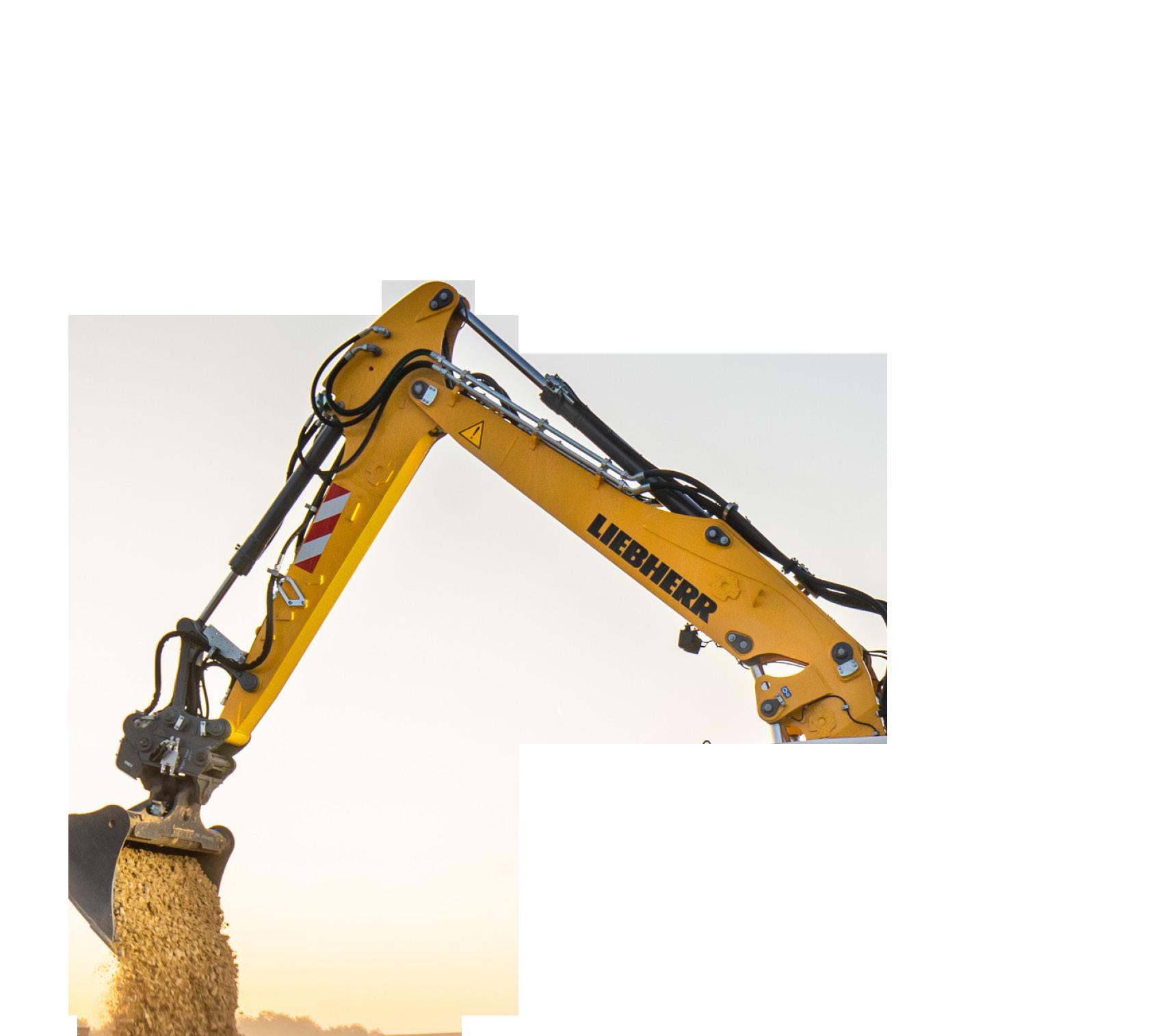
NAVIGATE YOUR POSSIBILITIES WITH AFTERMARKET GPS
INTEGRATING GPS OR GNSS TECHNOLOGY AFTERMARKET IS ACHIEVABLE AND CAN PROVIDE MANY BENEFITS TO CONTRACTORS, WORKERS AND MACHINES.
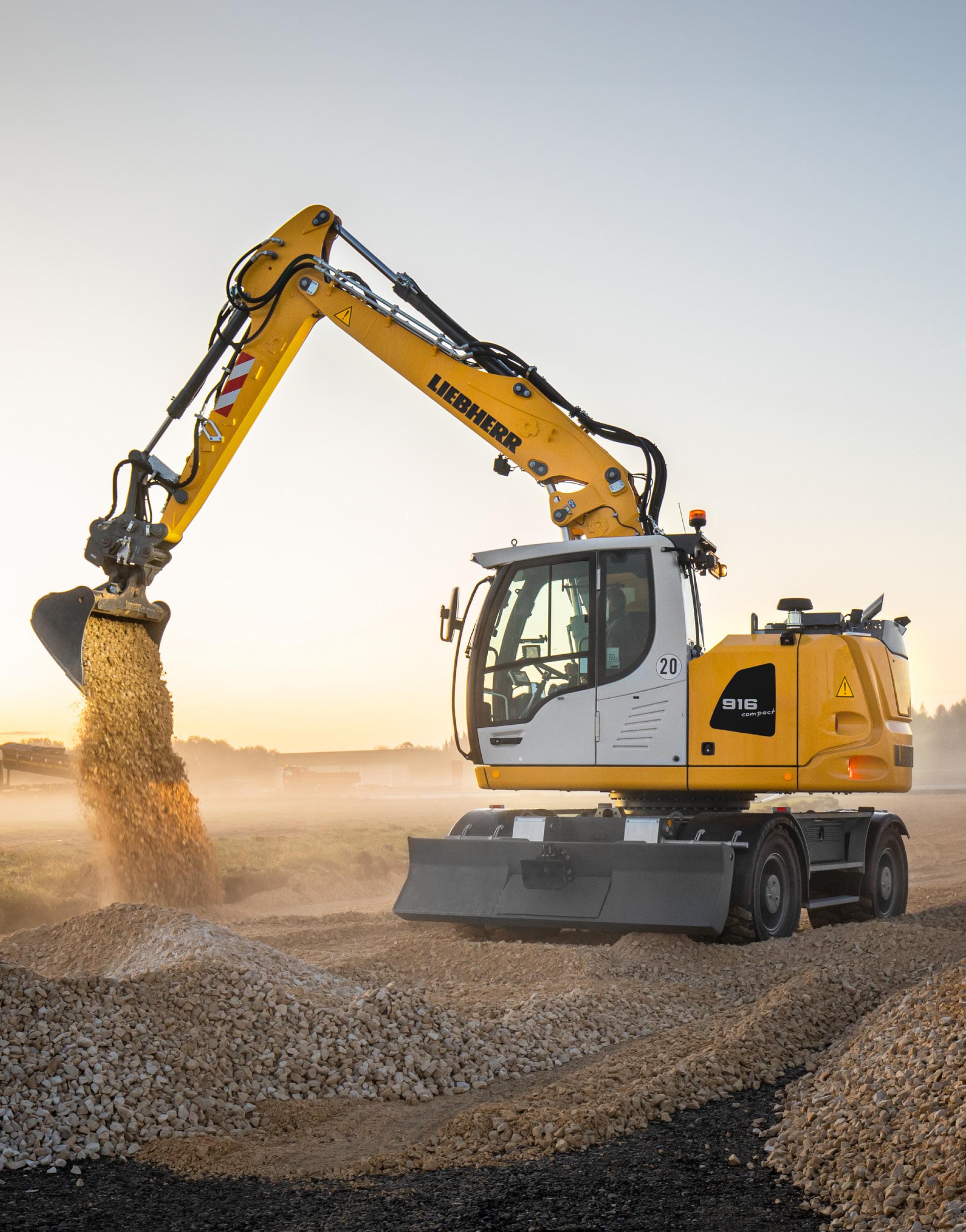
WHY WHEELED EXCAVATORS?
BENEFITS INCLUDE SIMPLIFIED TRANSPORT, DECREASED MAINTENANCE AND VERSATILITY.
Steps can be taken to protect people and equipment on sites. #1 Market Leaders
Liebherr

MADE FOR AMERICA | SERVICE THAT’S LOCAL EASY TO OWN, EASY TO OPERATE | BUILT TO ENDURE
LOADED IS THE NEW STANDARD * Warranty applies to 2024 Excavator models only. sanyamerica.com ™ ©2024 SANY America Inc.
FULLY

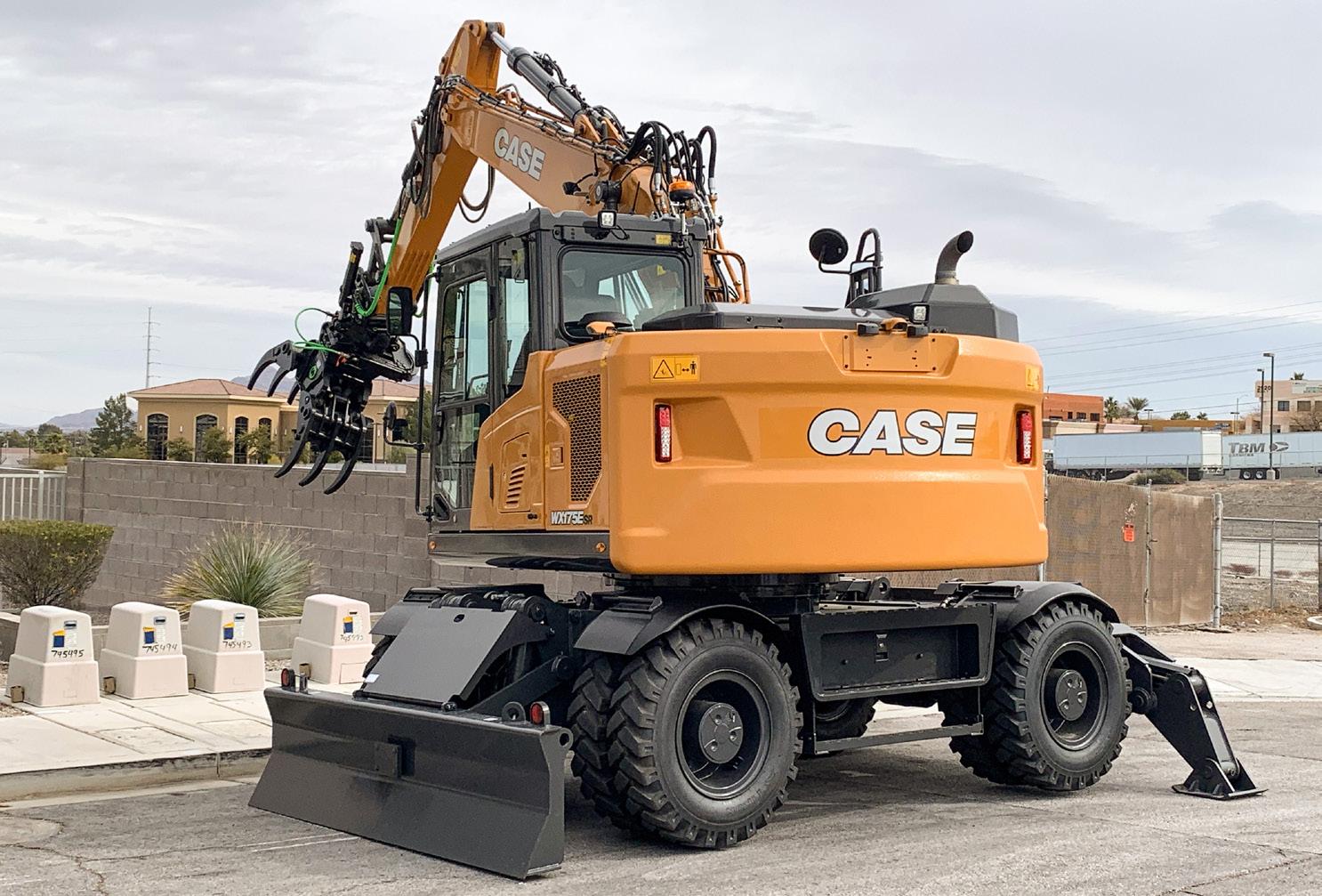
FEATURES
EQUIPMENT MANAGEMENT
26 OPTIMIZING & DESIGNING ENGINES FOR THE FUTURE
29
HOW TO PREPARE EQUIPMENT FOR SUMMER EXTREMES
From operator health to equipment maintenance, steps can be taken to protect the assets and people on construction sites.
As construction navigates the adoption of new technologies and changes in regulations, manufacturers are optimizing diesel engine architecture to support future technology innovations.
30 THE EVOLUTION
OF CONSTRUCTION TIRE INNOVATIONS
Having tires that can adjust to new conditions without diminishing the quality of performance is crucial to overcoming obstacles and staying on schedule.
TECHNOLOGY
34 SMALL SITE CONTRACTORS CASH IN ON CONSTRUCTION TECH
With the growing number of options for small site contractors to invest in technology, the decision about where to begin can be another significant hurdle.
36 SENSORS, CONNECTIVITY & AI: THE BUILDING BLOCKS TO A SAFER, MORE PRODUCTIVE WORKSITE
As we look to the future, we can expect to see AI-powered robots and automated machinery performing repetitive tasks on the jobsite, such as digging trenches, moving earth, or building brick walls with great precision.


HOW WHEELED EXCAVATORS COME IN HANDY ON THE JOBSITE
Wheeled excavators tout a number of benefits, from simplified transport, decreased maintenance and can be used in a variety of applications, from digging and craning. to vegetation management.
THE VERSATILITY OF WHEELED EXCAVATORS IN MODERN CONSTRUCTION
Compact wheeled excavators represent the future of construction, showcasing how technology enhances efficiency on the jobsite.
SPECIAL SECTION: AFTERMARKET GPS & MAINTENANCE
14
8 NAVIGATE YOUR POSSIBILITIES WITH AFTERMARKET GPS
Integrating GPS or GNSS technology aftermarket is achievable and can provide many benefits to contractors, workers and machines.
REVOLUTIONIZING CONSTRUCTION: THE ART OF EQUIPMENT CARE
18 MAXIMIZE TELEMATICS DATA WITH EQUIPMENT MAINTENANCE PROGRAMS
Powerful maintenance management software complements telematics by providing a centralized place to collect data from multiple sources and put it to work.
SPECIAL SECTION: COMPACT TRACK LOADERS
20
COMPACT TRACK LOADERS: BENEFITS & CHALLENGES
Is a CTL right for your business? Understand the advantages, drawbacks and machine capabilities.
Diagnostic tools upgrade PMs. FOUR REASONS TO ADD A LARGE COMPACT TRACK LOADER TO YOUR FLEET
Selecting the right compact equipment and attachments is crucial for optimizing ROI and boosting profits on jobsites.
www.ForConstructionPros.com April/May 2024 | EQUIPMENT TODAY 3
16 22 12
www.forconstructionpros.com/equipment April/May 2024 | Vol. 60 No. 4
WEB EXCLUSIVES PREMIUM CONTENT https://eqtoday.co/9pd73s DIGGING DEEPER PODCAST https://eqtoday.co/s7sfkm VIDEO NETWORK https://eqtoday.co/k2p285 COVER SERIES: EXCAVATOR INNOVATIONS Published and copyrighted 2024 by IRONMARKETS. Equipment Today makes every effort to report manufacturers’ product news accurately, but is not responsible for validity of news claims. All rights reserved. No part of this publication may be reproduced or transmitted in any form or by any means, electronic or mechanical, including photocopy, recording or any information storage or retrieval system, without written permission from the publisher. SUBSCRIPTION POLICY: Individual subscriptions are available without charge in the U.S. and Canada to management, engineering, supervisory, equipment maintenance and other personnel who have buying influence in the construction equipment industry. Subscribe online at www.ForConstructionPros.com. Publisher reserves the right to reject non-qualified subscribers. One year subscription to non-qualified individuals: U.S. $50; Canada/Mexico $70; all other countries $100 (payable in U.S. funds, drawn on U.S. bank). Single copies available (prepaid only) $10 each (U.S., Canada & Mexico), $15 each (International). For change of address or subscription information call (847) 559-7598 or fax (847) 291-4816. Equipment Today (USPS 369-290, ISSN 0891-141X) is published is published 11x with issues of January, February, March, April/May, June, July, August, September, October, November, December by IRONMARKETS, 201 N. Main St. Ste 350, Fort Atkinson, WI 53538. Periodicals postage paid at Fort Atkinson, WI, and additional entry offices. POSTMASTER: Please send change of address to Equipment Today, PO Box 3605, Northbrook, IL 60065-3605. Printed in the USA. 8 32 3 LESSONS FROM THE “FLYWHEEL EFFECT” While the flywheel effect involves considerable upfront exertion, the resulting momentum can sustain a business and keep it moving with less effort applied to routine maintenance over time. BUSINESS
Contents


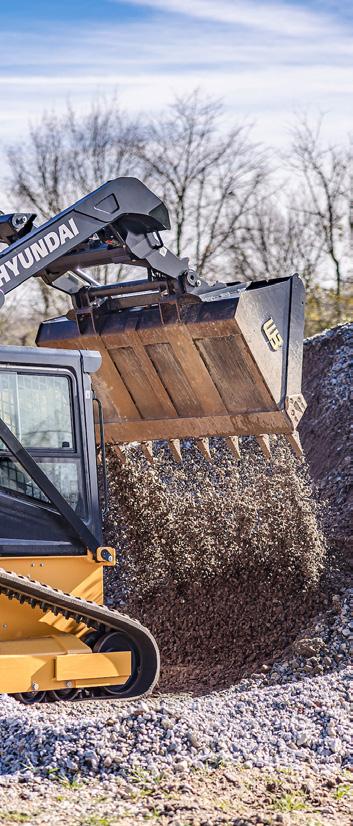
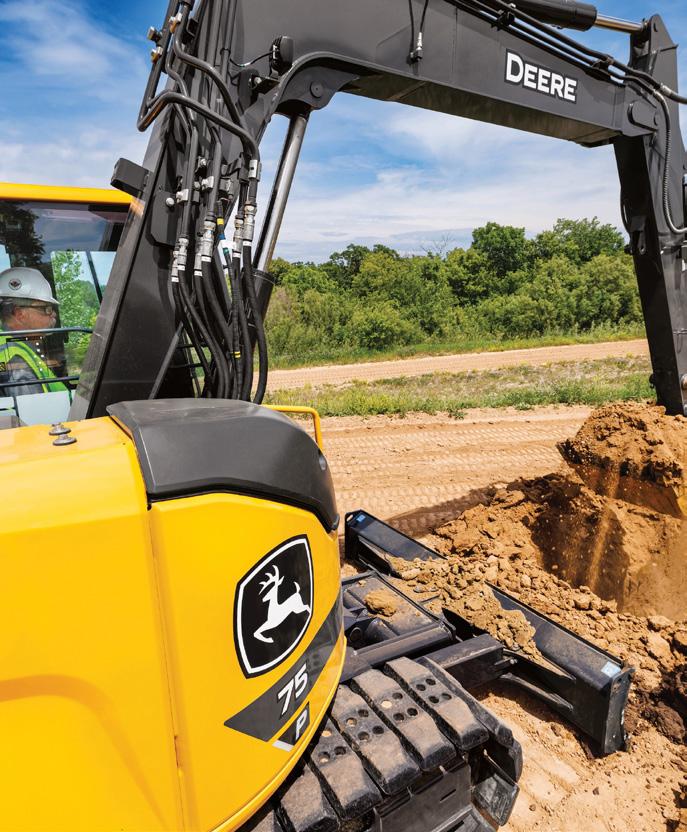



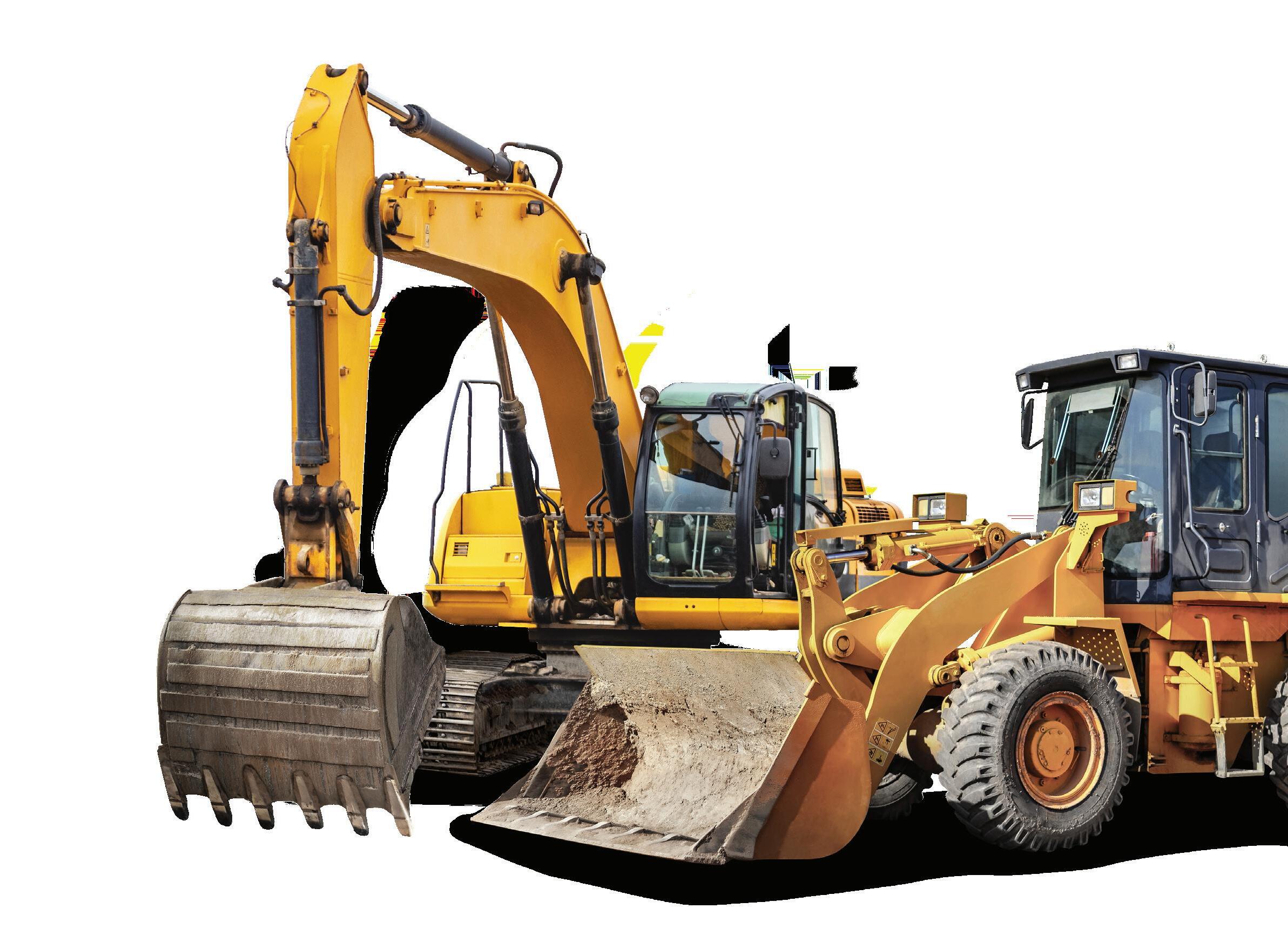



UNSURE ABOUT YOUR NEXT BIG PURCHASE? Brought to You By: IRONPROS has what you need: Scan Here! NEW PRODUCT PAGES Bringing you through a funnel of research, insight and comparison. HOW IT WORKS? Provides the Right Questions to Ask Description of the Product & Use Cases Pros and Cons of Renting vs. Buying Applicable Add-Ons DEPARTMENTS 5 BREAKING GROUND Diversity & Inclusion Can Bring Operators to the Industry 6 EQUIPMENT INTROS The Latest in Heavy Equipment 40 DENNIS IN THE DIRT Eliminate Rework With Equipment & Technology 42 CONSTRUCTION CONNECTIVITY Simple Construction Apps to Solve Common Problems 47 RUNNING THE BUSINESS Potential Money for You 44 LUBRICATION NUTS & BOLTS Getting the Viscosity Right – The Fleet Owner’s Guide 49 BRIDGING THE GAP How to Overcome Workforce Challenges in 2024 PRODUCT ROUNDUPS 24 38 COMPACT TRACK LOADERS TECHNOLOGY 10 40 44 26 20 14

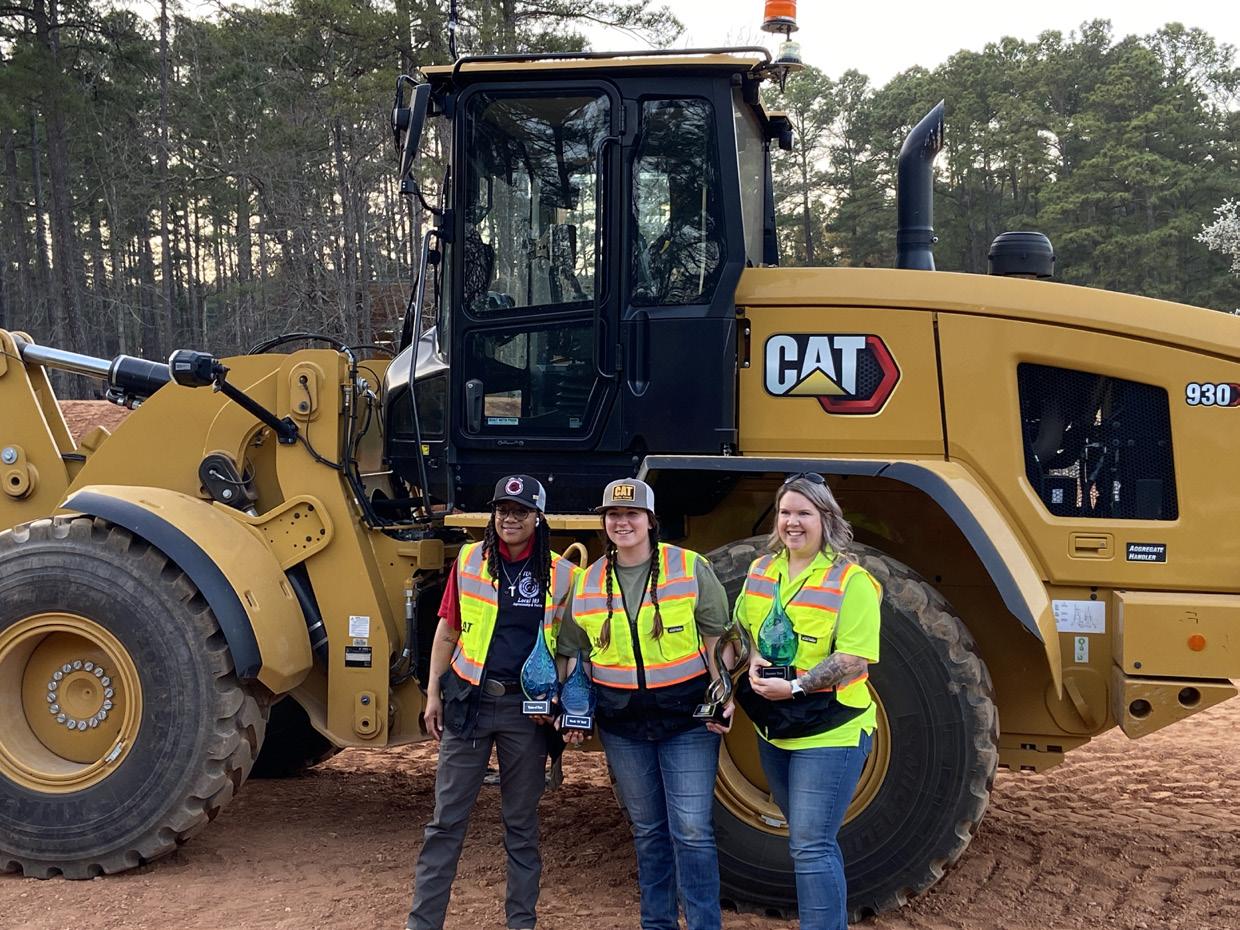
Diversity & Inclusion CAN BRING OPERATORS TO THE INDUSTRY
As the industry navigates the continuing workforce shortage, looking to untapped demographics may help add operators and other personnel to the jobsite. In Clayton, North Carolina, at its Edward J. Rapp Customer & Training Center, Caterpillar celebrated women in the construction industry. Our team was thrilled to be there and share two days of learning, networking and equipment operation.
because of the influence of family members who were working on jobsites, including Kenzi Tackette. Tackette had several family members who worked in construction. However, she was the only woman from her family in the industry and started her work while still in high school.
Tackette works for Beaver Excavating in Canton, Ohio. “I’ve worked in landfills mostly, building the cells to hold waste, but they do a variety of work from small jobs like substation pads to highways and schools,” Tackette said.

Operator Panel
On Day 1, several operators took to the stage for a panel discussion. These women discussed everything from how they entered the construction industry, any challenges they faced and what they love best about their jobs. Many started in construction
Al Little with Milton Cat in New England began working with her father and has been in her role for 10 years. She had not seen women working in the industry and said that seeing women in these roles helps and builds a community.
Some of the challenges that several of the panelists said they faced included:
˜ A lack of mentorship: Belittlement versus education and support
˜ The pressure to be perfect and not make mistakes or the need to do more because they are women
˜ Handling negative comments from coworkers
˜ Maternity leave isn’t paid ˜ Proving to other women that they can also do it
The Competition
On Day 2, 18 women competed in three skills tests. The skills tests were:
˜ Rock & Roll: Small wheel loader (the winner was Kait Burds)
˜ Hammer Time: Compact track loader (the winner was Kenzi Tackette)
˜ Tons of Fun: Small hydraulic excavator (the winner was Azaria Biven)
The overall winner, Burds, has been in the industry for several years. She also won the wheel loader competition.
“I feel really good; the competition was pretty stiff. It’s a good affirmation of the hard work I put into my career,” said Burds.
Use the QR codes below to learn more about the event and Tackette’s journey.
Read more about the event: eqtoday.co/WomenConst
Read more about Tackette’s journey eqtoday.co/TacketteQA



Lori Ditoro Editor-in-Chief Equipment Today lditoro@iron.markets E @EquipmentToday D @EquipmentToday C @equipment-today-magazine-official Q @equipmenttoday EDITORIAL Editor-in-Chief Lori Ditoro lditoro@iron.markets Managing Editor Gigi Wood gwood@iron.markets Senior Editor, Equipment & Workwear, IRONPROS Michael Cheng mcheng@iron.markets Junior Editor Merina Shriver mshriver@iron.markets AUDIENCE Audience Development Manager Angela Franks PRODUCTION Senior Production Manager Cindy Rusch crusch@iron.markets Art Director Kimberly Fleming kfleming@iron.markets ADVERTISING/SALES Brand Director Sean Dunphy sdunphy@iron.markets Brand Manager, OEM & Construction Nikki Lawson nlawson@iron.markets Sales Representative Kris Flitcroft kflitcroft@iron.markets Sales Representative Patty Maroder pmaroder@iron.markets Sales Representative Megan Perleberg mperleberg@iron.markets IRONMARKETS Chief Executive Officer Ron Spink Chief Revenue Officer Amy Schwandt VP, Finance Greta Teter VP, Audience Development Ronda Hughes VP, Operations & IT Nick Raether VP, Demand Generation & Education Jim Bagan Corporate Director of Sale Jason DeSarle Brand Director, Construction, OEM & IRONPROS Sean Dunphy Content Director Marina Mayer Director, Online & Marketing Services Bethany Chambers Director, Event Content & Programming Jess Lombardo CIRCULATION & SUBSCRIPTIONS PO Box 3605 Northbrook, IL 60065-3605, Phone: (877) 201-3915 Fax: (847) 291-4816 circ.EquipmentToday@omeda.com LIST RENTAL Sr. Account Manager Bart Piccirillo, Data Axle 402-836-2768 | bart.piccirillo@data-axle.com REPRINTS & LICENSING Brand Manager, OEM & Construction Nikki Lawson nlawson@iron.markets ® Published by IRONMARKETS 201 N. Main Street, Ste 350, Fort Atkinson, WI 53538 (800) 538-5544 www.IRON.MARKETS www.ForConstructionPros.com/equipment www.IronPros.com www.ForConstructionPros.com/Equipment
BREAKING GROUND April/May 2024 | EQUIPMENT TODAY 5
Left to right: Small hydraulic excavator winner Azaria Biven, overall winner and wheel loader winner Kait Burds, and compact track loader winner Kenzi Tackette.
The panelists on Day 1.
Lori Ditoro
Lori Ditoro
These pages feature some of the latest equipment available. For more information on these products, use the QR code shown.
Liebherr Wheel Loaders
The 135-net-hp L 526, 150-net-hp L 538 and 162-net-hp L 546 feature larger axles, reinforced steel structures and a hydrostatic driveline that enables fuel savings of up to 25%.

˜ 24,800-lb. to 31,965-lb. operating weights and tipping loads from 15,875 to 24,250 lbs.
˜ 2.4-cu.-yd. to 4.10-cu.-yd. bucket capacities
˜ Available with Z-bar linkage for standard applications or parallel lift arms for industrial applications
˜ Continuous traction control and automatic self-locking differentials help prevent wheel spin
˜ Electrohydraulic system allows lift arm and bucket positions to be programmed from the cab
Yanmar V7 Compact Wheel Loader
Read More at eqtoday.co/yu9f04ex
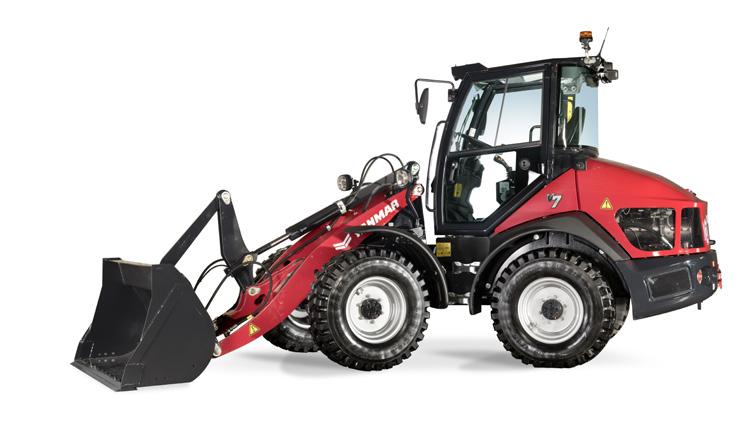
Yanmar introduced the all-new 47.6-hp V7 compact wheel loader to the North American market. The 9,370-lb. machine fills the gap in the Yanmar wheel loader line between the V4-7 and the V8 and features a low operating weight and high bucket capacity. Yanmar’s V7 features a 0.92-cu.-yd. bucket capacity for its weight.
An optional light material bucket brings that bucket capacity to more than a full cubic yard with each scoop. The V7 also includes a powerful Tier 4 Final Yanmar engine, allowing for a lifting capacity of 7,981 lbf. It features ±40 degrees of articulation and ±10 degrees of oscillation. The machine includes a newly designed articulation oscillation joint allowing oscillation in the center instead of the rear, maximizing ground contact.
Read More at eqtoday.co/hpe9ymit
Manitou 1950 RT
Manitou introduced the 1950 RT compact track loader. This 74-hp machine has a rated operating capacity of 1,950 lbs. and highflow auxiliary hydraulics.
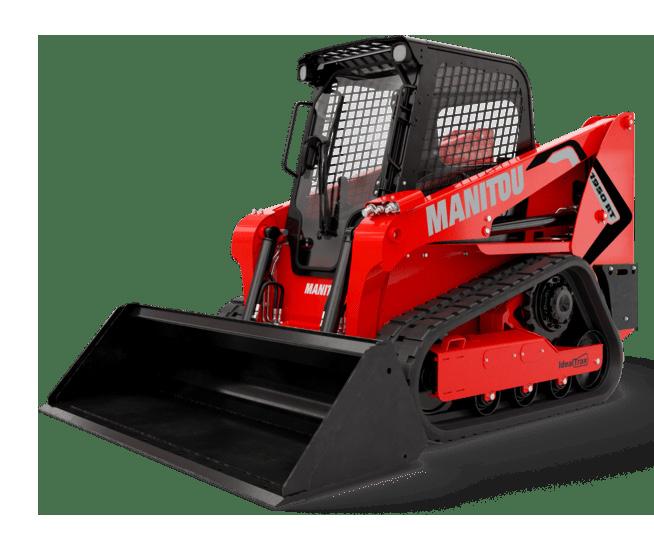
The 1950 RT is built with different track widths and tread patterns. The radial lift arm design enables ground engaging work. Added auxiliary hydraulic performance provides a platform for running a range of attachments. It includes the IdealTrax track auto-tensioning system, a swing-out cooler that keeps the engine compartment clean and engine temperatures down and the Manitou EasyMANAGER fleet management platform (telematics).
Read More at eqtoday.co/s0mxbj8m
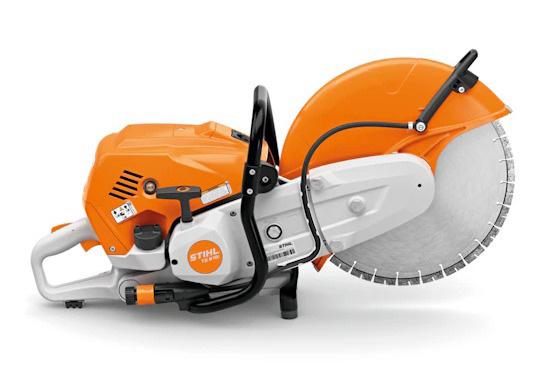
STIHL TS 710i & TS 910i Cutquik
The TS 710i STIHL Cutquik and TS 910i STIHL Cutquik with electronic fuel injection are the newest gasoline-powered cut-off machines within the STIHL Cutquik lineup. Designed to deliver performance on jobsites, these cut-off machines feature STIHL fuel injection technology, eliminating the need for a choke.
The TS 710i and TS 910i are equipped with the STIHL ElastoStart grip, a built-in shock absorber and anti-vibration system. Users can alter the cutting wheel and guard mount either inboard or outboard for maneuverability and use in additional cutting positions. The X2 Air Filtration System supports engine maintenance. Professionals can access sensor-controlled fuel metering, delivering the correct amount of fuel needed based on operating conditions, and a water connection with the shut-off valve and quick connector to turn off the water when not in use.
Autodesk Informed Design
Autodesk Informed Design is a cloud-based solution that connects design and manufacturing workflows. Informed Design allows architects to work with customizable, predefined building products and manufacturers to share their products with design stakeholders.

Informed Design unlocks industrialized construction—the application of manufacturing principles to the built environment. Informed Design is part of Autodesk’s Design and Make Platform environment. It is available globally as a free add-in for Autodesk’s Informed Design for Revit and Informed Design for Inventor.

JLG ES4046 Electric Scissor Lift
Read More at eqtoday.co/5wlht94y
JLG’s ES4046 Electric Scissor Lift has a platform height of 39 ft. (indoors) and a zero turning radius, which provides access to narrow aisles and tight overhead spaces. This model offers over 50% more duty cycles than the previous R4045 Electric Scissor Lift and uses fewer hoses and fittings and a single lift cylinder. Equipped with fold-down rails, ClearSky Smart Fleet is standard on the ES4046 Electric Scissor Lift to allow for fleet tracking. Operators can also add optional features such as CleanGuard leak containment system, a 900W inverter to charge tools and the SkySense detection system that helps protect workers and property.
John Deere 950 P-tier & 1050 P-tier Dozers
John Deere introduced the 950 P-Tier and 1050 P-Tier dozers. Previously in the market as the 950K and 1050K, these machines are the next generation of P-Tier dozer models.
Read More at eqtoday.co/9rl783g0

The new 1050 P-Tier dozer offers engine power and a redesigned hood and front end. In addition, the 950 P-Tier and 1050 P-Tier have visibility and safety features. The tag link and the blade designs have been upgraded, bringing the blade 10 in. closer to the frame.
Along with the tag link, inverted tilt and pitch cylinders were added. The 1050 P-Tier dozer features a revamped JD14 (13.6-L) engine, which replaces the 13.5-L engine in the 1050K. The JD14 uses a single canister in the aftertreatment system to meet emission regulations without a diesel particulate filter.
Read More at eqtoday.co/4otuxbwj
EQUIPMENT INTRODUCTIONS 6 EQUIPMENT TODAY | April/May 2024 www.ForConstructionPros.com/Equipment
Read More at eqtoday.co/504afttw
These pages feature some of the latest equipment available. For more information on these products, use the QR code shown.

JCB
S1932ED
JCB introduced the S1932ED Electric Drive Scissor Lift for rental and construction markets. The S1932ED was redesigned to prioritize transportability by reducing the weight by 250 lbs. This reduction enables flexibility, making it possible to tow and load onto vehicles.
The machine has quick-folding rails for navigating through low doorways and other restricted spaces. The S1932ED comes standard with a leak containment system, reducing the risk of fluids escaping onto working surfaces. It offers an optional pipe rack capable of securely transporting up to 220 lbs. of materials.
Read More at eqtoday.co/theuuo1n
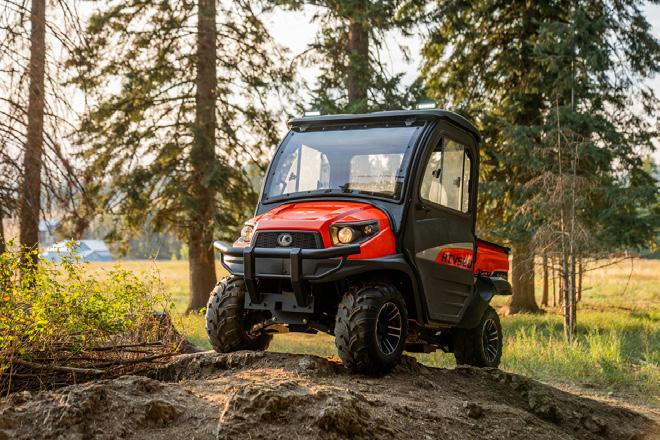
Kubota RTV520 Crossroads Edition
Kubota Tractor Corp. announced a new, limited edition to its RTV utility vehicle line with the RTV520 Crossroads Edition. The RTV520 Crossroads Edition comes with a factory-installed package that includes a full cab with tilt-out windshield, sliding windows, LED front and rear work lights, and a cargo mat.
This utility vehicle features dynamic breaking and a redesigned suspension. The limited-edition model is Kubota orange with black alloy wheels and has a top speed of 20 mph.
Read More at eqtoday.co/qspgruez
Caterpillar 330 Straight Boom Excavator
Expanding Caterpillar’s demolition excavator line, the 330 Straight Boom excavator is for low-level building demolition applications.
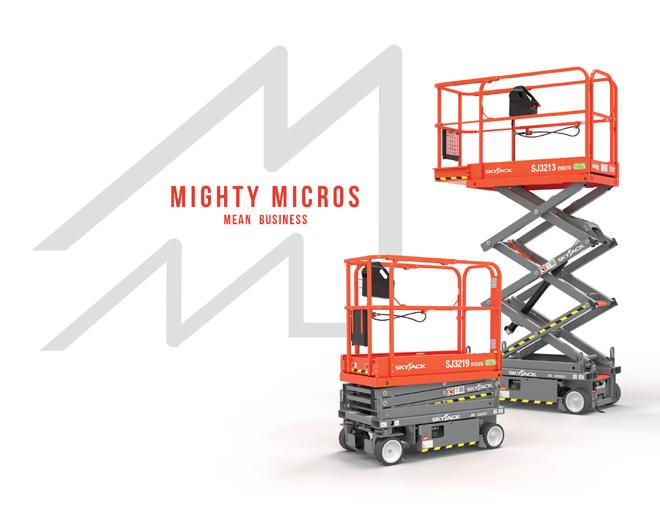
Skyjack SJ3213 & SJ3219 Micros
Skyjack announced a new micro scissor line with the launch of the SJ3213 micro and SJ3219 micro scissor lifts for low-level access requirements. Fully proportional drive and lift controls offer drive with control and torque, while the variable-speed, brushless, AC electric, front-wheel drive provides duty cycles. The newest micros have been designed to fit most passenger style elevators and work in tight spaces and feature 13-ft. and 19-ft. platform heights, 500-lb. platform capacity, and 20-in. rollout extension to increase work area and provide up and over capability.
Read More at eqtoday.co/0b661as9
Volvo EC500 Straight Boom Excavator
The new EC500 Straight Boom Excavator from Volvo Construction Equipment includes a 25.5-ft. straight boom. This machine has a powerful engine, a demolition-specific cab and safety features, like an optional remote control that allows the operator to control it from a safe distance.
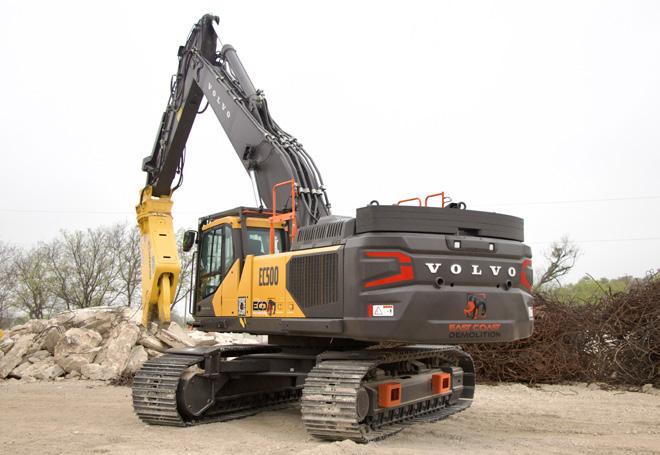
Custom-built for demolition, the EC500 Straight Boom has a 6,610-lb. heavier counterweight for added stability. For moving from site to site, the counterweight can be removed with a hydraulic removal feature. The machine is reinforced with boom and bucket cylinder protection, full track guards, heavy-duty belly covers and heavy-duty side doors. Standard features include an auxiliary return line for attachment movements.
Read More at eqtoday.co/0b661as9
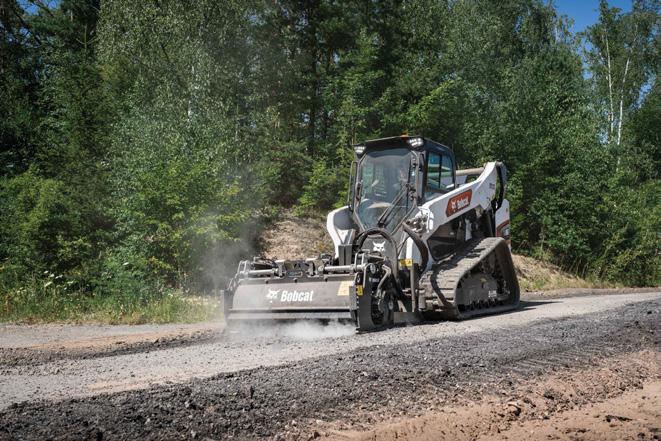
Bobcat Super-Flow Planer
Bobcat super-flow planers are capable of milling concrete and asphalt up to 7 in. thick. The super-flow planers are available in 24-in. and 48-in. cutting widths and use the extra hydraulic power available in the Bobcat T86 compact track loader and S86 skid-steer loader equipped with super flow generating up to 42 gpm and 4,061 psi.

Offering a maximum digging depth of 19.1 ft. (5.8 m), the new straight boom excavator features a maximum vertical reach of 40.9 ft. (12.48 m)—8.0 ft. (2.45 m) higher than a standard Cat 330 excavator—for demolishing three-story buildings. The 330 SB is also matched to a wide range of demolition tools including hammers, multi-processors, demolition grapples, pulverizers and quick couplers. Powered by the 275-hp (205 kW) Cat C7.1 engine, three power modes—Smart, Power and Eco—match engine and hydraulic power to the task, reducing fuel consumption.
Read More at eqtoday.co/8wo7yoki
Bobcat also offers a 40-in. planer compatible with super-flow and high-flow hydraulics. Six planer attachments accommodate standard, high-flow and super-flow hydraulics. To cater to different cut angles, the attachment is capable of oscillating up to +/- 15 degrees.
Link-Belt 260 X4S
Link-Belt offers the 260 X4S excavator powered by a 177-hp Isuzu turbocharged diesel engine and features an operating weight of 57,300 lbs. Equipped with a 108-gal. fuel tank, the 260 X4S has a maximum dig depth of 22 ft., 8 in.
Read More at eqtoday.co/vnhnxqzk

The excavator features Custom Flow Balance, customizable joystick function buttons, several work modes and Trimble-ready components. Operators can access a 10-in. display to view the status of components and the surrounding area during use.
A dualband modem supports RemoteCARE communication for remote monitoring. The cab is equipped with a high-back seat with air, tilt and heat features. Adjustable pivoting armrests, headrests, seat height and lumbar support are also available.
Read More at eqtoday.co/jk32gwhg
EQUIPMENT INTRODUCTIONS April/May 2024 | EQUIPMENT TODAY 7 www.ForConstructionPros.com/Equipment
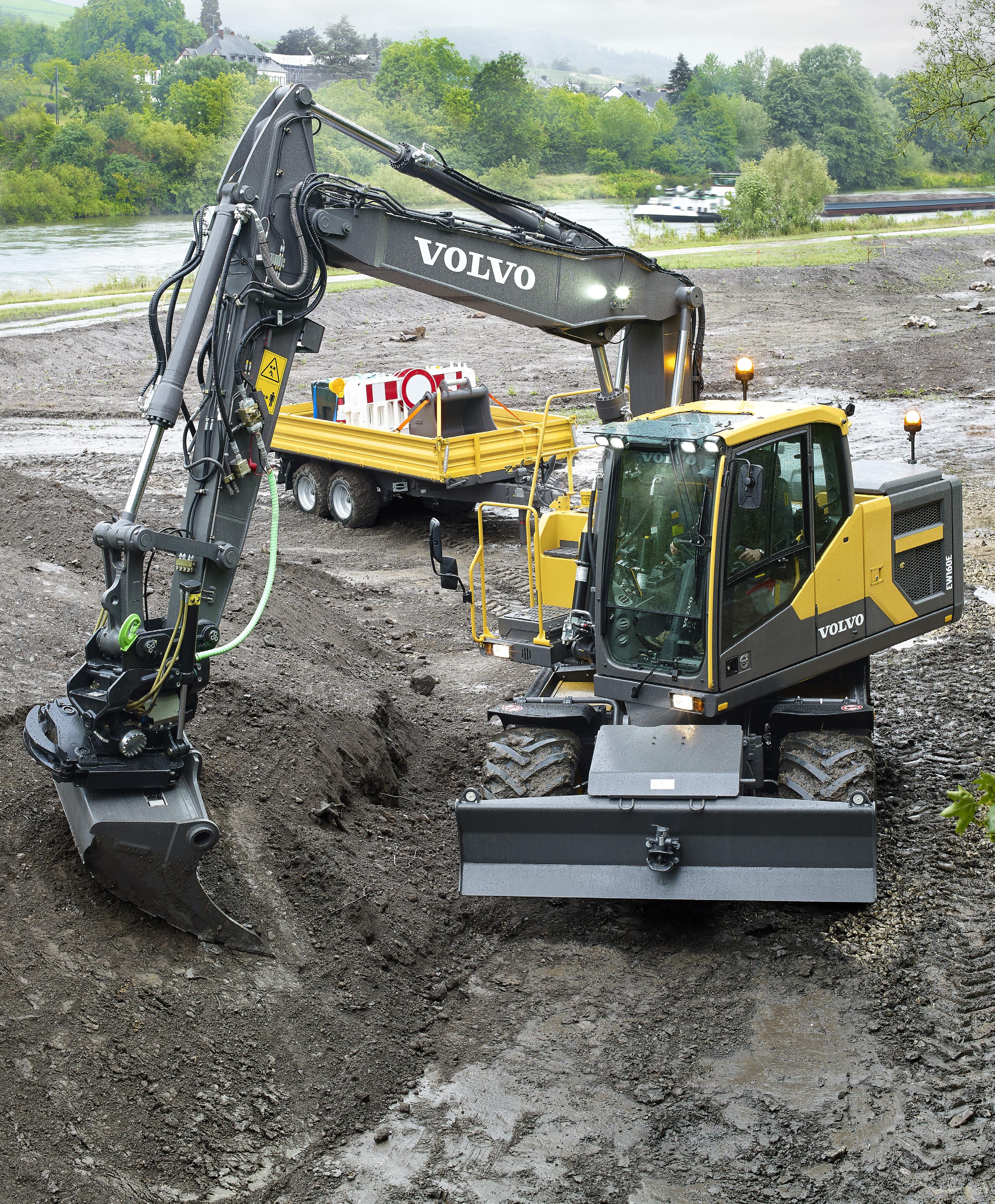
HOW WHEELED EXCAVATORS COME IN HANDY ON THE JOBSITE
Wheeled excavators tout a number of benefits, from simplified transport, decreased maintenance and can be used in a variety of applications, from digging and craning to vegetation management.
8 EQUIPMENT TODAY | April/May 2024
SERIES: EXCAVATOR INNOVATIONS
COVER
www.ForConstructionPros.com/Equipment Volvo Construction Equipment
Wheeled excavators aren’t as suitable for rough or muddy terrain as their tracked counterparts.
During last year’s Utility Expo in Louisville, Kentucky, two machines were heavily featured. The first was the backhoe loader. The other was the wheeled excavator. Some of the benefits of wheeled excavators are like those of backhoes, including the ability to travel from site to site without needing a trailer.
With different attachments, excavators can be versatile in their operation and applications. In addition, according to many experts, they also have decreased maintenance needs. Read on to learn what industry and wheeled excavator experts you can expect from these adaptable machines.
The Main Benefits of Wheeled Excavators
The wheels, of course, are one of the first benefits. According to Diego Butzke, product manager, excavators, CASE Construction Equipment (CASE), they allow the excavator to be self-deployable.
“Contractors can move them around from jobsite to jobsite without the need for [a] … hauling truck,” said Butzke. “CASE wheeled excavators travel up to 25 miles per hour (mph) and come with a trailer hitch so that [contractors] can also pull along work tools or debris from a jobsite.”
John Waldron, product manager, wheeled excavators, Volvo Construction Equipment, agrees that wheels and transport make wheeled excavators an ideal choice.
“With a top speed of around 23 mph, you can avoid needing a lowboy and a commercial driver’s license (CDL) for around-town work. With a trailer that has overrun brakes, you can haul several tons of supporting tools and attachments, saving more time and labor, Waldron said. “Wheeled excavators also create less disturbance on asphalt, which means less cleanup.”
Butzke, Waldron and Rich Knudson, senior product consultant, Caterpillar, also agree that versatility is another major benefit of a wheeled excavator. According to Knudson this includes, “versatility [concerning] boom and undercarriage offerings and operating on finished surfaces with minimum risk of damage.”
Waldron stated that a two-piece boom is preferred because, “[it] lets an operator stretch farther, dig deeper and closer to the machine, and reach higher (or [farther] underneath [itself]). This can be especially beneficial by giving operators more flexibility to go up, around and under obstacles like mailboxes, guardrails and bridges.
“Additionally, a two-piece boom will outlift a mono boom because … the center of gravity [can be put] back toward the center of the machine,” said Waldron.
Decreased maintenance needs are another pro when considering a wheeled excavator.
“Wheeled machines … provide a lower total cost of maintenance versus their steel-tracked counterparts [because] the tracks wear faster than the wheels and are more expensive to replace,” Butzke said.
Other benefits, according to Waldron, include:
˜ No decrease in performance. A common misconception is that wheel loaders lose the stability of a tracked machine, but that’s not the case. With outriggers, a wheeled excavator may be more stable because of its wider footprint. In addition, the power is the same,
including breakout and tear-out forces, reach, and digging depth.
˜ Excellent maneuverability. A shortswing wheeled excavator can work in one lane of traffic, while a comparable conventional swing machine may require closing two lanes.

COVER STORY | By Lori Ditoro, Editor-In-Chief
COVER SERIES: EXCAVATOR INNOVATIONS
Wheeled Excavator Applications
Because of their versatility, wheeled excavators can be used in many of the same applications as traditional excavators. Some of these include:
˜ Roadbuilding
˜ Grading
˜ Utility and sewer construction
˜ The government space for yearround applications, including material handling, junk removal and light demo
˜ Urban and rural civil construction
˜ Right-of-way maintenance
˜ Culvert, bridge and waterway maintenance
˜ Natural disaster cleanup
˜ Waste handling
“One underappreciated use for wheeled excavators is vegetation management next to roadways,” Butzke said. “Often, municipalities will modify an ag tractor for this work, but the wheeled excavator can perform this work more safely and productively while giving the additional advantage of all its traditional jobsite uses such as digging and craning.”
“Some uncommon applications of wheeled excavators are in transfer stations, waste and demolition,” Marcus Barnes, senior product manager, excavators, for Liebherr said. “In transfer stations, they are used because they are compatible with hydraulic tools like sorting grapples and can quickly move around large transfer stations. In demolition, they are used in large industrial buildings such as warehouses to tear down the inside of the structure for retooling or other projects.”
Limitations of Wheeled Excavators
One limitation of a wheeled excavator is the initial purchase price, Waldron indicated.
“[They] can be more expensive than some other types of equipment, especially when considering the initial purchase price—but the cost savings go beyond the initial purchase of the machine and continue throughout the excavator’s lifespan. No CDL is required, meaning the same person who operates the machine can drive it.”
Other savings involve decreased maintenance and no additional vehicles or drivers required to transport the equipment. Wheeled excavators take themselves from one jobsite to the next.
While wheeled excavators can perform well when compared to tracked excavators, the wheels are a benefit and a weakness for these machines. Stability, traveling on uneven or sloped jobsites or operating in muddy or rough terrains are areas where a tracked machine may be a preferred option.
Butzke addressed the issue of stability. According to him, “If doing heavy lifting or strenuous craning,
operators will find that the stability of wheeled excavators isn’t on par with their tracked counterparts. For general lifting and craning work, wheeled excavators are strong enough to meet many jobsite demands and outpace tracked machines for getting work done because of their ability to move around the site faster.”
When traveling on uneven or sloped areas, “the main disadvantage wheeled excavators have when compared to tracked excavators is that they aren’t optimized to operate on steeply angled slopes or in extremely poor underfoot conditions,” Knudson said.
Other terrains that may cause problems for wheeled excavators are muddy or rough locations.
“Wheeled excavators aren’t as suitable for rough or muddy terrain as tracked machines because tracks provide better traction and stability on uneven surfaces, “Waldron said. “Wheeled excavators also have higher ground pressure than tracked excavators [because of] the weight distribution on their wheels. This can lead to soil compaction and surface damage in soft or sensitive areas.”
Technology Innovations
As previously mentioned, the twopiece boom is beneficial to wheeled excavator operations, but it is not heavily used in North America. It is more popular in the E.U. Other innovations include:
˜ Moving object detection
˜ Tiltrotators
˜ Auto axle and brake lock
˜ Swing and implement lock
˜ Grade control
˜ Geofencing
˜ Load-sensing hydraulic system
˜ In-cab attachment set up Exclusive to the CASE wheeled excavators (according to Butzke) is “moving object detection—a true operator-first enhancement,” he said. “By having this [360-degree], second set of eyes … the operator is better aware of their surroundings by being alerted on the display if a machine or person moves into the path of the machine.”
Barnes highlighted that Liebherr’s “automatic digging brake automatically locks the axle when the operator depresses the brake.”
Knudson said that Caterpillar offers several technologies to assist wheeled excavators. “With Caterpillar Next Generation Wheeled Excavators, we offer … 2D and 3D grade control, e-fencing, and payload as optional attachments. We also have several standard features such as auto axle and brake lock, and swing and implement lock. All these features allow operators to safely maximize the machine’s safety, performance, and productivity.
“In addition, as standard equipment, operators can program
and save machine controls, as well as performance settings to his or her preference. All Caterpillar Next Generation Wheeled Excavators come tiltrotate-system (TRS) ready from the factory, which when coupled with a TRS, boosts the machine’s versatility and productivity,” Knudson added.
Volvo also includes tiltrotators to help maximize attachment capability and uses a load-sensing hydraulic system.
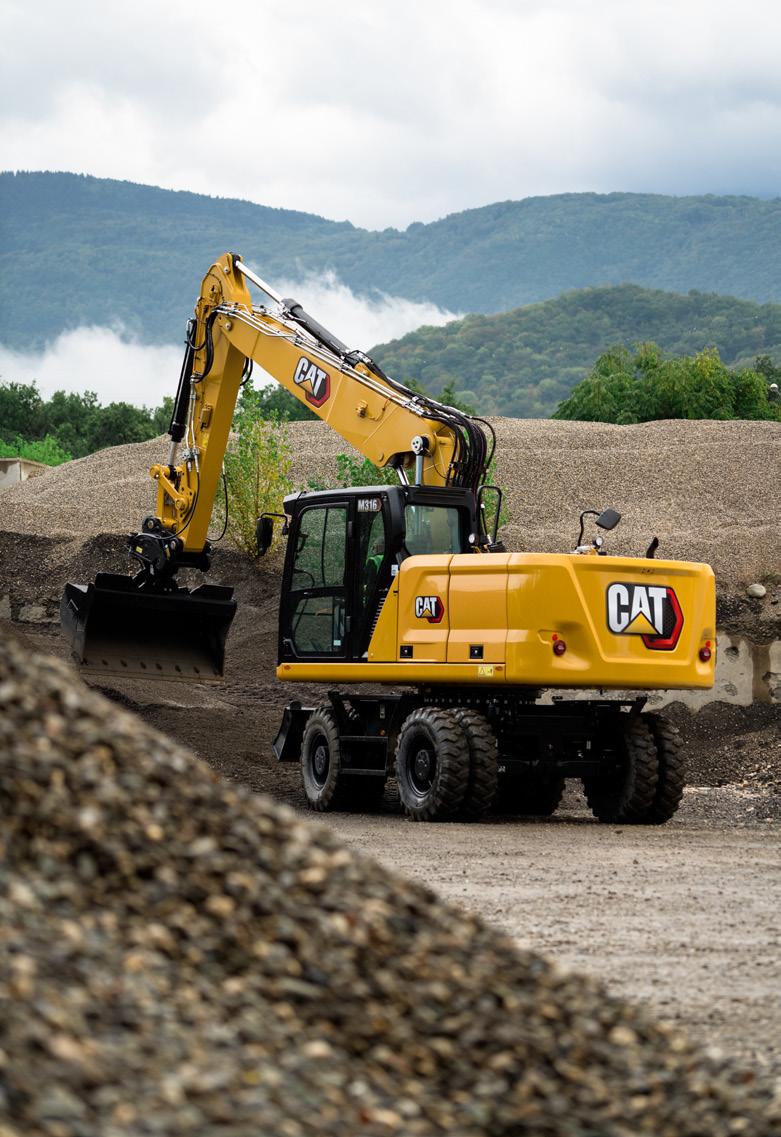
According to Waldron, “Wheeled excavators can be the Swiss Army knife of a fleet and prevent contractors from investing in multiple machines because they can [use] the same attachments as crawler excavators. One big differentiator is the hydraulic system. Wheeled excavators run a load-sensing hydraulic system, which is much better at handling a multitude of attachments, such as mowers, hammers and compactors.
“They also enable a tiltrotator, such as a Steelwrist. It allows an operator to spin the bucket 360 degrees and tilt [it plus or minus] degrees for greater flexibility. The Steelwrist can handle buckets, compactors, grapples, sweepers and more. The Steelwrist also has a claw on the back—essentially a two-finger grapple—that helps it excel at utility work.”
While many manufacturers allow operators to connect and set up attachments from the cab, Butzke points this out as a technology benefit of the CASE wheeled excavators.
“Another benefit of CASE wheeled excavators is the ability to set up work tools from the cab such as hydraulic flow and pressure and utilize configurable work mode settings for up to 20 different attachments,” Butzke said.
Who Should Consider a Wheeled Excavator?
Reduced maintenance and transportation costs and flexibility are the hallmarks of wheeled excavators. So why should a contractor make the move to these machines?
Wheeled excavators operate in many applications and can use any attachment that a tracked machine can.
a backhoe because it only has a 180-degree working radius compared to 360 degrees on wheeled excavators. This added flexibility allows more options to dump material and load a truck, or when trenching, an operator needs to think about repositioning a backhoe. However, a wheeled excavator allows them to simply push the travel pedals and keep digging.
˜ A backhoe’s total cost of ownership is higher. Backhoe tires are more expensive, and the machines consume more fuel because of a larger engine and hydraulic system. Butzke stressed that most contractors can benefit from adding these versatile machines to their fleets.
“Having wheeled excavators in your fleet is a great way to reduce … operational costs. These machines can do a variety of work all year long versus sitting in the yard. They provide a lower total cost of ownership [when compared with] tracked excavators, and because they’re self-deployable, they reduce your overall transportation costs,” Butzke said. “Contractors looking to grow their businesses, especially those who have government contracts, can expand the type of work they perform—from roadbuilding to vegetation management.”
Final Thoughts
If the backhoe loader is the jackof-all-trades on a site, Knudson and Waldron consider wheeled excavators the Swiss Army knife. Waldron said that contractors using a backhoe loader should consider a wheeled excavator for the following reasons:
˜ Don’t be deceived by the higher horsepower (hp) on backhoes. The hp represents the bucket up front that requires horsepower and doesn’t reflect the digging power on the excavator end. Wheeled excavators typically offer the dig depth and reach needed to get the same types of jobs done.
˜ When working in tight spaces, it’s often more difficult to maneuver
Industry experts think that the benefits of wheeled excavators far outweigh their limitations. Contractors who want versatility, simpler transportation and decreased maintenance may want to add one to their fleets.
“While popular in Europe for some time, the wheeled excavator market is now growing in North America,” Butzke said. “This is because jobsite conditions are changing—they’re more space-constrained, especially in urban environments—and because of mounting transportation regulations. With investments in infrastructure spending, we expect to see this market continue its upward trajectory.”
Read more at: eqtoday.co/WheeledExcavators
10 EQUIPMENT TODAY | April/May 2024 www.ForConstructionPros.com/Equipment
Caterpillar

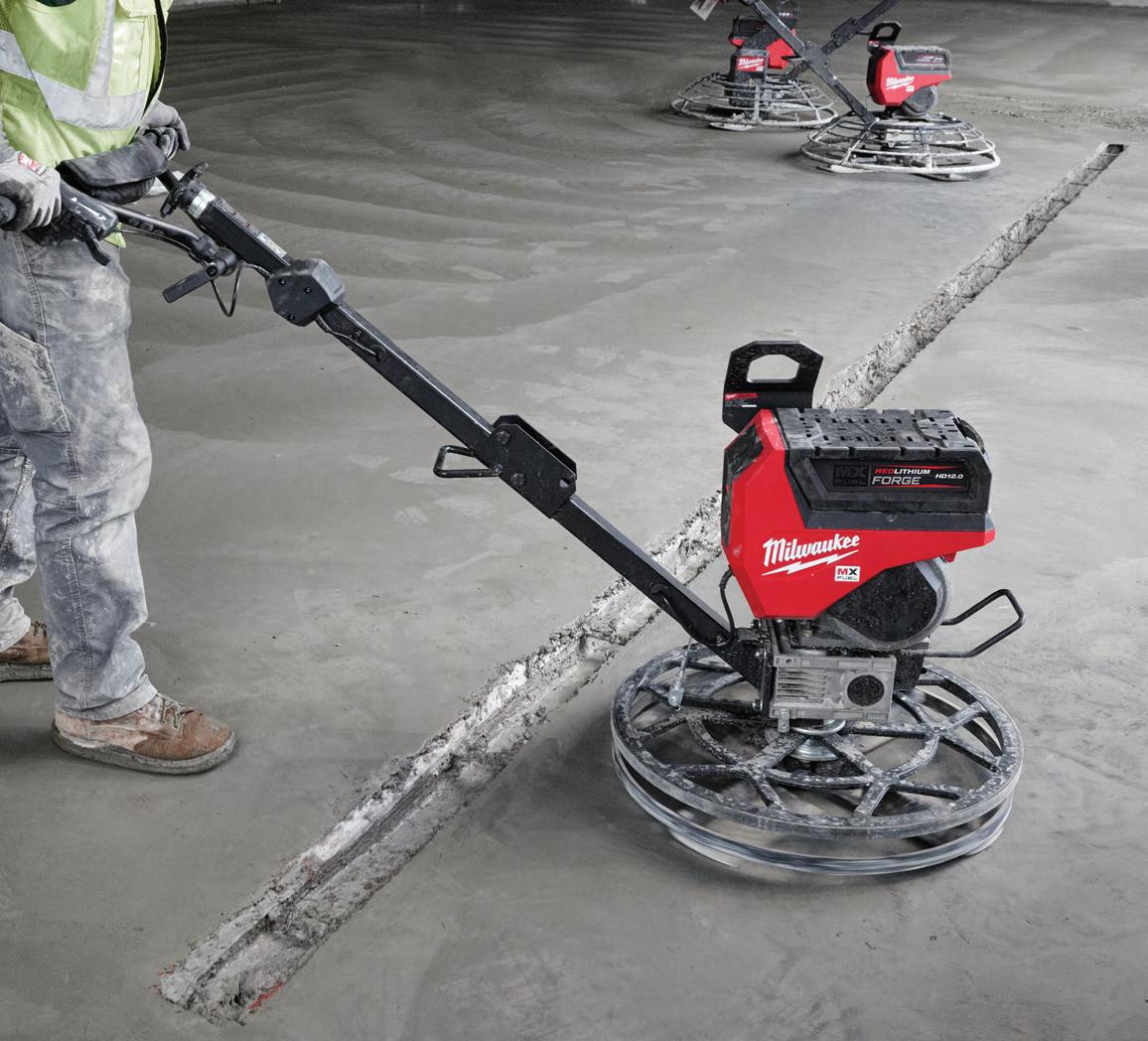
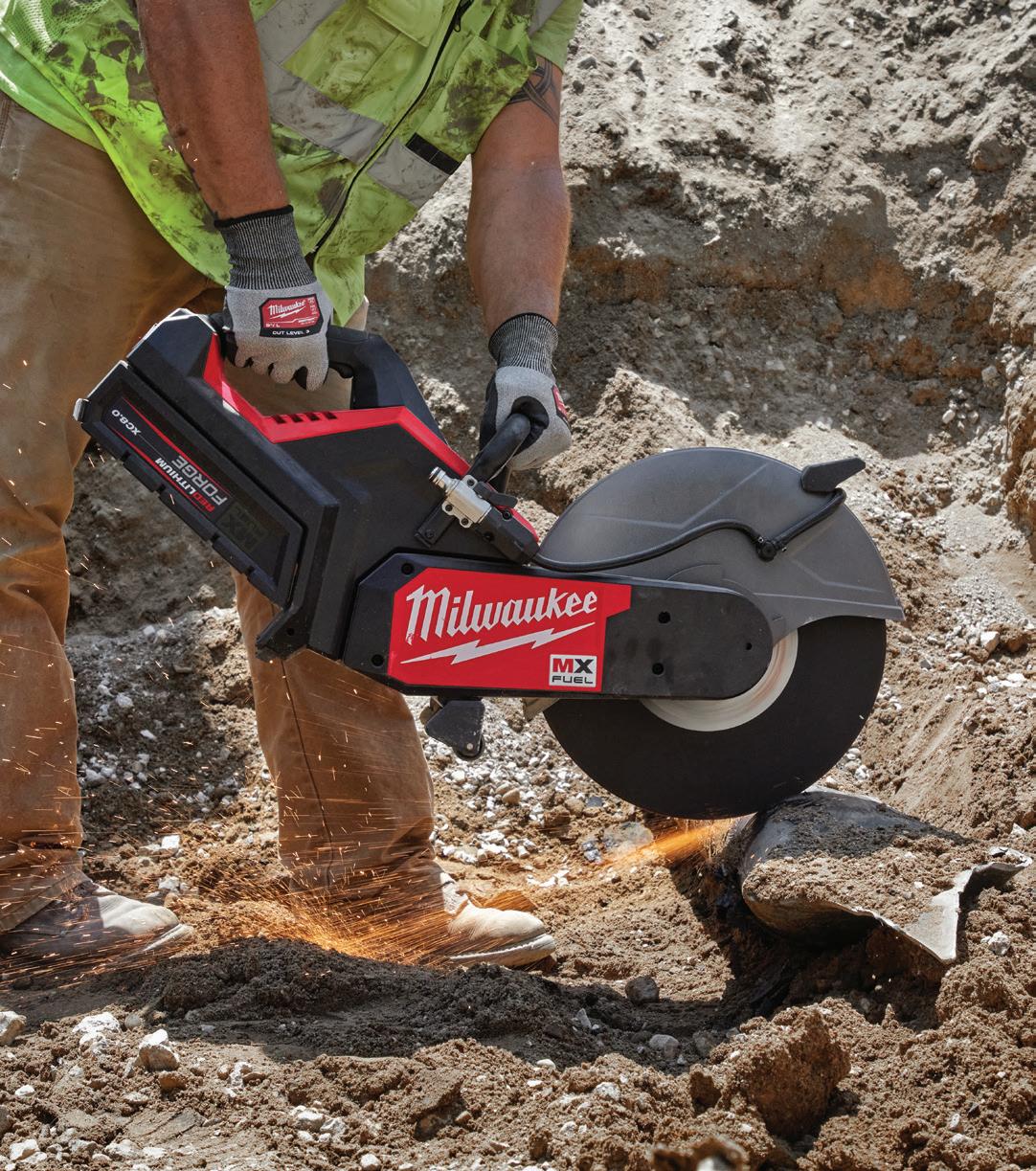


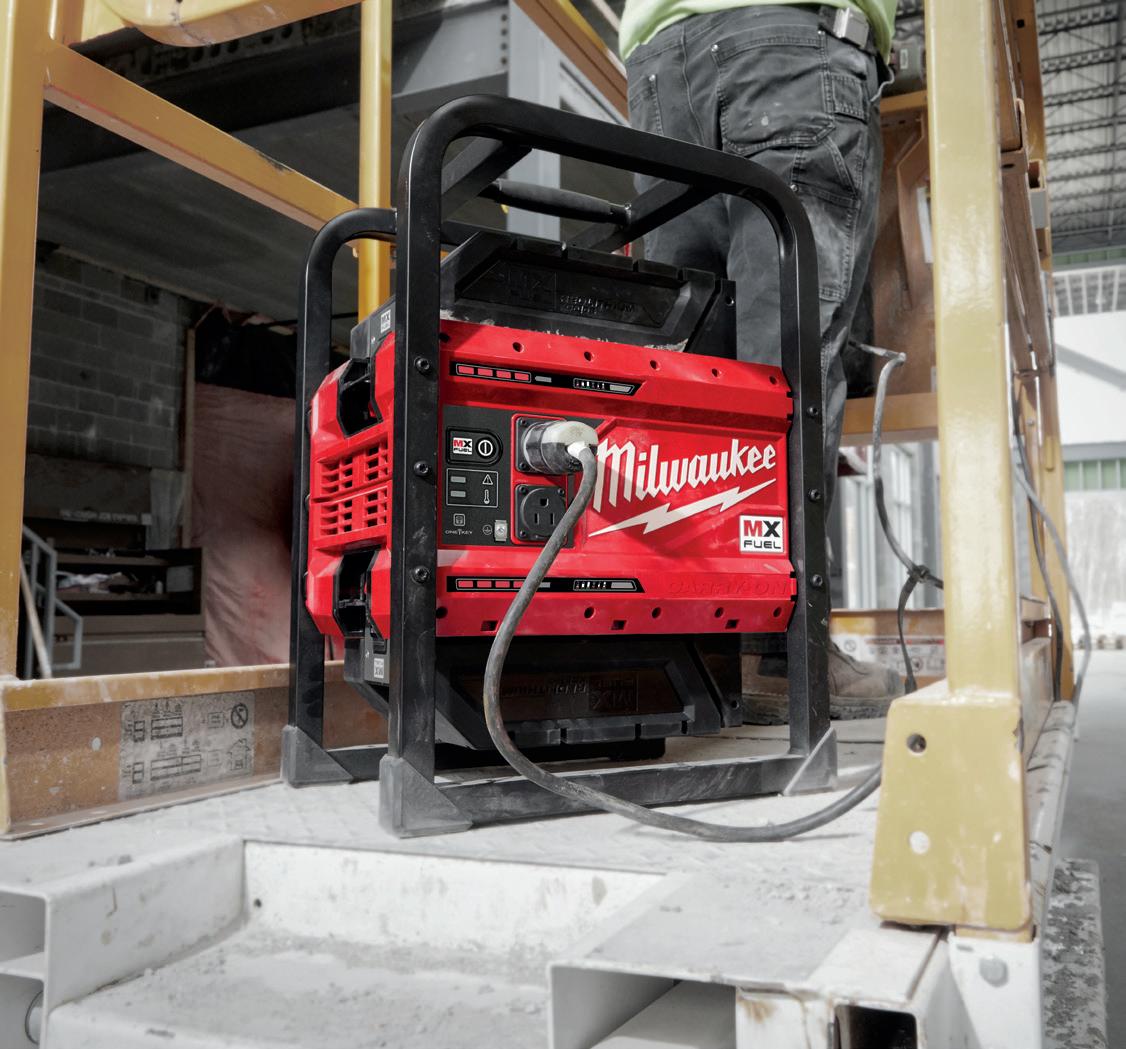

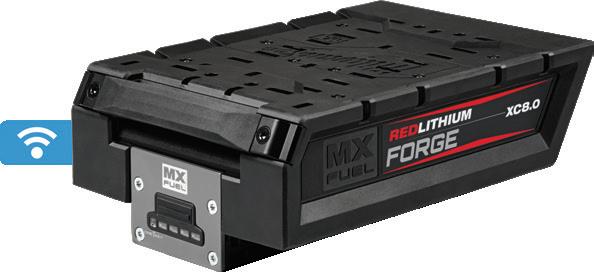

MX FUEL™ ROCKET ™ TOWER LIGHT/CHARGER MX FUEL™ CARRY-ON™ 3600W/1800W POWER SUPPLY MXF041-1XC MXF002-2XC MX FUEL™ 24" WALK-BEHIND EDGING TROWEL MXF324-2HD ™ TM MOST POWER FASTEST CHARGING LONGEST LIFE MXFSC SUPERCHARGER UP TO CHARGING 2X FASTER HD12.0 MXFHD812 XC8.0 MXFXC608 RUN-TIME UP TO VS REDLITHIUM™ XC406 2X MORE MX FUEL™ CORE RIG w/ STAND MX FUEL™ 14" CUT- OFF SAW w/ RAPIDSTOP™ MX FUEL™ 20" PLATE COMPACTOR MXF315-2XC MXF220-2HD NEW TM EQUIPMENT REDEFINED TRADE FOCUSED SYSTEM WIDE
Compact wheeled excavators within the 6-ton to 13-ton range have emerged as a critical segment within the construction machinery market.

The Versatility of Wheeled Excavators in Modern Construction
Compact
wheeled
excavators represent the future of construction, showcasing how technology enhances efficiency on the jobsite.
In the dynamic world of construction machinery, wheeled excavators stand out as powerful and versatile assets for construction professionals. These machines have transcended the conventional tracked excavator role, emerging as essential tools that redefine on-site efficiency. As construction sites evolve, particularly in urban areas, wheeled excavators are becoming integral, allowing work to be completed over larger areas. This article delves into the core features, advantages, and diverse applications of wheeled excavators, showcasing their pivotal role in shaping the contemporary construction landscape.
In recent years, compact wheeled excavators within the 6-ton to 13-ton range have emerged as an important segment within the construction
machinery market. This category, often referred to as the “sweet spot” for many construction applications, strikes a balance between power and maneuverability, making these machines indispensable for a wide range of projects.
Compact Wheeled Excavator Versus a Backhoe
While compact wheeled excavators excel in specific aspects of urban construction, it’s essential to contrast their attributes with backhoe loaders—a commonly used alternative in the construction industry.
˜ Maneuverability and space efficiency: Compact wheeled excavators outshine backhoe loaders in maneuverability within confined spaces. The wheeled excavator’s ability to
navigate tight corners and work in restricted areas, such as a single lane of traffic, makes it a preferred choice for urban projects with limited space, providing a distinct advantage over the more cumbersome maneuverability of backhoe loaders.
˜ Dedicated excavation focus: Unlike backhoe loaders, which combine a front loader and rear excavator, compact wheeled excavators are designed with a dedicated focus on excavation tasks. This specialization allows them to excel in precision digging, making them more suitable for tasks such as trenching, foundation excavation, and utility work in cities.
˜ Quick and efficient transportation: Compact wheeled excavators often have an edge in
terms of transportation efficiency. Their wheeled design and hydrostatic drive allow for faster movement between jobsites (up to 40 kilometers per hour), especially when compared to backhoe loaders that might require additional transportation considerations, such as a truck and trailer. This advantage contributes to quicker response times and increases overall project efficiency.
More Than Urban Machines
While wheeled excavators have already proven their usefulness in urban construction projects, their benefits extend far beyond city limits. In unique niches that demand precision, maneuverability and versatility, wheeled excavators are becoming indispensable assets.
12 EQUIPMENT TODAY |April/May 2024 www.ForConstructionPros.com/Equipment COVER SERIES: Excavator Innovations
Wacker Neuson
˜ Golf course maintenance: The meticulous care required to groom a golf course demands equipment that can delicately handle tasks without causing disruption to the landscape. A compact wheeled excavator, with a set of wide tires, can move seamlessly across greens and fairways, offer a precise solution for tasks such as bunker shaping, pond maintenance, and tree planting. The reduced ground disturbance while turning, of wheeled excavators (compared to a tracked machine) ensures minimal impact on turf surfaces, preserving the aesthetics of the golf course.
˜ Cemetery landscaping and maintenance: In serene cemetery landscapes, wheeled excavators play a crucial role in landscaping and maintenance. Their agility allows operators to navigate through rows of headstones and tight spaces with ease, facilitating tasks like grave excavation, monument installation, and general landscaping. The higher travel speed, when compared to a traditional excavator, allow it to quickly transition to different areas of larger cemeteries.
˜ Agricultural operations: In the expansive world of agriculture, the high travel speed of compact wheeled excavators find utility in various tasks. Whether it’s universal tasks like clearing land for new crops and digging irrigation ditches, or a specific niche like cleaning cranberry marshes, these machines adapt to the diverse needs of agriculture. The ability to attach specialized implements, such as augers, grapples, or mowers makes wheeled excavators an asset for farmers seeking efficient solutions for their operations.
˜ Versatility in forestry and logging: Wheeled excavators are not confined to manicured landscapes; they venture into rugged terrains, proving their mettle in forestry and logging operations. Their mobility allows access to remote locations, while attachments like grapples enable efficient handling of logs. The agility of wheeled excavators ensures that they can navigate through densely wooded areas, contributing to sustainable forestry practices.
Technology
Not just a change in form and function, compact wheeled excavators are also at the forefront of technological advancements in construction equipment.
˜ Telematics systems for realtime insights: Modern wheeled excavators are equipped with sophisticated telematics systems that revolutionize how construction
professionals manage and monitor their fleets. These systems collect and transmit real-time data on machine health, fuel consumption, usage and location. Fleet managers can access this information remotely, enabling proactive maintenance planning, minimizing downtime and optimizing overall operational efficiency.
˜ Precision through machine control: The integration of advanced machine control technology has transformed the way wheeled excavators operate on construction sites. GPS-guided systems enable precise digging and grading, ensuring that excavation tasks meet exact specifications. This technology enhances accuracy and contributes to increased productivity by reducing the need for manual adjustments and rework. Machine control systems bring a new level of efficiency to tasks such as trenching, grading and foundation excavation.
˜ Customizable controls for operator comfort: Some wheeled excavators now offer customizable control systems that cater to the preferences and comfort of individual operators. Adjustable joysticks, touch-screen interfaces, and programmable buttons allow operators to tailor the machine’s controls to their liking. This enhances operator comfort and contributes to increased productivity because operators can
work more efficiently with controls that suit their unique preferences.
˜ Tiltrotators Enhancing Versatility and Precision: Tiltrotators have emerged as game-changers in the world of wheeled excavators. While they already have an established foothold in Europe, they are starting to gain popularity in North America. These hydraulic attachments allow the excavator’s bucket or other attachments to rotate, tilt, and pivot, increasing flexibility. Tiltrotators enable operators to access challenging angles, work around obstacles, and execute tasks with a level of precision that was previously hard to achieve. From landscaping to utility work, tiltrotators unlock new possibilities for wheeled excavators.
Common Digital Language
As we peer into the future of technology and envision the modern jobsite, the need for a common digital language that is manufacturer- and machine-independent is becoming increasingly crucial.
This common digital language will enhance communication among site developers, fleet managers, operators, and even the machines and attachments themselves.
Addressing this complex task of developing a common digital language is an organization known as Machines in Construction 4.0 (MiC 4.0, link).
MiC 4.0 comprises over 100 members from equipment
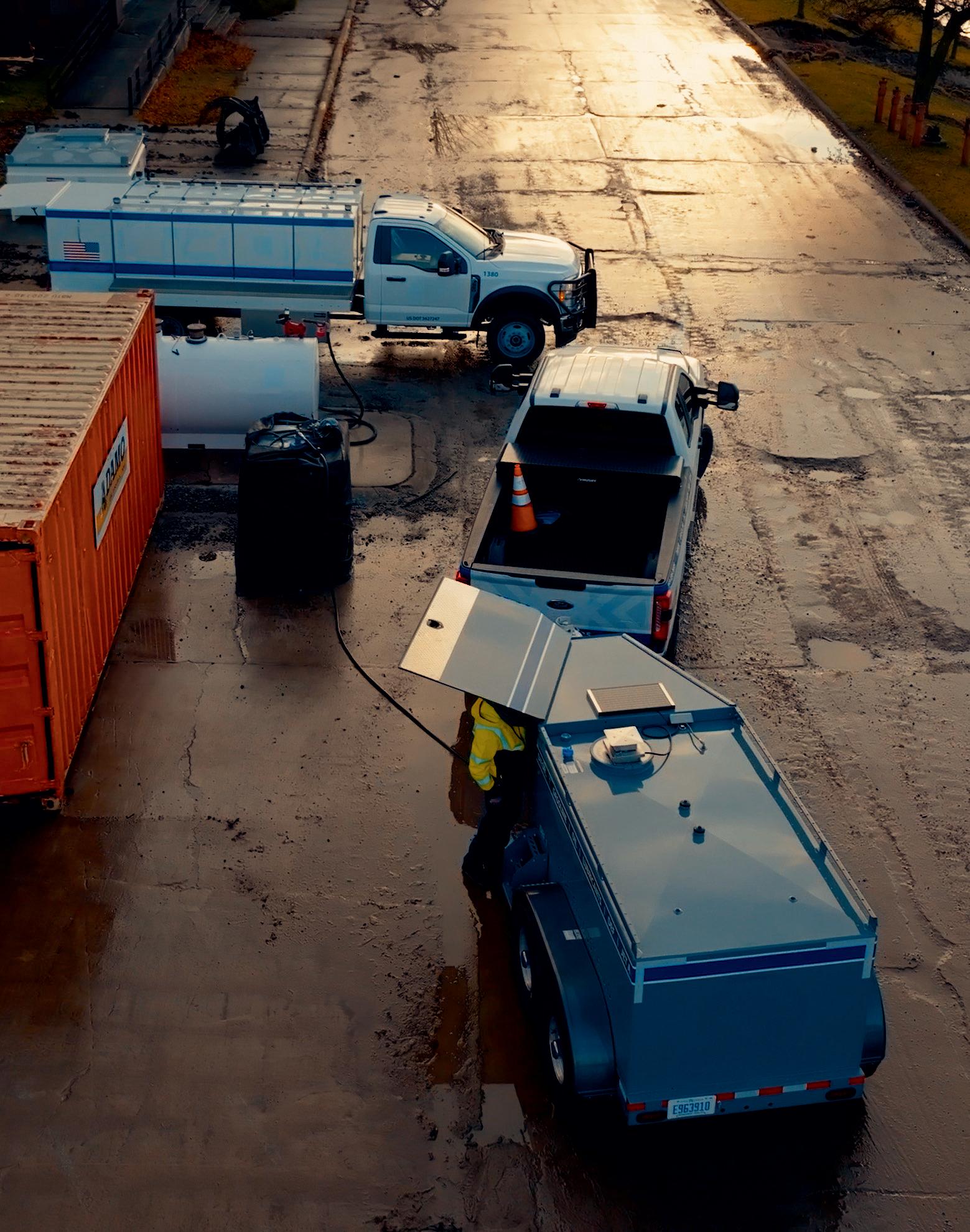
manufacturers and stakeholders across seven countries.
An example demonstrating early adoption of MiC 4.0 standards is an all-new wheeled excavator. Engineers collaborated closely with several tiltrotator manufacturers throughout the machine and software development process to ensure compatibility right from the factory. This translates to a plug-and-play experience when installing a tiltrotator on the wheeled excavator with no need for additional software, controllers or third-party joysticks. Moreover, it empowers the operator to choose their preferred brand of tiltrotator, and the machine seamlessly adapts the controls based on that specific make and model.
Compact wheeled excavators represent the future of construction, showcasing how technology enhances efficiency on the jobsite. With their advanced features and versatility across many applications, these machines provide a practical glimpse into the evolving landscape of construction machinery.
In an era emphasizing connectivity, these excavators embody innovation, promising heightened productivity and efficiency in modern construction.
Read more at: eqtoday.co/wheeledex
Jay

April/May 2024 | EQUIPMENT TODAY 13
COVER SERIES: Excavator Innovations
MORE ABOUT TRAILERS & TRUCK UPFITS AT THUNDERCREEK.COM
Quatro is a commercial product manager for Wacker Neuson.
LEARN






NAVIGATE Your Possibilities With Aftermarket GPS
Integrating aftermarket GPS or GNSS technology is achievable and can provide many benefits to contractors, workers and machines.
GPS and GNSS technologies have taken over the construction industry and for good reason. This technology is beneficial when it comes to safety, machine monitoring and enhanced maintenance.
Most people are probably familiar with GPS since it’s the technology that people in most industries use to navigate to unfamiliar places or identify the most precise locations for various applications. Just as GPS is a global positioning system, GNSS
is a global navigation satellite system. These two systems are quite similar and one of the main differences between them is that GNSS provides equipment with a wider network of satellites. Because of all the benefits these systems have to offer, it’s no


wonder that construction companies want their machines to be equipped with one of them. The functions that each system brings help construction workers, contractors, companies and the environment. But, what can

14 EQUIPMENT TODAY | April/May 2024 www.ForConstructionPros.com/Equipment SPECIAL SECTION: Aftermarket GPS & Maintenance | By Merina Shriver, Junior Editor, ForConstructionPros.com
Leica Geosystems’ GNSS machine control technology offers possibilities to enhance safety for construction workers and pedestrians around busy work sites and to protect existing and newly built infrastructure through automatic height, depth, and slew hydraulic control for excavators.
Leica Geosystems
companies do if they want their current equipment to have the technology added?
Aftermarket Technology Integration
Once a company has purchased equipment, it may seem difficult to add anything to the technological aspect of the machines. However, there is a way to integrate GPS or GNSS technology after purchasing the equipment.
While getting the technology installed ahead of time is ideal, it isn’t the only way to have GPS technologies equipped.
Troy Dahlin, vice president of the heavy construction segment U.S./Canada at Leica Geosystems, part of Hexagon, described the more reliable and consistent optimization that can be provided as a result of getting technology factory-fit.
“Factory-fit machine control solutions offer a range of advantages, starting with seamless integration, optimized design, and more reliable and consistent performance through precise calibration and testing,” Dahlin said.
Although factory-fit solutions are optimal, GPS and GNSS technology can be installed well after the purchase. To get the most seamless incorporation, whether it be factory-fit or aftermarket, it is important to work with the original equipment manufacturer (OEM).
Decisions to Make When Picking a GPS System
The options that come with having GPS systems installed are not as cut and dry as aftermarket versus factory-fit. There is also the question of what functions are needed.
“Many people default to location tracking when thinking of GPS, but GPS trackers can also deliver other telematic information, including key operational and performance indicators that tell you how your machines are being used instead of just where they are,” said Ryan Lunar, director of sales East with Tenna.
Some things to consider when deciding on a system to integrate:
SAFETY CAPABILITIES
Using GPS or GNSS technology on equipment allows for a lot of safety features to be used. Added safety is provided to the workers and the machines.
Machines are better equipped and handled with perks like:
˜ Maintenance detection — reduced downtime
˜ Cost savings
˜ AI video
˜ Theft protection
Technology like AI video allows the system to detect and prevent potential safety hazards from occurring. AI video can also help safety managers better understand certain events that they are alerted to like speeding and hard braking. Having a better understanding of safety events while operating heavy equipment can make safety policy reviews and new solutions easier to implement. This technology keeps the machine protected and workers safer.
THEFT & GPS
Not only do GPS and GNSS increase safety for workers but they help prevent theft.
“Contractors can lose up to 10% of their fleet each year due to internal theft and misplacement and even more due to external theft of construction equipment and tools,” explained Lunar.
Some of the theft-prevention features include:
˜ Location notifications and alerts
˜ Geofences
˜ Can paired with AI safety camera solutions
Things like geofences and text alerts go hand in hand. The company or contractors could set geofences around the site so that if a machine leaves the premises, they would get an alert letting them know that equipment is being taken off the site. In cases of theft, AI cameras can help handle any sort of ramifications and action.
ADDITIONAL BENEFITS OF AFTERMARKET GPS
If equipment in a fleet wasn’t equipped with GPS or GNSS originally, getting one of these systems installed is a great idea. These systems come with a great deal of benefits that include safety and easy alerts. Besides these advantages, there is a list of benefits that come with getting GPS technology installed in machines.
These additional advantages include:
˜ Cost savings
˜ Easy mileage monitoring
˜ Location data accuracy
˜ Efficiency
˜ Automated regulation compliance
˜ Access to hours-of-service data
˜ Decreased rework
˜ Easy employee work hours tracking
˜ Real-time data communication
Adding GPS to Equipment
Once the decision has been made to incorporate GPS or GNSS technology into fleets, some basic steps need to be taken.
“Contractors should follow a systematic approach, starting with evaluating the current fleet and identifying the machines suitable for GNSS integration,” said Dahlin.
It is important to have realistic expectations when it comes to GPS and GNSS technology. Not every piece of equipment is going to be able to smoothly integrate.
Lunar said, “The first step in ensuring successful GPS technology implementation is to have all appropriate parties involved in the conversation from the very beginning.”
Discussing the potential technological addition to machines with the OEM is extremely valuable and should be a first step when dealing with aftermarket GPS. It is also important to confirm that the current technology and necessary data formats on the machine are compatible with the chosen system.
Dahlin added, “It is crucial to engage certified professionals for the installation to guarantee precision and optimal performance.”
Open discussion during this process is vital for the entire operation. This sort of change affects a variety of departments and needs to be thoroughly discussed to ensure a smoother integration process overall.
“Choosing a technology provider committed to an open architecture and future-agnostic technology is crucial when contemplating a long-term investment,” said Dahlin.

When deciding to incorporate GPS aftermarket, there is a lot to gain through making careful and smart decisions. While there are lots of things to consider, the most important thing is choosing what is best for the fleet or equipment now as well as in the future. It isn’t too late to improve machines and increase safety. If there is a fleet in need of an upgrade, GPS or GNSS incorporation could be that step forward needed to improve.

more at: eqtoday.co/AftermarketGPS
Read
REVOLUTIONIZING CONSTRUCTION: The Art of Equipment Care
Diagnostic tools upgrade PMs

Contractors need a strategic plan to anticipate and address potential issues before they escalate.
In the world of heavy equipment and construction operations, prioritizing safety is crucial. Imagine construction sites resembling fire stations, where teams constantly extinguish unexpected challenges. Shockingly, 48% of contractors grapple with unplanned chaos, draining hours and funds, stifling growth—a familiar struggle akin to New Year’s resolutions filled with aspirations but often going back to old routines. While resources are finite, the key lies in effective planning and anticipating the unknown. The good news? Any company can shift toward a preventive approach.
Navigating the intricate mix of projects, equipment, materials, and
personnel planning poses a significant challenge. However, seasoned contractors use their familiarity with terrain, clients, weather and equipment breakdowns to establish a robust foundation, recognizing discernible trends that allow for strategic provisions for the future.
Preventive Maintenance
Equipment management within this complex landscape can be complicated, and the components of an effective preventive maintenance (PM) plan go beyond routine checkups. Tailor these considerations to your specific situation:
˜ Address the vehicle maintenance schedule by implementing regular,
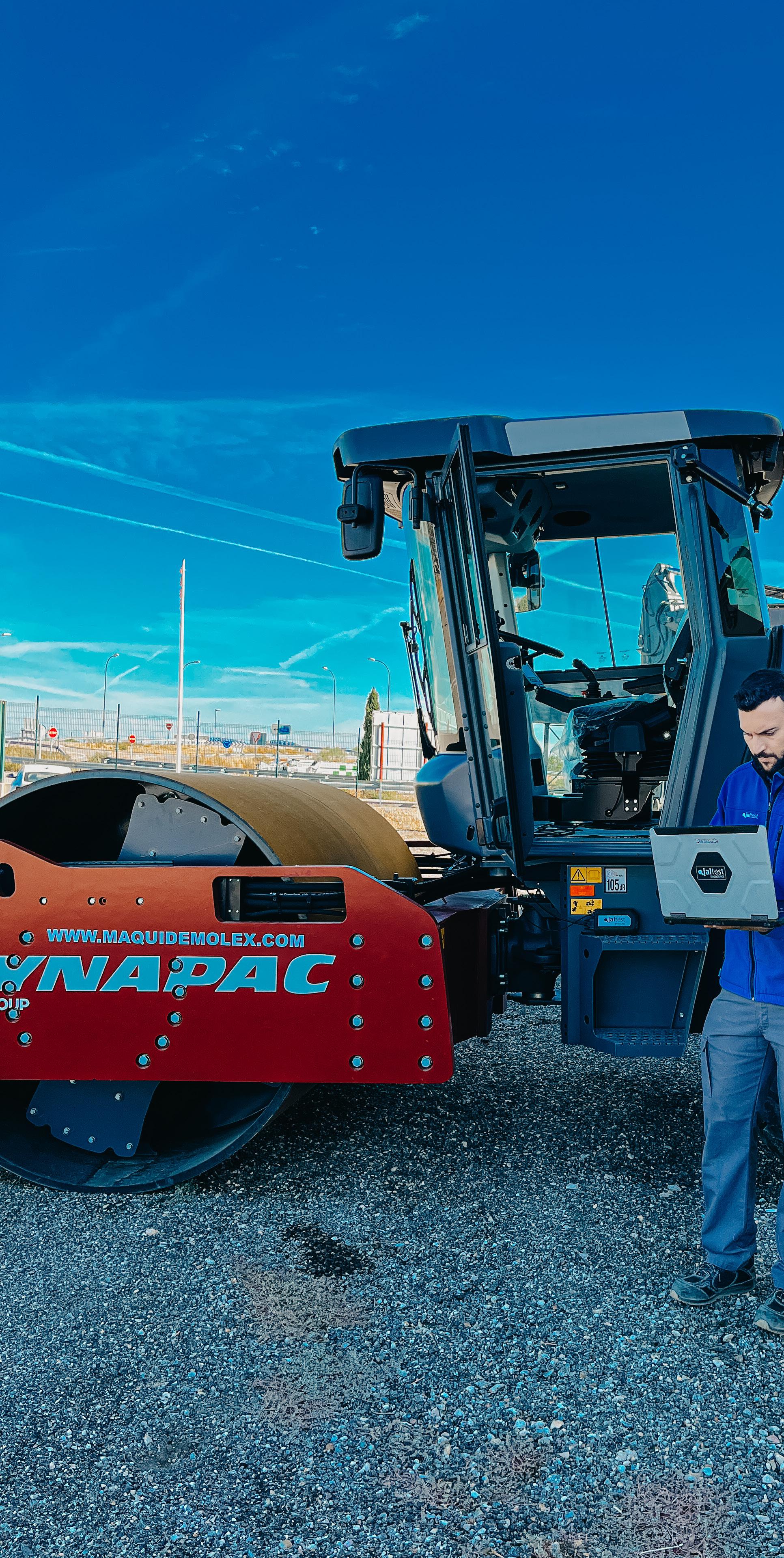
A diagnostic tool provides comprehensive technical information for every make and model of construction equipment.
scheduled services to ensure optimal performance.
˜ Purposeful equipment use ensures that each piece serves its intended function while maintaining fleet adequacy involves aligning the fleet size with operational needs.
˜ Strategic machine rotation ensures timely servicing by periodically shifting machines.
Training
Operator training plays a crucial role, covering comprehensive instruction on controls, modes, and technology.
Understanding limitations is vital, ensuring operators grasp and comply with machine specifications. Regular cleaning and inspection, coupled with fluid management best practices, involve maintaining cleanliness and regularly inspecting and adjusting equipment and components.
OEM Schedule
Adhering to the original equipment manufacturer’s (OEM) service schedule is essential, strictly following the OEM’s suggested service intervals. Prompt repairs are key, addressing
16 EQUIPMENT TODAY | April/May 2024 www.ForConstructionPros.com/Equipment
Cojali USA

part repairs or replacements at the first sign of need. Encouraging timely diagnostic scans empowers operators to identify potential issues and conduct maintenance tests when necessary, such as cylinder cutouts, diesel particulate filter (DPF) regens or other routines aligned with manufacturer recommendations.
PM With a Diagnostic System
With PM, the team anticipates and replaces parts before they break. The challenge lies in identifying which parts and when without unnecessary
replacement of components still in good condition. PM, the cornerstone of modern equipment care, involves a strategic plan to anticipate and address potential issues before they escalate, ensuring a longer lifespan for heavy equipment and minimizing the risk of unforeseen failures.
However, despite its prevalence, many companies grapple with doubts during implementation, leading to half-hearted adoption or no plan at all. If contemplating the old “run it till it breaks” mentality, consider the hidden costs—high repair expenses, prolonged downtime and the frustration of waiting for parts. Embracing PM, on the other hand, is an investment in efficiency and return on investment, shielding against the unknown and safeguarding growth potential in the medium and long run.
Now, let’s assume a commitment to implement some level of PM in equipment operations. How is it determined? In most cases, PMs are defined by the fatigue cycle of parts. If an element typically lasts 20,000 miles, change it just before reaching that point.
Maintenance schedules revolve around usage, time triggers and other factors, ensuring a proactive approach to equipment care. However, does PM rely solely on manufacturers’ information, demanding that your service team possess manuals for each piece of equipment.
The answer is no. A more streamlined alternative exists: A robust, dealer-level diagnostic tool that opens provides comprehensive technical information for every make and model. Diagnostics tools are
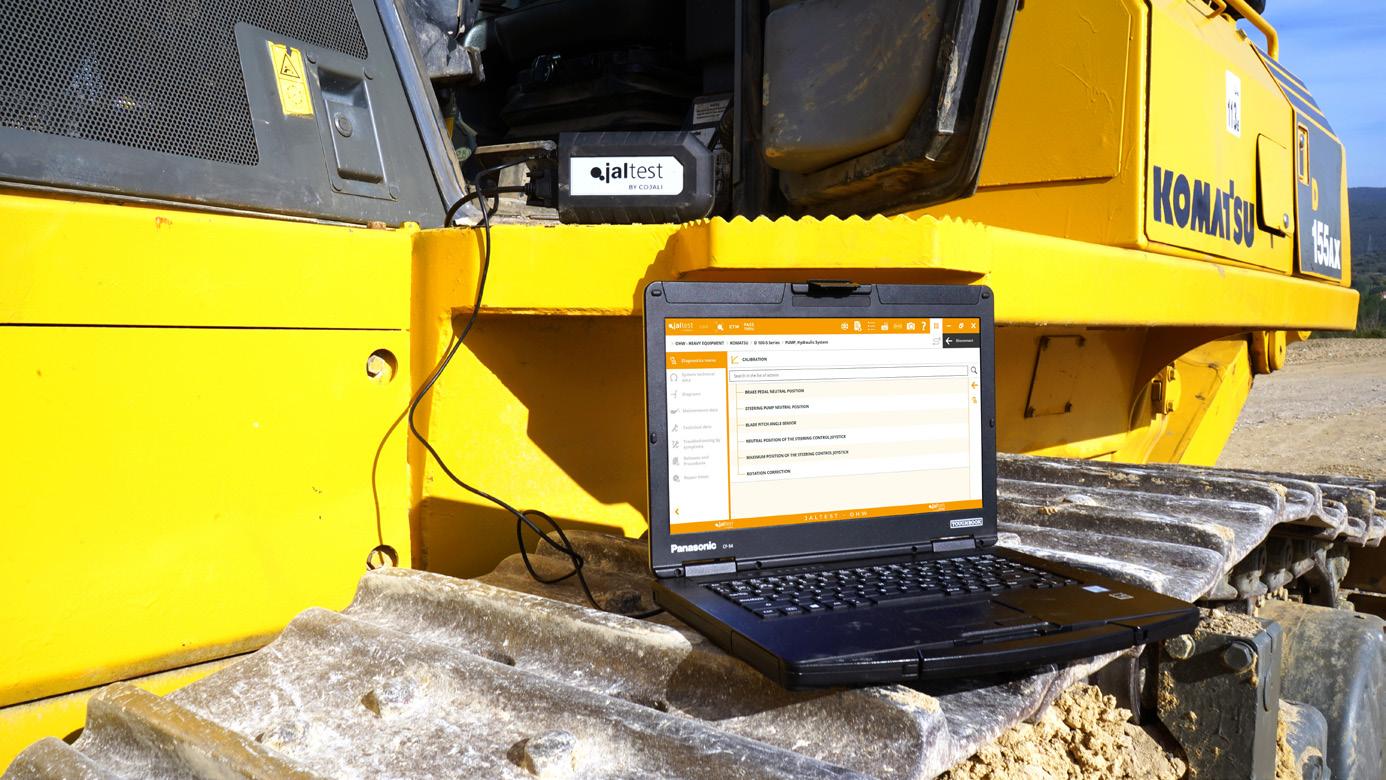
crucial to monitor maintenance, a key for operator’s daily routines. Different tool options are available. With some tools, contractors or operators can:
˜ Schedule routine scans
˜ Conduct specific health measurements
˜ Perform road checks with the diagnostic tool connected
˜ Ensure calibrations before and after changing implements
These capabilities can align with the OEM’s recommendations. Using this integrated and dealer-level tool ensures a proactive stance in equipment care, sparing contractors and operators from drowning in a sea of manuals and steering clear of constant and costly trips to the dealership.
Maintenance Impact
Take a moment to evaluate the true impact of maintenance on your operational costs. Consider whether in-house equipment repair maintenance aligns with your objectives and, if so, whether you have the optimal tool to elevate the care of your equipment inventory. As you navigate these considerations, think about a diagnostic tool for costeffective and seamless equipment operations.


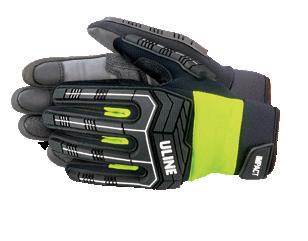
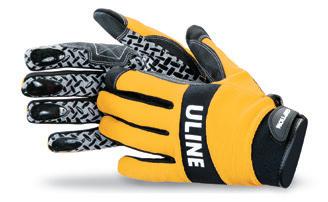
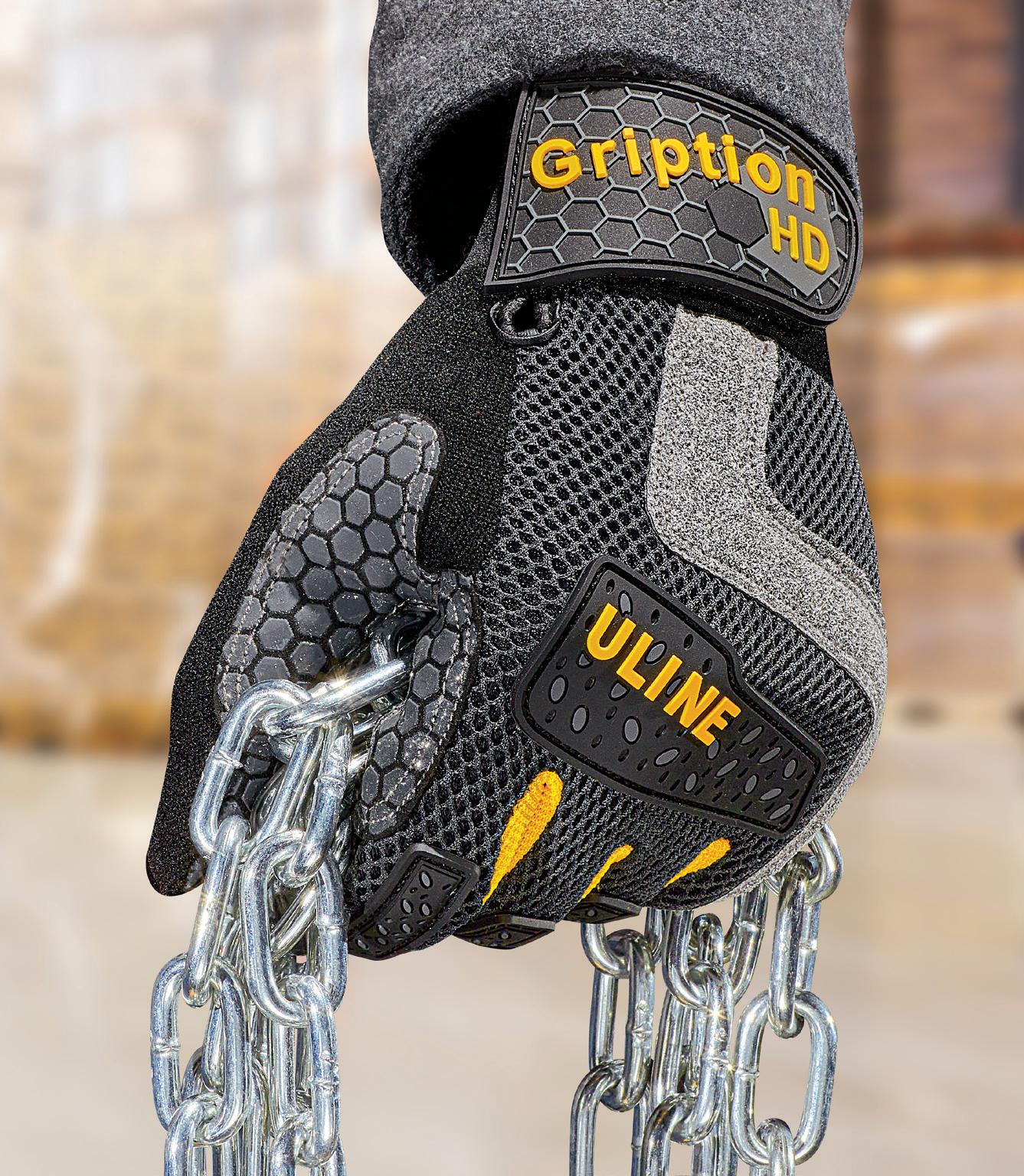
Read more at: eqtoday.co/DiagnosticPM Maria Grimon is the marketing director for Cojali USA, Inc. April/May 2024 | EQUIPMENT TODAY 17 ORDER BY 6 PM FOR SAME DAY SHIPPING 1-800-295-5510 uline.com HEAVY DUTY GRIPTION® π TOUGH GLOVES FOR ANY JOB GRIPTION® FLEX CUT RESISTANT GRIPTION® SPECIAL SECTION: Aftermarket GPS & Maintenance Cojali USA Cojali USA Embracing PM is an investment in efficiency and return on investment, shielding against the unknown and safeguarding growth potential.

Maximize Telematics Data With Equipment Maintenance Programs
Powerful maintenance management software complements telematics by providing a centralized place to collect data from multiple sources and put it to work.
Telematics capabilities from equipment manufacturers and third-party specialists deliver more data with less effort. They are also presenting contractors with a new challenge: How do contractors aggregate the information and turn it into intelligence that helps them increase uptime; cut maintenance costs; improve safety; and ultimately, make more informed decisions about purchasing, deploying, and maintaining assets?
A comprehensive maintenance management software application is an important part of the answer and should act as one of four cornerstones—alongside and integrated with telematics, scheduling and accounting/enterprise resource planning (ERP) systems—to ensure maintenance process efficiency.
Complementary Roles
Managing telematics data would be easy for a contractor with one piece of equipment or even with a handful of assets from the same manufacturer, but that’s rarely the case. Mixed fleets and multiple systems are the norm. Complexity increases along with both of those factors.
Used to monitor equipment remotely and automatically and relay that data for analysis, telematics technology is an increasingly vital asset for construction maintenance programs. Relying on manual recording of meter readings and asset locations increases labor and introduces opportunities for
errors. More importantly, delays in communicating the information can derail compliance with preventive maintenance schedules and the efforts to plan maintenance work efficiently.
Effective maintenance management software complements telematics by providing a centralized place to collect data from multiple sources and put it to work. This data can trigger preventive maintenance while maximizing mechanic efficiency and uptime.
The maintenance application should be agnostic, allowing it to receive and process telematics data from multiple sources. The Association of Equipment Management Professionals (AEMP) has been integral in this regard. Since 2010, AEMP has provided, and continuously updates, standards for how telematics data is formatted.
AEMP standards encompass a wide range of equipment data points that should be included, with the most common being:
• Serial number
• Asset ID
• Location
• Odometer reading
• Hours
• Distance traveled
• Fuel consumption
• Transport mode indicating that an engine is not running but the asset is being moved
The standardization effort has promoted innovation, data sharing and transparency alongside the evolution of telematics technology.
AEMP standards make integrating and consolidating data from different complying sources easier.
A maintenance software application can be programmed to find those sources and know how often it should ping them to get data.
Some contractors import data continuously. Others import daily or weekly. Connectivity and work order processes or telematics provider financial terms can impact timing decisions.
Centralized Equipment Data
A core capability of maintenance applications is offering one location that stores the basic information about each individual piece of equipment. This data includes everything from specifications, parts, and warranties for the financial and repair history. This module within the software is also where meter readings and the GPS location come in from telematics.
Automation is ideal, but contractors should also be able to incorporate meter readings and locations into the application from other sources, such as daily field logs, inspections, repair requests or work orders. This helps with validation and is beneficial in the common scenario when some assets within a fleet have telematics and some do not.
The obvious advantage of the maintenance application is that, regardless of where meter and location readings come from, they
are in one place where they can be reconciled.
Otherwise, contractors must pull data from multiple sources, adding layers of complexity to their analysis and maintenance planning efforts.
Preventive Maintenance & Work Orders
Another basic element of effective maintenance management software is a “maintenance programs area” where managers enter the suggested preventive maintenance schedule for each asset. Using the comprehensive, centralized data—including meter readings and location—from the equipment area, the programs area can create repair requests automatically at the proper intervals for the preventive work. These requests are triggered by meter readings, calendar dates or both.
The ability to program alerts with sufficient lead time is a key feature to look for in software. Seeing that a 100-hour service is coming up when a piece of equipment hits 80 hours or 90 hours provides time to schedule that work at the most efficient and least disruptive time.
Meter readings and locations for each asset also come into play in the work order processing module of a maintenance application. Within an electronic work order for one piece of equipment, for example, a manager or mechanic can use the telematics data to search for other assets within a designated radius that have current or upcoming maintenance requirements.
18 EQUIPMENT TODAY | April/May 2024 www.ForConstructionPros.com/Equipment SPECIAL SECTION: Aftermarket GPS & Maintenance
The obvious advantage of the maintenance application is that, regardless of where meter and location readings came from, they are all in one central place where they can be reconciled.

This provides efficiency advantages in scheduling mechanics.
Integrating Parts, Inventory & Purchasing
Maintenance management software can also make managing parts for preventive maintenance much easier. The relevant parts for each service level can be added ahead of time, and the software can use that data to plan for parts procurement, giving contractors the peace of mind that their equipment’s required parts are in stock or available.
Predicting part needs, reviewing inventory levels, and automating the requisition and purchase order process through maintenance management software allows preventive maintenance service levels to be planned more efficiently with the right parts at the right time.
For break repairs, replacement parts are not directly impacted by telematics. Like managing telematics data, however, managing parts purchasing and inventory can be more effective and efficient with a holistic approach and with a maintenance application playing a central role. Maintenance management software can easily manage this workflow.
Contractors can import or enter a database of replacement parts for each piece of equipment into the maintenance software whether those parts are routinely inventoried or purchased as needed. Integrating the maintenance software with the
accounting/ERP system has several efficiency and reporting advantages. Mechanics or managers can see if parts are inventoried and available and where they are within the maintenance application. When parts are added to a work order, the information goes to the accounting
system automatically, so inventory can be adjusted, and parts can be reordered as needed.
Purchase orders for parts can
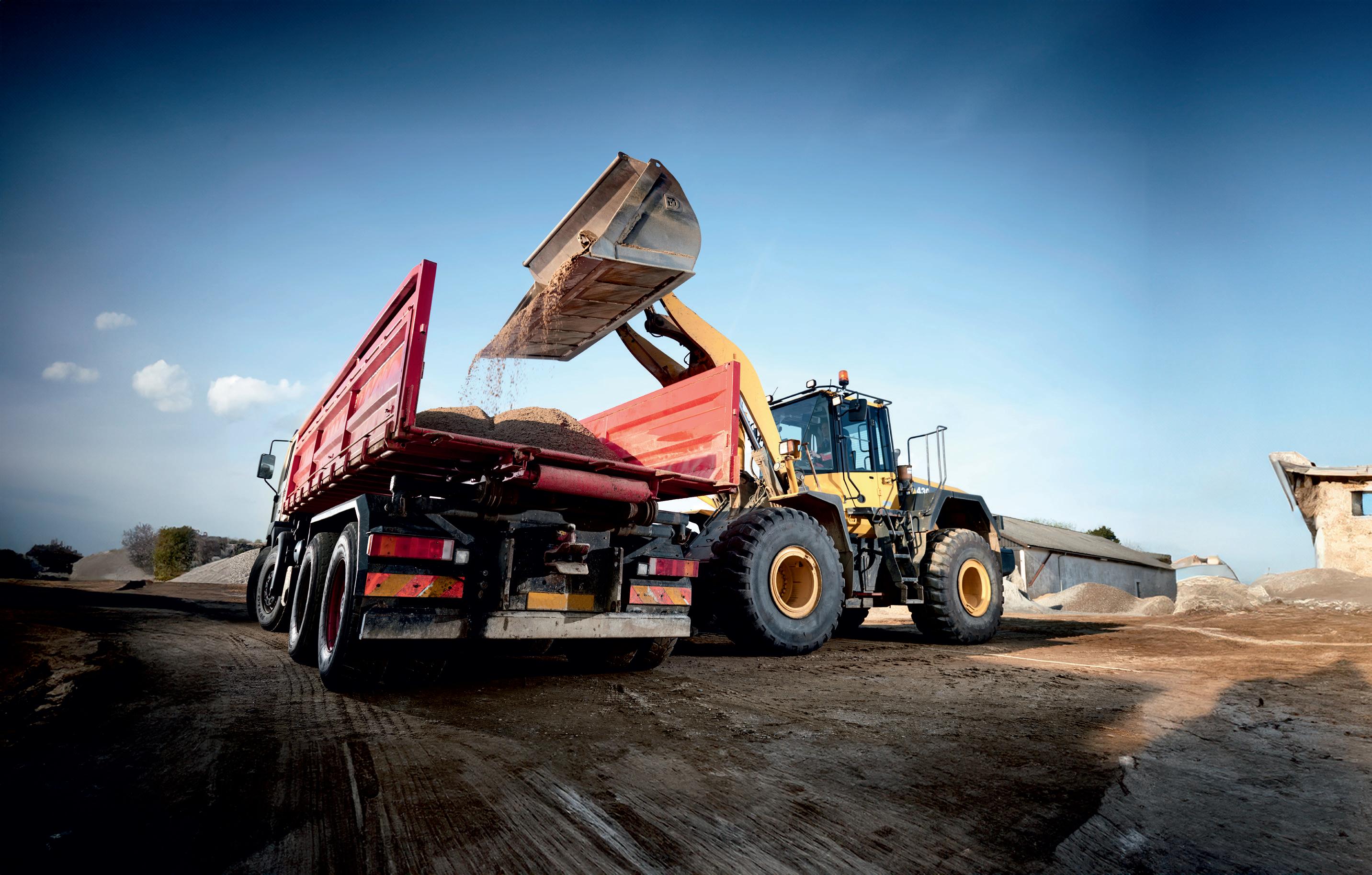


more at:
April/May 2024 | EQUIPMENT TODAY 19 www.ForConstructionPros.com/Equipment
Read
eqtoday.co/MaxTelematics
@ake1150adobe.stock.com
Compact Track Loaders: Benefits & Challenges
Is a CTL right for your business? Understand the advantages, drawbacks and machine capabilities.

The construction contractors’ ability to maximize productivity while minimizing expenses directly impacts their potential for business growth. Heavy equipment owners and operators need resources to increase their efficiency and stay competitive.
“Do more with less” is the means to success.
More contractors are turning to the machine that can seemingly do it all: the compact track loader (CTL). With its low ground pressure and ability to operate a vast array of attachments, the CTL handles many applications in a compact package that many contractors consider to be easy to use and learn.
Because of these benefits, CTLs are one of the fastest growing, construction equipment segments. According to Transparency Market
Research, the CTL market, which was worth $27.5 billion in 2022, is expected to grow at a compound annual growth rate of 5.2% to reach $43.6 billion in sales by 2031.
CTLs are gaining popularity for good reason, but contractors must understand CTLs to help determine if they’re right for them and how to get the most out of them.
Complete Versatility
By design, the compact equipment industry exists to provide contractors with a powerful machine in a small package.
“The lifting capacity and the hydraulic power of those machines translate to being able to run a … wide variety of attachments, making it … [a] versatile machine,” said Emily Pagura, solutions marketing manager, John Deere.
The CTL’s ability to use many attachments—from buckets to augers to laser grading systems—makes it an attractive option. However, the low ground pressure offered by the machine’s tracks is what sets the CTL apart from other compact equipment.
The large surface area of tracks provides CTLs with better flotation and maneuverability on uneven terrains and softer grounds like sand or mud than wheeled loaders. Tracks also provide low ground pressure, making CTLs less likely to tear up the turf on jobsites than wheels, according to Doug Clark product manager of compact equipment, Wacker Neuson.
“Tracked models are more efficient on softer ground. Having said that, the track platform also generally allows for greater tractive force on unstable surfaces like sand,” said Clark. “They are far better on broken ground
than wheeled units, while only being slightly less maneuverable on concrete or asphalt.”
Because CTLs perform well across different terrains and operate different attachments, they are a solid fit for many applications, including earthmoving, snow removal, paving, landscaping and hardscaping. For example, Pagura explains the CTL’s handling of uneven terrains makes it useful for vegetation management projects with attachments like stump shredders, mulching heads and rotary cutters.
“To be able to do all of that with one machine just gives the contractors the opportunity to do a lot of different types of work,” said Pagura.
Strong ROI
In addition to a competitive edge, CTLs offer contractors a positive return on investment (ROI). Like most compact equipment, new CTLs can be purchased for tens of thousands of dollars, while new large heavy equipment like excavators typically run upwards of $100,000.
“There is a much lower total cost of ownership when compared to larger machines,” said Adam Ford, product manager for Hyundai Construction Equipment Americas, which announced its re-entry into the CTL market with the HT100V at last year’s CONEXPO-CON/AGG.
He believes the CTL’s reliability and cost of service are two major benefits consumers should consider. The machine is easier to service when compared to larger machines, primarily because of the CTL’s small size and “the nature of its architecture when it comes to hydraulics and how the power chain is laid out.”
According to Ford, the CTL makes financial sense when considering its usage rate. Contractors will get more for their investment in the machine than they might from large, dedicated equipment, because of its versatility.
“When [contractors are] looking at their fleet, they’re looking at how often this piece of machinery is being
20 EQUIPMENT TODAY | April/May 2024 www.ForConstructionPros.com/Equipment SPECIAL SECTION: Compact Track Loaders
Hyundai
The Hyundai HT100V CTL working in a gravel-hauling application.
A CTL’s size and complexity level may be less intimidating for a beginner.

utilized,” he said. “The CTL utilization rate is going to be much, much higher than a machine that is only used for one specific function at one point in the job.”
The CTL can tackle a range of jobs, whereas “without a CTL, you have to have bespoke machines to do each separate task.”
Increased Efficiency for All Skill Levels
The ongoing shortage of skilled laborers is a factor for many contractors considering a new machine for their fleet. New machines often come with a learning curve, even for more experienced operators. This is no exception with the CTL, although the machine’s size and complexity level may be less intimidating for a beginner, according to Ford. Additionally, CTLs on the market today are available with technology that cannot only reduce the learning curve but also make operators of any skill level more efficient. Some of these include:
˜ Return to position automation –Many equipment makers provide the capability to outfit their CTLs to automate specific movements, such as with John Deere’s EH Boom Performance Package. “This allows the operator to preset positions for return to dig, return to carry and boom height kick out,” said Pagura, adding that automating sequences of repetitive tasks “lets an operator get that right every time,” eliminating the risk of operator error. The productivity-boosting feature is available as a factoryinstalled option on Deere’s 331G and 333G CTLs and will be available on the upcoming P-Tier large-frame CTLs, the 331 P-Tier, 333 P-Tier and 335 P-Tier, which are slated for release in summer 2024.
˜ Self-leveling technology – Similar to return to position, self-leveling technology keeps the bucket level for the operator to prevent the loss of materials while the boom
˜ Fully electric – “To bring the T7X to life, we partnered with Moog, Inc., a worldwide developer of motion control components and systems for industries ranging from aerospace and defense to construction. Together, we took a holistic view of the machine’s system, which is what enabled us to engineer a purely electric solution,” said Joel Honeyman, vice president of global innovation, Doosan Bobcat.
Maintenance Requirements
While contractors can expect lower service costs for CTLs than large heavy equipment, they may encounter more maintenance issues compared to skid steers or other wheeled equipment.
being easy to move does make it easy to steal,” according to Ford. Several actions help protect assets:
˜ Ovrebo said, “Common sense goes a long way.” With that, owners should take common sense measures, such as always ensuring that the machine is locked up, the battery switch is turned off and the key is removed.
˜ Since the machine is easy to transport, operators should do what they can to make transportation more challenging for thieves. Ovrebo suggests blocking the CTL and keeping it out of sight of passersby.
is in motion. Many equipment producers make this feature available on CTLs. “Automating the more methodical processes gives the operator the ability to focus on other aspects of the machine to create a safer and more efficient worksite,” said Peter Ovrebo, product management director, Yanmar Compact Equipment North America. Yanmar entered the CTL market for the first time at last year’s CONEXPO, with its TL65RS, TL75VS, TL80VS and TL100VS models, which can all be outfitted with the ability to automatically level the load while raising and lowering the boom.
˜ Grade-assist technology – Grading can also be automated on some CTLs. With grade assist, the machine automatically adjusts the attachment position for a final grade, which can be a challenging manual task for a rookie. Deere offers this capability with SmartGrade, a full 3D grade control that is currently available on the 333G and will be available on the upcoming P-Tier models.
˜ Display panel dashboards and metrics – Touchscreen displays on many CTLs have become more sophisticated, presenting operators with vital information and functions to streamline their workflows. Kubota’s SVL753 includes a 7-inch color LCD touch panel with a jog dial. The screen displays the standard rearview camera, the battery charge, hydraulic oil and coolant temperature, auxiliary mode, and fuel level, according to Jerry Corder, Kubota product manager, construction equipment. “The touchscreen allows operators to get information clearly and concisely and in a way that can be interpreted by novice to experienced operators alike,” he said.
“The tracks on the CTL’s undercarriage just adds another system that you need to maintain and do preventative maintenance for,” said Pagura.
The best way to overcome the potential maintenance issues is to stay ahead of them with proactive scheduled preventive maintenance and inspecting the tracks daily. Pagura said that these daily checks include cleaning the track system and frame; removing debris; and examining the tracks for damage.
“You’re looking for any cracking, anything that’s starting to look dry or excessively worn down. You’re looking for uneven wear from the outside to the inside of the track,” she said. “Having an operator doing this regularly can help you identify issues before they create downtime.”
Understanding how tracked machines drive on different terrains can also help contractors preserve track integrity. Operators should take special care on concrete or asphalt. According to Pagura, while CTLs can handle paved surfaces, “a lot of skidding or sharp turning is going to wear down … tracks faster.”
Contractors can also decrease unexpected downtime by using advanced monitoring systems. Deere’s CTLs come standard with perpetual access to John Deere’s Operations Center, formerly JDLink. The telematics system tracks the machines’ health and can provide owners with notifications of diagnostic trouble codes on the machine’s display or a mobile device.
Each of Yanmar’s CTLs can incorporate optional SmartAssist telematics for error detection, notifications and real-time updates on the machine’s operational status and productivity.
Theft
One risk contractors should be aware of is the CTL’s potential for theft. While CTLs are not known to be more susceptible than any other compact equipment, the machine’s “benefit of
˜ Some CTLs are equipped with the ability to establish custom pins for owners and operators. For example, Yanmar’s Ignition Interlock requires operators to enter their custom pin using the touchscreen display to start the machine.
˜ Another benefit of machine telematics that many modern CTLs offer is the ability to track the machine’s location. Hyundai’s HI-MATE telematics solution, which comes standard on its HT100V, will notify the owner or fleet manager if the CTL has been moved after work hours and can track its location in near real-time. According to Ford, HI-MATE has been used in conjunction with law enforcement to successfully locate stolen machines.
Make the Choice: Understand the CTL’s Capabilities
While the benefits and challenges of CTLs may be clear, contractors who match CTL’s capabilities and their needs will optimize their productivity, efficiency and ROI. This is where dealers and rental houses have an important job to do.
“Helping the customer identify what their job is going to be and making sure that a CTL is a good fit is key,” said Ovrebo.
Communicating the machine’s capabilities and limitations helps contractors determine the best match.
“I think any size could be a great addition to a jobsite,” said Pagura. “But it is important to match the machine to the space you have and the task at hand, and more specifically, to the attachments that you’ll be running.”
April/May 2024 | EQUIPMENT TODAY 21 www.ForConstructionPros.com/Equipment SPECIAL SECTION: Compact Track Loaders
Read more at: eqtoday.co/CTLBenefits0424
Rybak is a freelance writer for Equipment Today
Grace
Wacker Neuson
In some scenarios, the higher reach makes it possible to load a truck more efficiently from one side instead of spending time loading from each side of the truck.
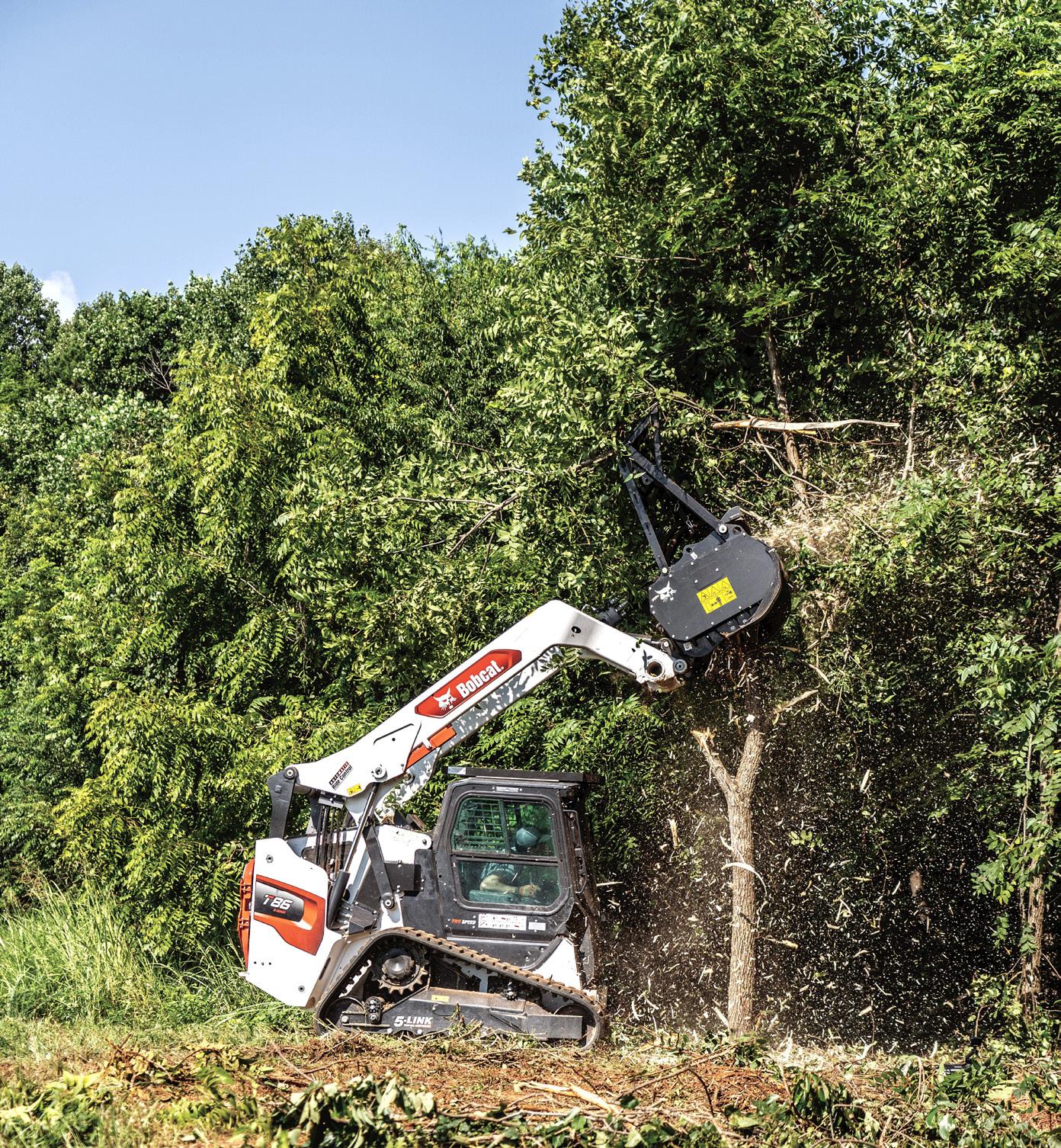
Compact track loaders are known for their lifting performance and operating capacity, making them a good choice for many tasks. However, with a wide array of options available, selecting the right compact track loader might seem daunting.
When evaluating potential machines, consider the application requirements and jobsite needs. Additionally, weigh the opportunity costs for selecting a machine for new markets or jobs as part of your business plan. Adding a large compact track loader to your fleet can open new avenues for your business, increasing productivity and ROI.
Consider the following factors as you assess the benefits of adding a large compact track loader to your fleet.
Stronger Workload Performance
In the world of heavy-duty work, the size of your loader matters. Larger machines can carry, scoop and lift more material, saving time and money. With higher-rated operating capacities (ROC), larger compact track loaders enable you to lift heavier loads, which may result in taking on more jobs.
If you regularly work with substantial loads of gravel, heavy clay, palletized block, sod, or baled commodities (or baled materials or just bales), the greater ROC of a larger loader is essential.
Large compact track loaders excel in tough ground conditions, with the horsepower and traction to traverse mud, sand and loose dirt. Their rubber tracks minimize ground disturbance, making them ideal for landscaping jobs, digging and loading materials, and grading projects.
FOUR REASONS TO ADD A LARGE COMPACT TRACK LOADER TO YOUR FLEET
Selecting the right compact equipment and attachments is crucial for optimizing ROI and boosting profits on jobsites.
Higher Lifting Capacity
In addition to the weight of the loads, the lift height is a critical consideration for your jobsite requirements. If your tasks involve regularly loading trucks, transporting and placing pallets, or dumping contents over tall barriers, the lift height of a compact track loader is as important as its ROC. Understanding your lift height and ROC demands is essential, but the lift path is also a key consideration.
A vertical lift path offers greater reach at full height and a higher lift capacity. Some large compact track loaders that come with a vertical lift path can lift materials 11 feet off the ground to load trucks, transport and place pallets, or dump contents over taller walls.
In some scenarios, the higher reach makes it possible to load a truck more efficiently from one side instead of spending time loading from each side of the truck.
A radius lift path is ideal for jobs with midrange or lower working heights. This lift path positions the load farther from the machine earlier in the cycle, offering maximum reach at eye level. Pallets can be placed farther onto lowerheight trailers and materials can be loaded easily into dump trailers with this type of lift arm configuration.
22 EQUIPMENT TODAY | April/May 2024 www.ForConstructionPros.com/Equipment
1 2
SECTION: Compact Track Loaders
Bobcat
SPECIAL
Larger machines can carry, scoop, and lift more material, saving both time and money.
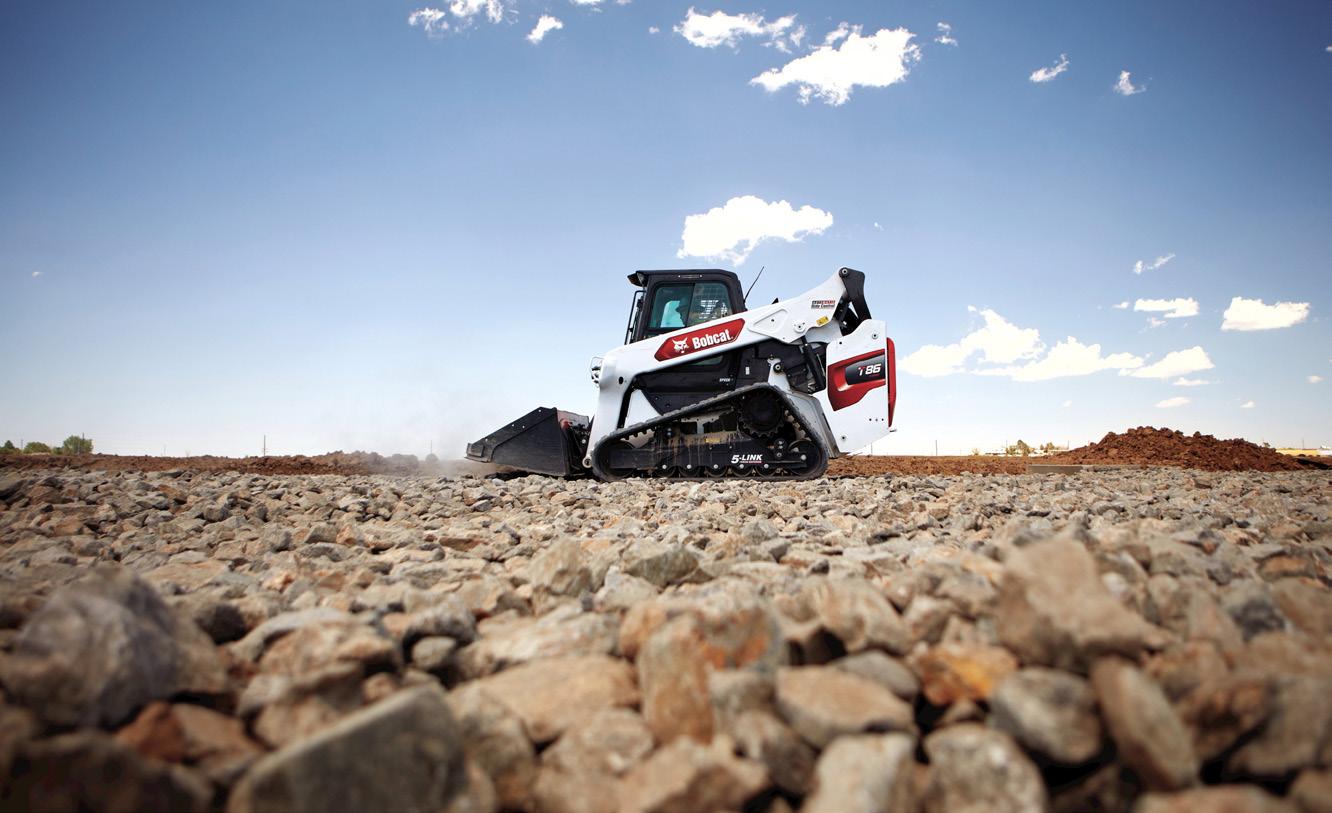
Different Attachments
The versatility of a large compact track loader is maximized by its extensive attachments, making it a year-round asset.
By equipping a single machine with different attachments, businesses can enhance efficiency and minimize unnecessary costs, providing a practical alternative to taskspecific equipment and subcontracting.
Attachments can help with clearing land, grading sites, planting trees, moving pallets and removing snow. Large compact track loaders provide more hydraulic flow to attachments, making them ideal for many demanding tasks. These machines provide mobility and versatility, making them a go-to jobsite solution.
Versatility for Different Jobs
Selecting the right compact equipment and attachments is crucial for optimizing ROI and boosting profits on jobsites.
Large compact track loaders stand out as a smart investment, offering speed, power and capacity to handle the toughest tasks. With unmatched productivity, they’re a game-changer for any fleet.
Hyundai HT100V Compact Track Loader
The HT Series model features a Tier 4 Final-compliant Hyundai engine that provides power while meeting emissions standards. The compact track loader is powered by a Hyundai HTI4 four-cycle, turbocharged, electronically controlled diesel engine.
The new engine meets Tier 4 Final and E.U. Stage V emissions standards and delivers 70 net hp (52 kW) at 2,200 rpm. The Hyundai HT100V has a rated operating capacity of 2,300 lbs. (1,220 kg) and its heaped bucket capacity is 0.58 yd.3 (0.44 m3).
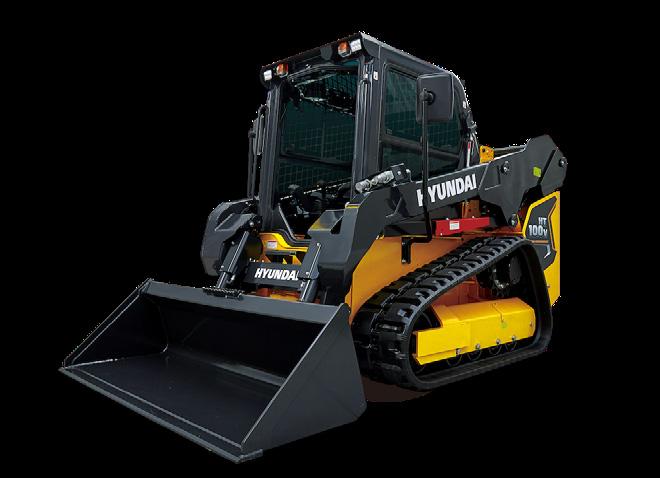
Standard features include a multifunction joystick enabling operators to control all machine functions with their hands only; a vertical lift path that allows the boom to raise the bucket straight up to full height for stability, less spillage and lift height; and two-speed travel enabling movement around the jobsite.
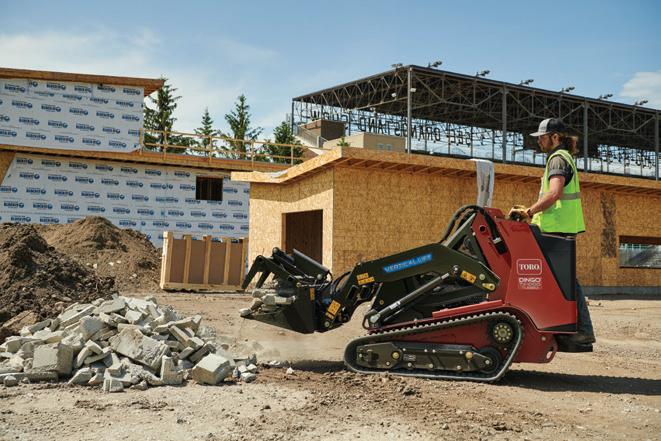
Toro Dingo TX 1000 TURBO
The Dingo TX 1000 TURBO has a large hydraulic filter for long maintenance intervals. The narrow-track model is 2,826 lbs. (1,282 kg) and features a standard track with B-style tread. The wide-track version is 2,911 lbs. (1,320 kg) with a less aggressive tread pattern.
The Dingo TX 1000 TURBO has a rated operating capacity of 1,000 lbs. When the loader arms are at full reach, the hinge pin measures 81 in. from the ground to allow the machine to reach over the side of dumpsters and one-ton trucks. The 24.7-hp Yanmar diesel engine is engineered with a focus on vibration reduction, delivering up to 4.1 mph of ground speed in both forward and reverse. The machine features a single diesel fuel tank (10.25 gallons) on the operator’s left-hand side and the hydraulic oil reservoir on the operator’s right-hand side for serviceability.
CASE New Mini Track Loaders & Small Articulated Loaders
The new, stand-on TL100 mini track loader offers crews a powerful attachment platform in a compact machine. Additionally, the new line of six small articulated loaders—including a telescopic model and an all-electric model launching in early 2024—will give contractors a variety of options and power ranges to meet their challenges.
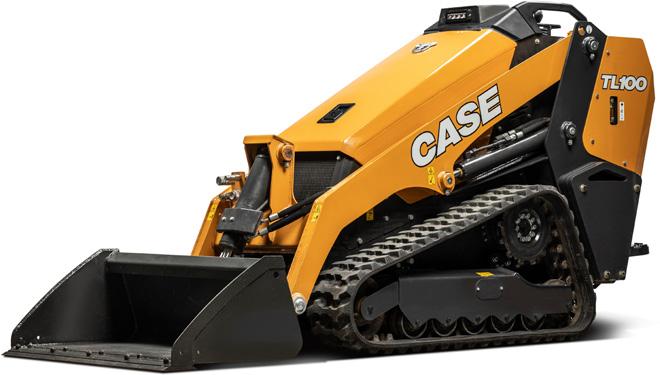
Both product lines bring a new level of power and flexibility to small machines. With an operating capacity of 1,000 lbs. and a compact profile that can maneuver through yard gates, tree groves and other tight areas, the new TL100 mini track loader gives contractors a reliable machine on worksites. The 24-hp track loader also features a 14-pin electrical connector and a common industry interface for attachment flexibility and performance. With over 40 attachment options available, the TL100 can handle the work of multiple laborers on jobs like digging, earthmoving, setting fence posts, grappling brush and grading.
CASE Construction Equipment
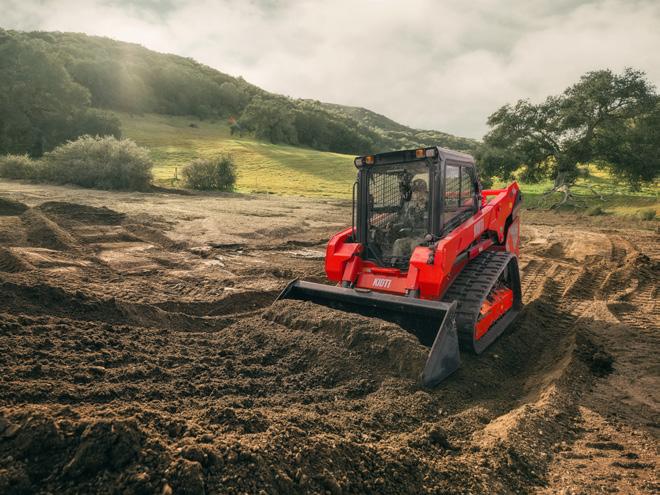
KIOTI TL750 & SL750
KIOTI Tractor’s TL750 Compact Track Loader and SL750 Skid Steer Loader feature a wide cabin, available with the standard open station design or an optional enclosed cab with HVAC. The compact models include a high-back suspension seat and LCD digital display.
The standard roll-up style door allows for easy entry and exit, regardless of the bucket’s or attachment’s position. The overhead door design increases flexibility on the job because operators can work with the door open or closed.
Both models use a 74-hp KIOTI diesel engine. Field-tested across many applications, the engine delivers consistent power and reliability. Designed for rigorous demands, the machines have up to a 10.8-ft. height to hinge pin and vertical lift path. Operators can dump materials into trucks and high-sided hoppers.
April/May 2024 | EQUIPMENT TODAY 23 www.ForConstructionPros.com/Equipment
more at: eqtoday.co/bigctl 3 4 Bobcat
Read
Julie Portillo is a market manager of product planning at Bobcat.
CTL Products

Bobcat T7X All-Electric Compact Track Loader
The Bobcat T7X is powered by lithium-ion batteries. The T7X features a fully electric drive system in place of a traditional hydraulic work group. It’s built with about half the parts and components required for a diesel-engine loader—decreasing maintenance and overall ownership costs.
Producing zero emissions, the allelectric platform offers instantaneous power with no need for a hydraulic system to build up power. The T7X offers an ideal operator experience with drastically reduced noise and vibration and significantly fewer fluids, ideal for urban areas where noise restrictions can limit work hours.


Wacker Neuson ST27 Compact Track Loader
Weighing in at 7,350 lbs., this machine is easily towable and with a rated operating capacity of 1,890 lbs. (at 35% of tip), the ST27 comes with a 74-hp Kohler KDI 2504 turbocharged engine. The compact design, measuring 60 in. wide and under 80 in. in height, offers reach at dump height of 36.5 in.
The ST27 has a hinge pin height of 120 in. and a dump height of 94.3 in. It features a two-speed standard travel drive that offers a 9.1-mph speed resulting in faster cycle times. A standard autoshifting drive system can be active or disabled. It senses the operator’s need to shift. The auto feature engages in and out of the two speeds based on joystick input and eliminates the need for manual shifts.
JCB 300T Compact Track Loader
With a rated operating capacity of 3,000 lbs. (1,369 kg), this 74-hp vertical lift machine is ideal for lifting and loading with the added versatility that comes from the ability to use a many attachments, including blades, tilers and trenchers.
The 42-kW JCB diesel by Kohler T4F engine requires no exhaust aftertreatment. An industry standard quick hitch for quick coupling to JCB attachments and all other brands is included. The standard hydraulic circuit is 70 lpm.
A high-flow option up to 115 lpm is available for maximum attachment versatility. JCB’s Smoothride System option allows for improved load retention and faster loading cycles.
New Holland C330 Compact Track Loader
New Holland Construction’s C330 Super Boom Vertical Lift Compact Track Loader is equipped with a 66-in. working width and a 67-hp engine. The C330 is designed with integrated elements such as low shoulder positioning and towers, which support operator visibility and jobsite safety.
The C330 vertical lift compact track loader features heavy load-carrying capacity to handle the transportation of substantial materials such as rocks, stone and timber. Leveraging electrohydraulic control (E-H), the machine can navigate through tight residential spaces, backyard gates and between buildings. With the E-H controls, operators can transition between ISO and H-Pattern control, granting them full control over drive functions and attachments.
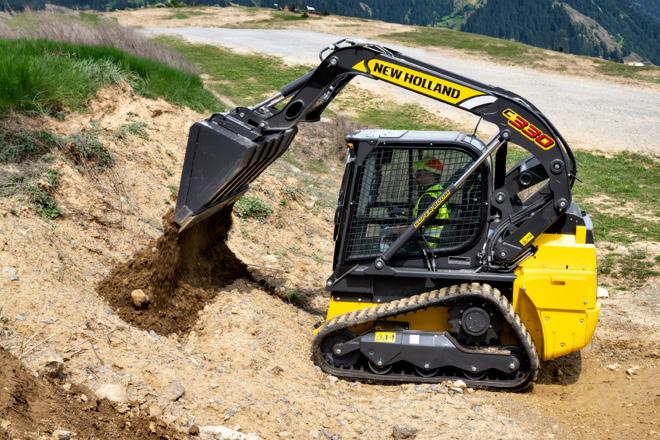
Manitou 1950 RT
Manitou introduced the 1950 RT compact track loader. This 74-hp machine has a rated operating capacity of 1,950 lbs. and high-flow auxiliary hydraulics that make the machine compatible with high-power attachments. It is built with numerous track widths and tread patterns. The radial lift arm design enables ground engaging work.
Added auxiliary hydraulic performance provides a platform for running a range of attachments. The machine includes the IdealTrax track auto-tensioning system, a swingout cooler that keeps the engine compartment clean and engine temperatures down, and the Manitou EasyMANAGER fleet management platform (telematics).


John Deere 335 P-Tier Compact Track Loader
John Deere’s new generation of large frame 335 P-tier compact track loaders are for hauling, surface grading, material loading and equipment transportation on construction sites. The construction vehicles in the P-tier series feature redesigned cabs, heated and vented seats, touchscreen displays, hands-free Bluetooth technology and JDLink telematics.
The machines can also be equipped with optional surround view capabilities. The 335 P-tier and 334 P-tier are optimized for customers who require more horsepower and hydraulic flow from a compact machine. With 118 gross hp in addition to pressure compensated load sensing hydraulics, the vehicles can be used to support demanding applications in rugged work areas.

Caterpillar 255 & 265 Compact Track Loaders
The new 255 and 265 loaders are powered by Cat C2.8T and Cat C2.8TA engines respectively, which offer 74.3 hp (55.4 kW). The new engines maintain horsepower across a wider rpm range and feature torque increases—gains of 13% for the 255 and 43% for the 265 for working performance.
A redesigned engine compartment mounts the engine and cooling package lower into the frame for stability when handling heavy loads. The new 255 loader delivers lift height, and compared to the 259D3, delivers 36% more tilt breakout, 26% higher lift breakout force and a 24% increase in rated operating capacity. Standard hydraulic system pressure is increased to 3,500 psi (24130 kPa). New for these machines, the closed-center auxiliary hydraulic system allows the 255 and 265 to operate all Cat Smart Attachments, including the Cat Smart Dozer Blade, with the standard auxiliary hydraulics provided.
Takeuchi TL8R2 Compact Track Loader
The redesigned TL8R2 offers a tipping load of 6,041 lbs. with an operating weight of 9,182 lbs.
The 74.3-hp turbocharged, Tier 4 Finalcompliant engine features a diesel oxidation catalyst and diesel particulate filter
• Creep Mode, standard on models with high-flow auxiliary hydraulics, enables forward speed to be precisely matched to a particular attachment without having to constantly meter the travel lever
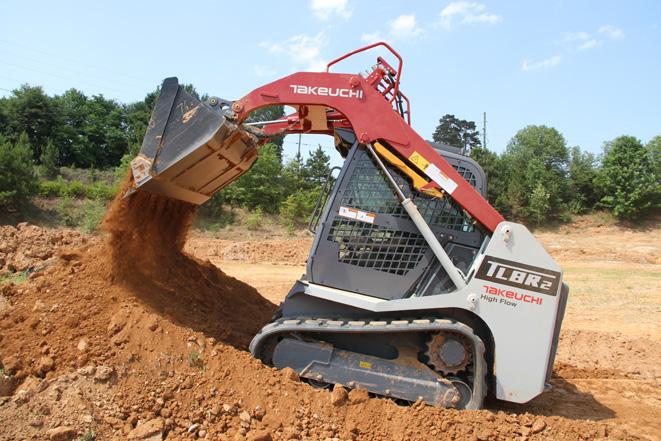
• Automotive-styled operator station includes a 5.7-in. multi-informational color display with rearview camera and sealed rocker switch bank, standard low-effort pilot controls and proportional auxiliary switches
• Optional pressurized cab available
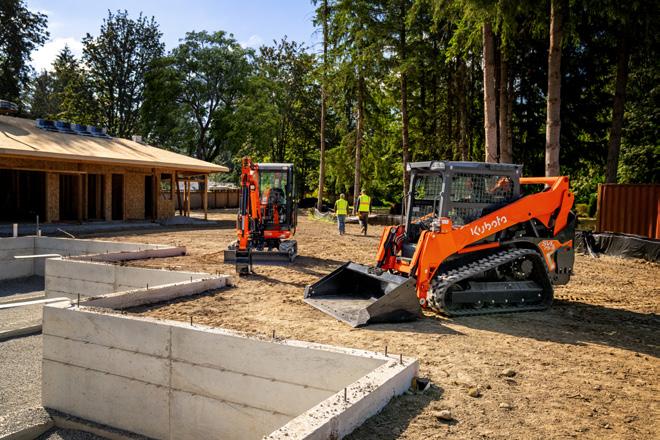
Kubota SVL75-3 CTL
Kubota’s new SVL75-3 is powered by a 74.3-hp Kubota engine and features a rated operating capacity of 2,490 lbs. at 35% or 3,557 lbs. at 50%. The machine generates 6,191 lbs. of breakout force and has a hinge pin height of 122.7 in.
The SVL75-3’s hydraulic system is equipped with an advanced multifunction valve that helps with the movement of all hydraulic functions when operated simultaneously, allowing operators to run the auxiliary hydraulics, bucket and loader arm functions at the same time. Travel features include two-speed travel and the Advanced Auto Downshift system that automatically downshifts from high to low gear while turning, providing the maximum amount of torque needed when exiting a turn. Operators also have the ability to change their travel response sensitivity with the choice of three track response settings: mild, normal and quick.
www.ForConstructionPros.com/Equipment 24 EQUIPMENT TODAY | April/May 2024 CTL Products Read More at eqtoday.co/Compact

Equipment you need. Prices you’ll dig. Attachments, parts, and more. www.ebay.com/heavyequipment
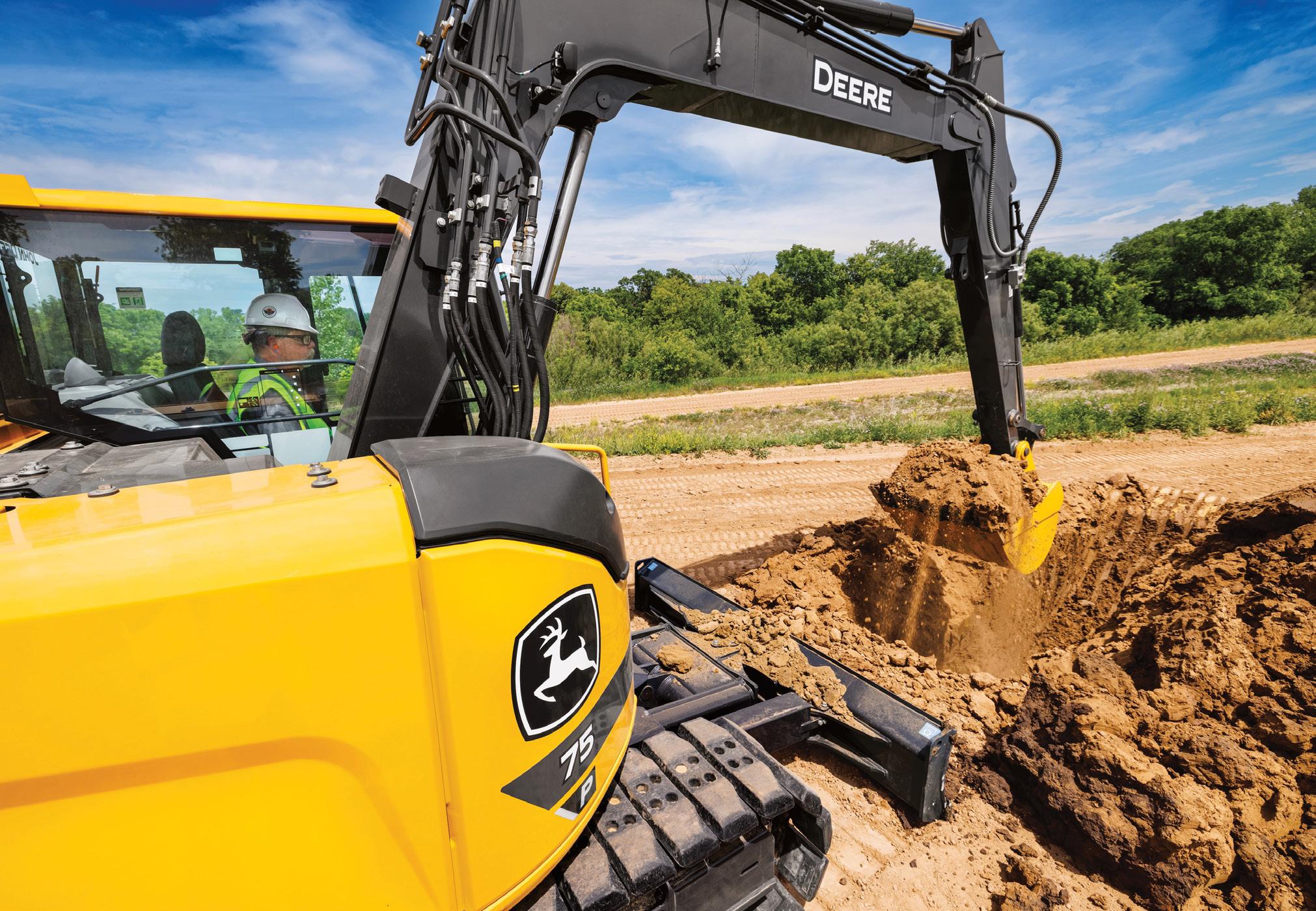
Seasonal changes bring increased temperatures and longer days, introducing challenges contractors and maintenance service providers must consider when purchasing and maintaining equipment, noted Christian Coulis, Milwaukee Tool senior vice president of product management. Summer months are usually the highest productivity months for the construction industry, especially for northern climates, noted Mike Fulton, John Deere service marketing manager. In addition, contractors should pay heed to high ambient temperatures and dust levels, said Will Molnar, Caterpillar product specialist, adding that mulching application debris can present a fire hazard.
Summer Equipment Prep
Jacob Sherman, product and dealer marketing manager at DEVELON, noted contractors and service techs face various equipment-related challenges when working during the hot summer months. High temperatures can lead to overheating and reduced equipment efficiency. They can also potentially cause damage to heavy equipment. In addition, extreme temperatures may lead to fuel issues, affecting engine performance, Sherman said.
“With increased ambient temperatures and an increase in machine usage during this time of the year, contractors and maintenance service providers need to be mindful of the higher productivity and heavy-duty cycles that impact their equipment,” Fulton said.
How to Prepare Equipment for Summer Extremes
From operator health to equipment maintenance, steps can be taken to protect people and assets on construction sites.
“The air tends to get less dense overall. Certain machine components such as turbos have to work harder to get the job done. Additionally, warmer temperatures also can result in condensation build-up in bulk fuel tanks.”
Fulton said that this can be mitigated by draining water from the bulk fuel tanks and ensuring proper filtration to support machine longevity and less downtime. Consider fuel sample analysis from the bulk tank during this time of year to ensure that levels are appropriate for amplified operations, he added.
“With environmental challenges, routine summer maintenance of gas-powered engines becomes an important factor for operators to consider [to] maintain jobsite productivity,” Coulis said.
“Engine issues [because of] overuse and overheating can contribute to equipment downtime on a jobsite, impacting contractor productivity and efficiency. With heightened temperatures and longer days, contractors must regularly tune up their gas engines to properly maintain their equipment for maximum efficiency in application. Unlike gasoperated solutions, battery-powered equipment does not require routine maintenance, making summer challenges a thing of the past.”
Hot pavement accelerates tire wear and increases the risk of blowouts of wheel loaders and wheel excavators. Elevated temperatures can also impact the viscosity of hydraulic fluids and affect hydraulic system performance, Sherman noted.
Summer months are usually the highest productivity months for the construction industry, especially for northern climates.
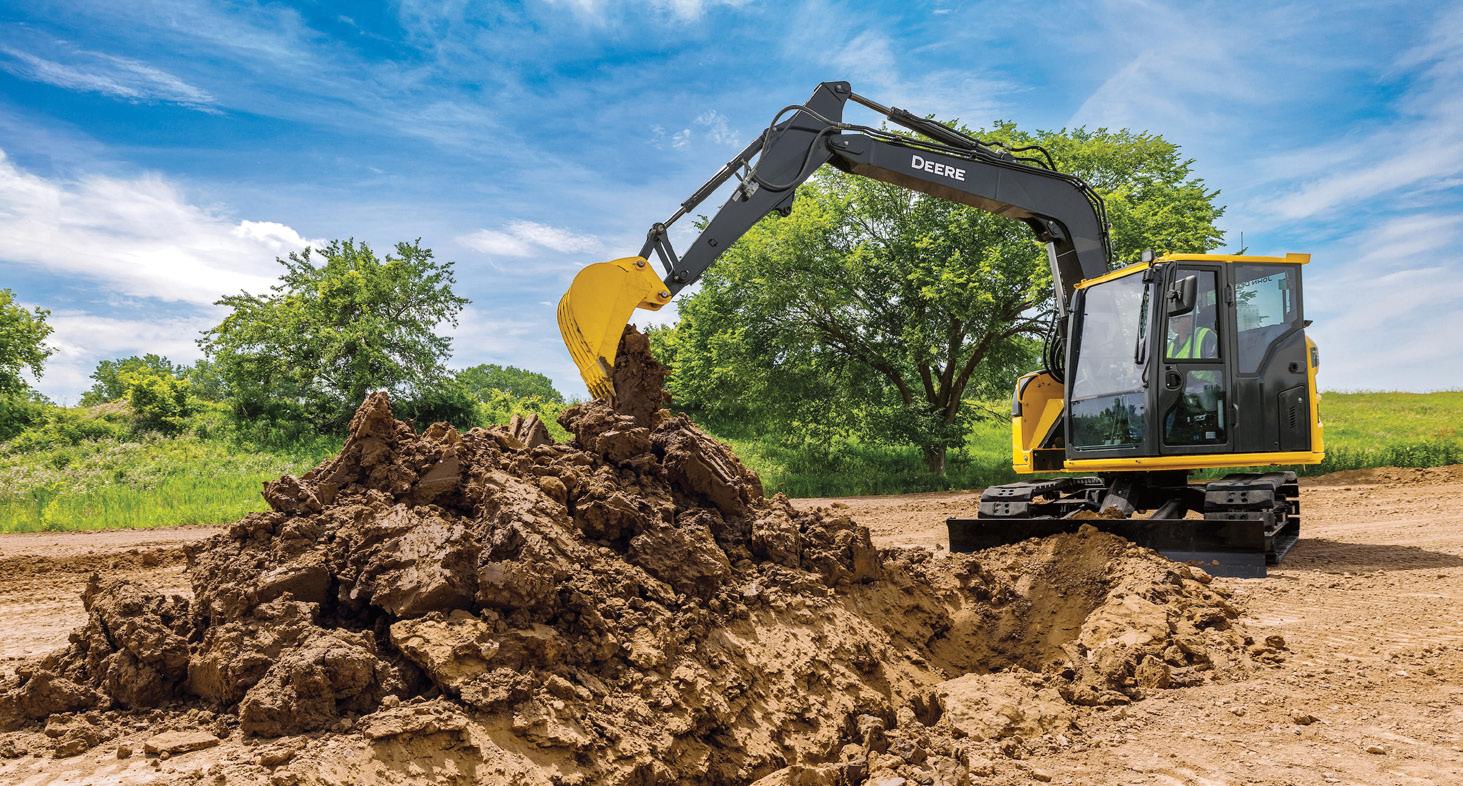
“Summer construction can be dry and dusty, leading to increased debris accumulation in equipment,” Sherman said. “Increased humidity—depending on the region—during the summer months can contribute to corrosion and rust on the equipment.”
Sherman pointed out that high temperatures can lead to uncomfortable working conditions for equipment operators if they do not have an air-conditioned cab and proper air ventilation.
“Regularly service and maintain air conditioning systems, clean filters and address any issues promptly to avoid downtime,” he said. “It’s also a good idea to schedule breaks to avoid heatrelated illnesses and ensure operators have access to water and proper ventilation.”
Molnar noted that, during equipment inspections, contractors should check for animals and bird’s nests.
“Not only can animals be harmed unintentionally, but nests can cause machine fires,” he said.
Keeping the windows and doors shut to prevent dust from entering the cab is important. Maintaining clean windows is important for safety, Molnar added.
Equipment owners and operators should diligently adhere to the maintenance interval schedule outlined in the manufacturer’s maintenance manual, Sherman noted.
“This habit is essential for minimizing excavator downtime,” he added. “Additionally, it is recommended to clean the machine regularly, particularly when performing service or maintenance procedures.”
In preparing construction equipment for summer, Fulton said checking a machine’s components year-round is essential to keeping the machine operation-ready, but
26 EQUIPMENT TODAY | April/May 2024 www.ForConstructionPros.com/Equipment EQUIPMENT MANAGEMENT
Components that can improve visibility include rearview cameras, around-view monitor camera systems and sensors.
John Deere
John Deere
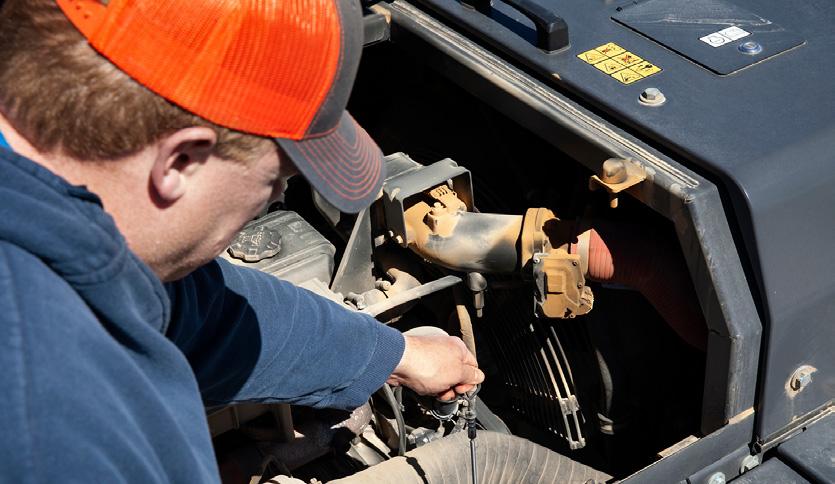
emphasized a variety of components should be examined in the summer.
Summer Maintenance
Experts noted specific components that need to be inspected include:
˜ Fluid and oils: Engine and hydraulic oils and coolant need to be inspected.
˜ Greasing: Check the operation and maintenance manual for grease intervals and the different types of grease needed.
˜ Hydraulic hoses: Check for heat stress.
˜ Air filters: Check and replace air filters regularly for proper airflow and to prevent dust and debris from entering the engine.
˜ Radiators: Water used to rinse them needs to be low-pressure and the part needs to air dry before the machine is put back into service.
˜ Cooling system: Make sure the cooling system is in proper working condition with no damage, has the proper coolant level and is kept clean to avoid decreased machine performance.
˜ Heater core valves: Close them to aid in better operator cab cooling, said Ely.
˜ Fans: Examine for full functionality, damage and drive motor leaks.
˜ Tire pressure: Monitor tire pressure regularly especially in hot weather to prevent blowouts and uneven tire wear.
˜ Electrical system: Inspect wiring, connectors and electrical components for signs of wear or damage. Ensure proper insulation and secure connections.
˜ Cooler health: Be mindful of leaks, external and internal plugging. Check if the shrouding and seals are in good shape and in their proper positions throughout the season.
˜ Batteries: Check the battery’s condition and clean terminals for proper charging.
˜ Engine belts: Check for damage, fraying, or general wear.
˜ GPS and electronics: Check and update software for the GPS and electronic systems. Ensure proper functioning of any technology integrated into the equipment.
˜ Safety features: Verify the functionality of safety features such as lights, alarms and backup.
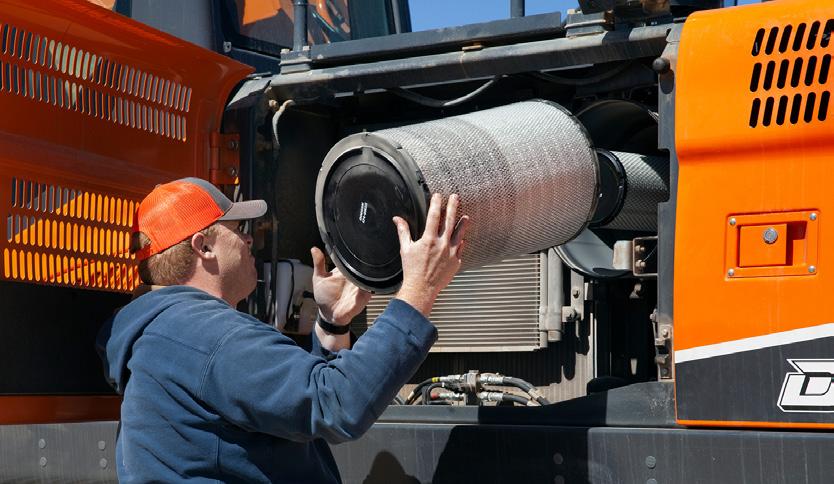
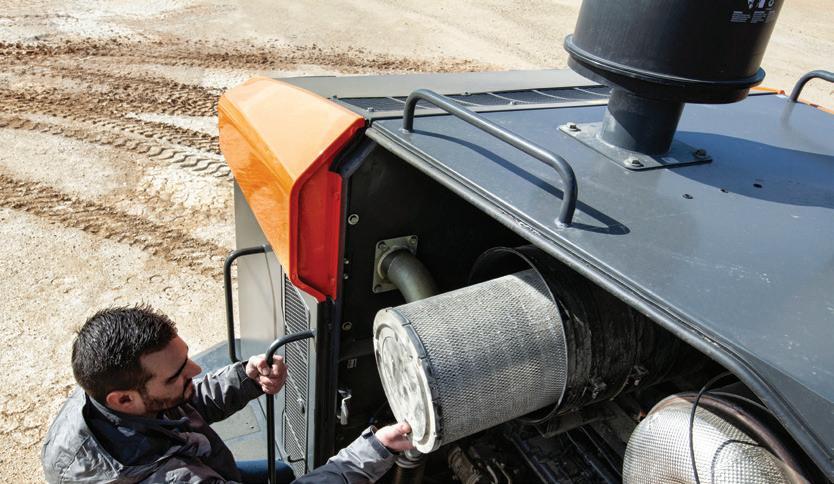

EQUIPMENT MANAGEMENT
Ensure that all filters are clean and dry before operation All filters should be cleaned or replaced before the summer months All fluid levels should be checked, especially in the hot summer months DEVELON North America DEVELON North America DEVELON North America BKT USA Inc. 202 Montrose West Ave. Suite 240 Copley, Ohio 44321 Toll free: (+1) 888-660-0662 - Office: (+1) 330-836-1090 Fax: (+1) 330-836-1091 A LONG WAY TOGETHER WHEREVER
matter how challenging your needs, BKT is with you offering a wide range of OTR tires specifically designed for the toughest operating conditions: from mining to construction sites. Sturdy and resistant, reliable and safe, able to combine comfort and high performance. BKT is with you, even when work gets tough.
YOU ARE, BKT IS WITH YOU No
Air filters, carburetors, spark plugs and recoils are just a few wearable parts that need to be regularly maintained and managed, especially with the change of seasons.
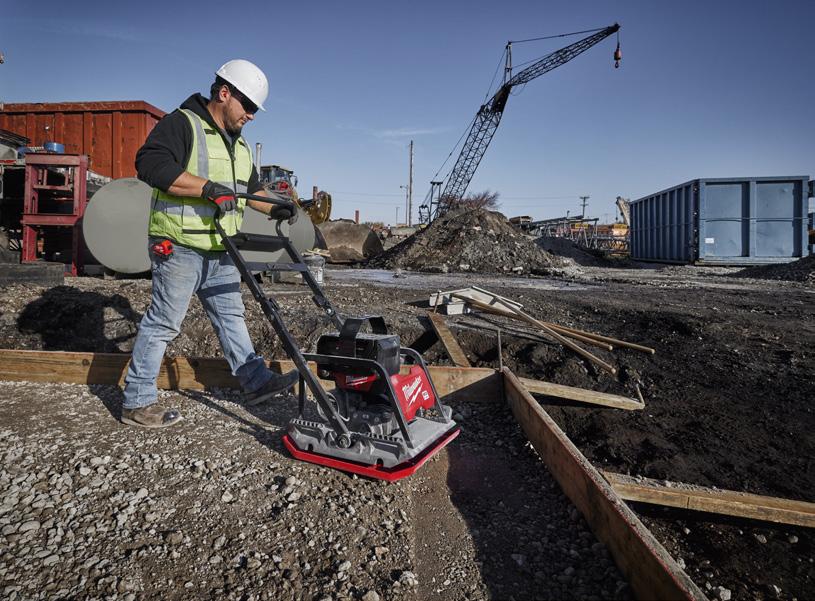
Battery-electric tools are more reliable, safer and more efficient .

With new innovations in battery technology, contractors’ expectations of equipment maintenance and batterypowered equipment performance are evolving.
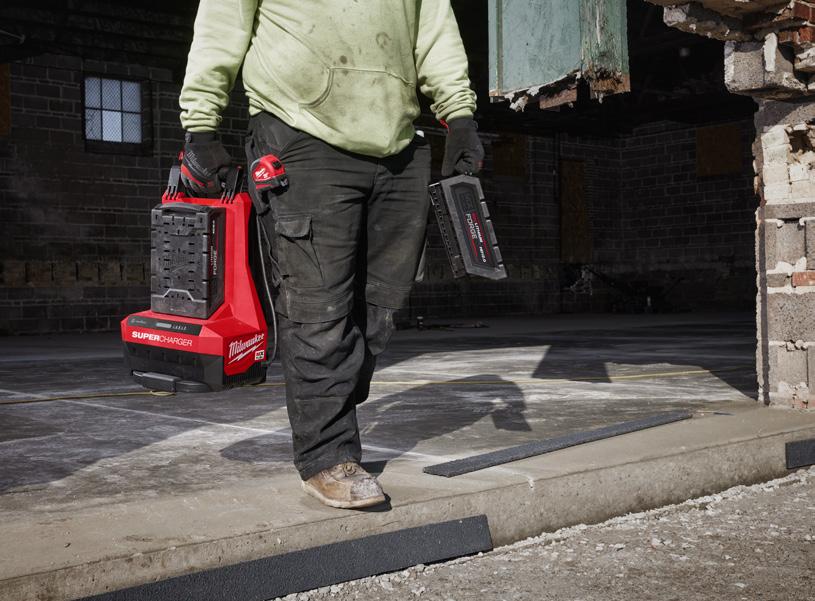
˜ Attachments: Buckets, hydraulic breakers and clamps deserve the same attention as the machine itself. Component checks should include hoses, boom, arm cylinders, wear plates, boltedon cutting edges/teeth and quick couplers to make certain they fit snugly and properly.
Coulis said that air filters, carburetors, spark plugs and recoils are just a few wearable parts that need to be regularly maintained and managed, especially with the change of seasons.
“Gas-powered products require proper storage and transportation to ensure that they work properly. The equipment needs to sit upright, keeping the gas where it is supposed
to be. Battery-powered equipment, however, eliminates the need for maintenance [required by] a gas engine,” he added.
Coulis noted Milwaukee Tool’s MX FUEL equipment, for example, has no wearable parts that need to be regularly maintained and managed, eliminating gas, oil or regular engine maintenance.
“Battery-powered equipment is not just more reliable, but a much safer and more efficient solution, giving users more confidence in their equipment,” he added.
Operator Safety & Comfort During Summer Summer can bring unique concerns for operator comfort and safety. Molnar said that among those are:
˜ Ensuring proper hydration ˜ Functioning air conditioning unit to decrease heat in the cab.
˜ Proper rest to handle the long hours worked in the summer ˜ Hot items around the cab— hydraulic hoses, exhaust, steel ˜ High heat in fluid compartments causing pressure.
˜ Ensure that proper personal protective equipment is worn Equipment with the latest technology that is properly maintained goes a long way in mitigating these concerns.
“In the summer, operators can easily become fatigued as a result of the warmer weather conditions,” Fulton said, adding that while it is imperative that equipment operated in summer temperatures has a working air conditioning system to keep the operators comfortable on the job, utilizing or upgrading to reversing fan options help to keep coolers clean and functioning properly.
Adding component cooling kits can be beneficial, said Fulton.
“In hotter months and heavier duty cycles, some components may need extra help to stay cool. That is where these cooling kits can play a major role,” he added. “Using properly rated oils and fluids as well as high quality fuels can really improve the machine’s performance, making for smoother operation.”
Contractors should know the signs of heat exhaustion, stay hydrated, not overindulge in caffeine, wear lightcolored loose-fitting cool clothing, use sunscreen, and take breaks in the shade.
According to the U.S. Centers for Disease Control and Prevention, the signs of heat exhaustion are:
˜ Heavy sweating
˜ Cold, pale, and clammy skin
˜ Fast, weak pulse
˜ Nausea or vomiting
˜ Muscle cramps
˜ Tiredness or weakness
˜ Dizziness
˜ Headache
˜ Fainting
Should these symptoms arise; move to a cool place; loosen clothing; sip water; and put cool, wet cloths on the body or take a cool bath.
Enhancing Operator Safety
Keeping operators cool can be a challenge in hot summer months, Sherman concurred.
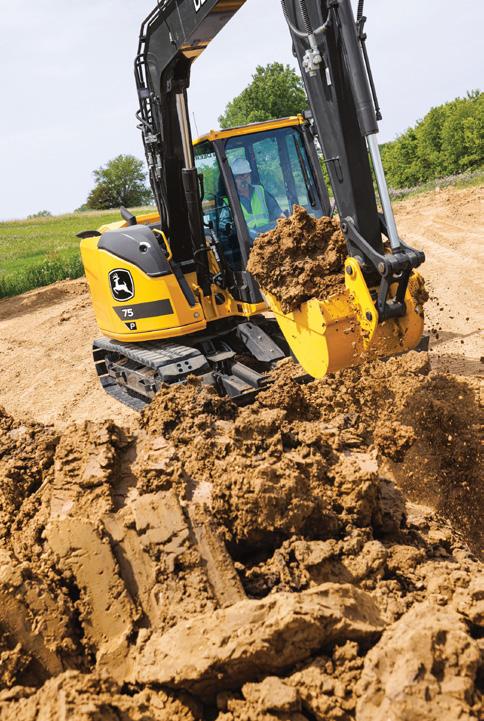
“Thankfully, most heavy construction equipment … is available with an enclosed cab and air conditioning system,” he added. “Many operators may work long hours during summer. It is important for them to have access to technology to help enhance their visibility of the jobsite.”
The components that can improve visibility includes rearview cameras, around-view monitor camera systems and sensors.
“These can be added to construction equipment to improve operator visibility and enhance jobsite safety,” Sherman said, adding that DEVELON offers a Transparent Bucket feature for wheel loaders as an additional safety feature that comes standard on -7 Series wheel loaders.
“It is helpful for operators— especially newer operators—to have a firm understanding of the equipment and its functions. It increases productivity and can help prevent accidents. Offering hands-on training accelerates operators’ familiarity with the machine’s controls, enabling them to discern features that yield optimal results, especially in summer weather.”
Using telematics with a fleet management system can help reduce operator concerns as well, Sherman noted.
“Telematics is designed to help track maintenance intervals and can help fleet managers monitor excavator idle time and help make recommendations to operators when they should shut off the machine instead of idling,” he said.
“Likewise, by selecting the proper power mode for a … task, operators can improve fuel efficiency. Reducing the amount of idling that can occur during loading and unloading operations by maximizing utilization is a good practice to increase profitability during summer,” Sherman added.
As for using equipment that may increase efficiency and decrease downtime in the summer, many contractors are beginning to invest in battery-powered equipment systems, introducing improved jobsite efficiency, Coulis said.
Milwaukee Tool’s new MX FUEL REDLITHIUM FORGE batteries deliver
With clean windows, an operator has good visibility on the jobsite.

a significant advancement in power, run-time and thermal management, doubling the capability of their MX FUEL equipment system and eliminating frustrations associated with gas maintenance, he added.
“This technology, in addition to Milwaukee’s MX FUEL Super Charger’s COOL CYCLE capabilities, increases efficiency by decreasing downtime on jobsites,” Coulis said. “Users no longer need to prime, choke and pull an engine. There are no concerns about mixing fuel or putting bad fuel into a tank.”
With new innovations in battery technology, contractors’ expectations of equipment maintenance and battery-powered equipment performance are evolving, providing benefits to the jobsite, such as efficiency, productivity and ease of use, Coulis said.
Preparing for Severe Weather Summers present severe weather events with tornadoes, hurricanes, and flooding and also is the time of year where sudden, heavy rainfall and lightning can contribute to slips, falls, and, electrocution.
Contractors should proactively prepare construction sites for such weather events. It is important to protect the jobsite by having a written prep plan and ensure that everyone working on the site is familiar with it.
Monitor weather, work with local building departments on their storm preparation plans, secure jobsite materials and hazardous chemicals, plan for water and debris removal, secure the structure as best as possible and conduct a post-storm evaluation.
Also keep a project on schedule during summer weather events:
˜ A portable LED light tower with a higher wind rating
˜ A gas-powered generator
˜ Pumps to address standing water after a rain event
˜ Ground protection to keep trucks and equipment from getting stuck Read
www.ForConstructionPros.com/Equipment 28 EQUIPMENT TODAY | April/May 2024 EQUIPMENT MANAGEMENT
eqtoday.co/SummerPrep0424
more at:
Today
Carol Brzozowski is a freelance writer for Equipment
Milwaukee Tool Milwaukee Tool Milwaukee Tool
DEVELON North America
A working air conditioning system keeps the operators comfortable on the job. John Deere
Optimizing & Designing ENGINES FOR THE FUTURE
As construction navigates the adoption of new technologies and changes in regulations, manufacturers are optimizing diesel engine architecture to support future technology innovations.
As the off-highway industry, including construction, navigates changes to emission regulations, the growing adoption of electrification, and the development of renewable fuel technology, manufacturers are working to optimize and adapt their diesel engines.
Diesel engine technology still has a long life ahead, especially for heavy-duty off-highway applications like those found in the construction industry. The path to a sustainable future does not rely on one solution. While battery electric power will play a key role in the lighter-duty equipment segment, internal combustion engine technology will continue to be one of the most viable near-term solutions for some heavy-duty applications.
To support this multifaceted approach to power, companies are developing more choices to meet the needs of the off-highway equipment industry, including renewable fuels, battery electric, hybrid electric and advancements to internal combustion engines.
Optimizing Large Engine Architecture
Diesel engines have long been the workhorses of industries, from agriculture and forestry to construction and mining. Their efficiency and durability make them a critical solution for powering heavy-duty equipment.
At the same time, industry experts know that it must invest in and evolve
this technology to meet the challenges of today and tomorrow.
One of the primary ways to do this is by exploring and vetting the most viable renewable fuel solutions.
Anticipating the potential for these fuel types, some engine manufacturers are developing engine architectures with features that will more easily allow these engines to burn non-diesel fuels while having similar engine performance.
This new engine architecture features dual overhead cams that will adapt its engines for spark ignition to burn liquid and gaseous fuels.
The Impact of Changes to Emission Regulations
Previous changes to emission regulations were challenging for manufacturers and end users regarding the overall equipment design and new packaging requirements for emission-compliant engines. As the industry prepares for the next iteration of emission standards with U.S. Tier 5 and EU Stage VI, some engine manufacturers are optimizing their engine technologies now. That means developing solutions that will create new value for end users and prepare their equipment operations to help minimize disruption for contractors in the adoption of new technologies such as electric drivetrains and renewable fuels. This new engine architecture enables variant extensions that can unlock the potential for broad integration of renewable fuels with combustion engines.
More Power, Smaller Engine
Equipment owners are often looking for more power in a smaller package. Often, these engines will be ideal for industrial and gen-set applications. They will need to meet EU Stage III A – Stage V emission regulations through common interfaces and be low-NOxready with planned external cooled exhaust gas recirculation and a single overhead cam valve train.
More Power Density
The off-highway equipment industry has navigated rapidly evolving emission regulations and increased demands for power density. To meet these changing standards, an engine must have more power per liter. More power per liter allows machines to work faster, lift more and operate more efficiently. If it is smaller (many are), the engine’s reduced footprint helps

JohnDeerePowerSystems
heavy-duty applications.
If it has an in-line aftertreatment system, the engine can offer 90 degrees of optionality. It can be mounted horizontally or vertically to be compatible with more machines in fleets while reducing connection points and optimizing thermal management.
No Aftertreatment Required
One of the biggest pain points identified by OEMs and end users is the increased complexity of aftertreatment that can come with larger engines. One engine with peak power ratings from 572 kilowatts (kW) to 677 kW (767 hp to 908 hp) and new combustion technology does not require aftertreatment, meaning users have one less fluid to manage.
Ideal for heavy-duty mobile equipment, it features a rear gear train, which produces excellent direct power, and options up to two rear aux drives for a total of 902 newton meters (665 pound-feet) max torque and provides quiet operation. The new combustion technology features a simplified air system with fixed and wastegate turbos, allowing the engine to meet emission requirements
No aftertreatment means end users have one less fluid to manage.
high-pressure common-rail fuel system delivers optimized fluid consumption, and the diamond-like coating improves biodiesel compatibility and system robustness.
Diesel Engines Continue to Play a Role
Manufacturers are helping transform the diesel engine landscape as the off-highway industry continues to navigate changes in power trends and technology. By optimizing engine technology to build in flexibility for renewable fuels, manufacturers are not only supporting contractors in future-proofing equipment operations but also contributing to a more sustainable future for the industry. As the world continues to seek cleaner energy solutions, the adaptability of diesel engines will play a crucial role in shaping the future of power generation.
Read more at:
eqtoday.co/ElectricMove
EQUIPMENT MANAGEMENT www.ForConstructionPros.com/Equipment 29 EQUIPMENT TODAY | April/May 2024
Michael Lefebvre is manager – global marketing and product strategy – for John Deere.
THE EVOLUTION of Construction Tire Innovations

Let’s begin with two obvious facts: One, heavyduty vehicles are vital to completing any construction project, and two, the tires on those vehicles are the most important piece of equipment on any jobsite. The heavy-duty vehicles required for offthe-road work are unlike any other machines found in the field and make the rugged and challenging work possible. These vehicles require tires that can keep up with demanding work and operate flawlessly under extreme pressure because if they can’t, jobsites would be at a standstill.
With the advancement of technology, tire manufacturers have designed products that not only handle the pressure but thrive in it. Using years of data acquired through tire monitoring and simulation tools,
engineers have the power to see what design tweaks need to be made to improve tire performance and operator comfort.
The insights from these technologies have paved the way for tires to become “smarter,” expanding the options for engineers and contractors to bring more efficiency, safety and productivity to sites.
Reliability
Before diving into manufacturing a new tire, answering this question is important: What is at stake if a piece of equipment gets a flat tire? Construction teams work on tight deadlines and rely heavily on equipment to maintain schedules. If a wheel loader experiences a problem and needs to shutdown for inspection, the project will likely get behind
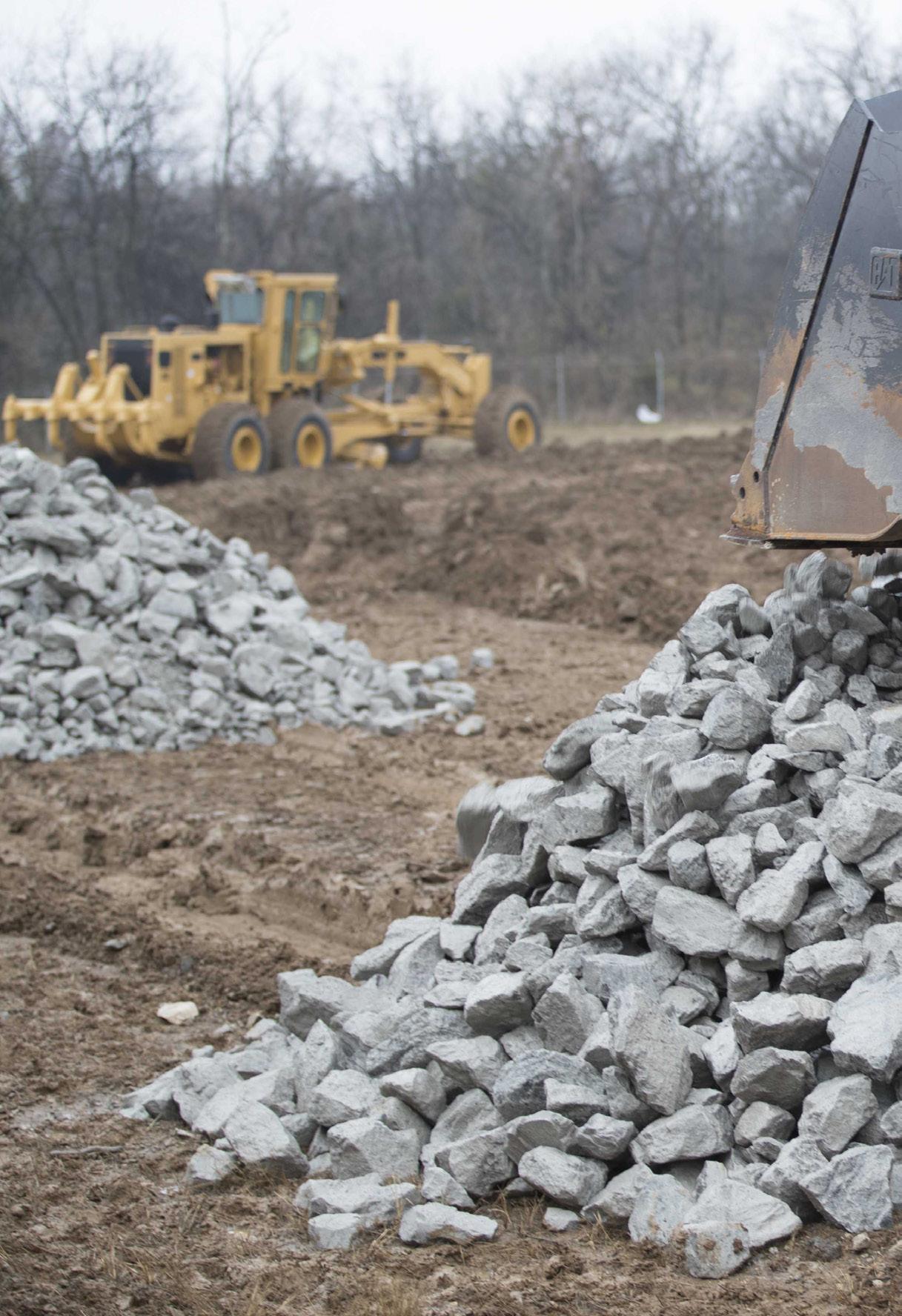
For example, construction tires are manufactured with a more durable, specially compounded rubber to create an outer tread with enhanced cut and chip resistance.
schedule, and new costs may arise. To ensure neither problem surfaces, reliable tires are key.
Reliability can be addressed through tire design, and a lot of designs are determined by the equipment type and the work it will do. However, with every new tire product brought to market, common characteristics such as durability, traction, and versatility are at the center of it all. It is through these themes that engineers are dreaming up new ideas to bring elevated levels of tire reliability to construction sites.
Durability
Tire durability is obviously needed on a construction site because of the tasks that heavy-duty equipment is required to do. Yet the emphasis on this characteristic should never be

understated. As machines have evolved to provide operators with more comfort, efficiency and productivity, tires have needed to evolve as well.
A construction tire has become so much more complex than just rubber and air. With the help of technology, engineers have developed layer after layer of materials, each with a dedicated purpose to bring strength and durability.
For example, construction tires are manufactured with a more durable, specially compounded rubber to create an outer tread with enhanced cut and chip resistance. Underneath the tread, multiple belts are layered on top of one another to add more protection against cuts and punctures near the exterior.
Depending on the tire, these belts are made from rubber-coated steel or fabric. Modern premium construction tires have also leaned into steel wire and cords to create a sturdy foundation for the outer tread and strong anchor points for the tire’s casing.
Traction
A tire with excellent traction is critical for any construction site because of the uncertain ground typically encountered by these fleets. Traction innovation has been introduced to the construction industry through
30 EQUIPMENT TODAY | April/May 2024 www.ForConstructionPros.com/Equipment EQUIPMENT MANAGEMENT
To ensure nothing gets stuck within the deep tread, engineers utilize stone rejector platforms for the gaps to prohibit materials from being lodged within the tread.
Bridgestone Americas
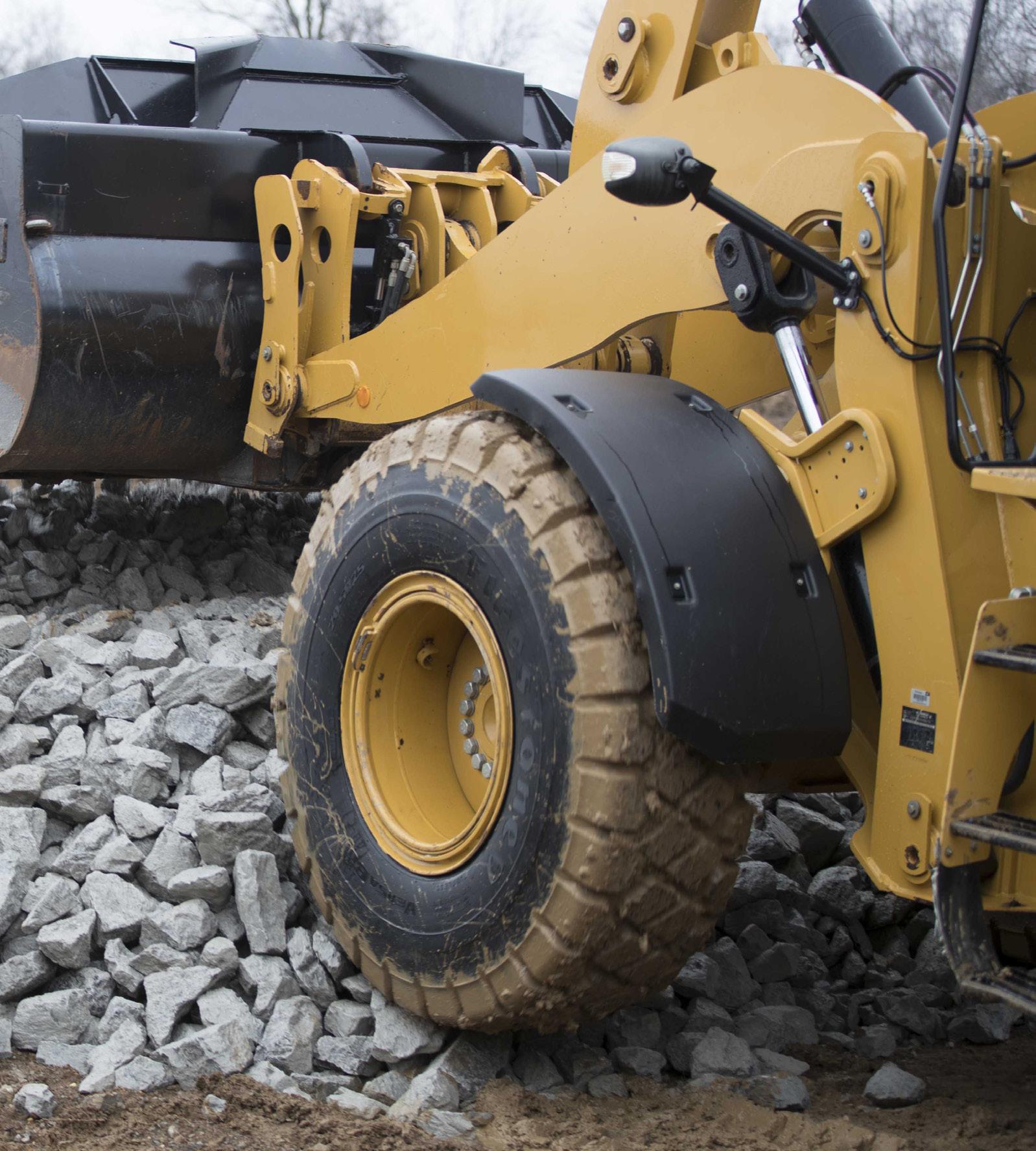

April/May 2024 | EQUIPMENT TODAY 31 www.ForConstructionPros.com/Equipment EQUIPMENT MANAGEMENT
Bridgestone Americas
3 Lessons From the “FLYWHEEL EFFECT”
While the flywheel effect involves considerable upfront exertion, the resulting momentum can sustain a business and keep it moving with less effort applied to routine maintenance over time.
Flywheels have been used as early as the Industrial Revolution in steam engines. Certainly now, they have their place enhancing renewable energy sources and driving cost-effective solar and wind generation energy storage.
Outside of the literal mechanical application of a flywheel, the term flywheel is often mentioned in business contexts. But beyond merely regurgitating business jargon, what might the term flywheel effect mean for the construction industry?
In this article, we unpack the flywheel effect and offer three lessons business owners can learn from it.
What Is the Flywheel Effect? Unpacking Jim Collins’ Flywheel Business Model
The flywheel concept is a business model first popularized by Jim Collins in his 2001 book, Good to Great

In an excerpt from this book, Collins describes the flywheel effect as a process that “resembles relentlessly pushing a giant, heavy flywheel, turn upon turn, building momentum until a point of breakthrough, and beyond.”

In other words, while this process involves considerable upfront exertion, the resulting momentum can sustain a business and keep it moving with less effort applied to routine maintenance over time.
1. HubSpot Flywheel: Disrupting the Traditional Marketing Funnel HubSpot, a popular software as a service (SaaS) company offering digital tools to help small businesses scale, describes how its own flywheel works,
akin to this momentum-generating flywheel Collins describes. The traditional marketing funnel, HubSpot explains, is one where customers were “an afterthought,” whereas the HubSpot flywheel puts customers at the center. In turn, when marketing, sales and service are built around the customer, the customer helps the company grow by becoming “delighted” business advocates, offering word-of-mouth referrals, rave reviews, etc.
2. Amazon’s Momentum: Underpinning Customer-Centricity Spins the Flywheel
It is generally believed that Amazon’s flywheel, supposedly drawn on a napkin by Jeff Bezos in the early days of the company and the nexus of its ability to overcome the dot com bubble popping, was inspired by Collins.
OMR describes Amazon’s flywheel: “Setting growth at Amazon in motion … is ensuring a positive customer experience, [which will] lead to an increase in customers, which, in turn, boosts the relevance for merchants. And when more merchants sell their wares on Amazon, the product offer increases, which has a positive impact on customer experience.”
3. MAYA: How Apple Changed How We Interact with Smartphones
Similar to Amazon’s customercentricity, Apple’s “ecosystem” or “walled garden” supports the idea that customers can immerse themselves with complimentary devices and services that deliver a seamless experience. In doing so, Apple inspires
a deeper customer investment into the ecosystem, translating to brand loyalty.
At the same rate, arguably, what makes Apple’s flywheel compelling is its maniacal attention-to-detail, quality and interactive design that makes these products not only compatible but also delightful to use. A concept known as MAYA (an acronym for: most advanced yet accceptable) is also likely at work inspiring continuous engagement with Apple’s ever-growing product ecosystem. This concept was brought to life by the father of industrial design, Raymond Loewy, who is quoted in the International Design Foundation as saying:
“The adult public’s taste is not necessarily ready to accept the logical solutions to their requirements if the solution implies too vast a departure from what they have been conditioned into accepting as the norm.”
Consider, for example, the smartphones we all have in our pockets today, where the norm is a giant screen, and virtually no tactile buttons, which vastly changes how much can be accomplished through the software interface. Steve Jobs famously described this “revolutionary UI” in the launch of the first iPhone, which allowed, for the first time in the smartphone industry, for the concepts of continuous improvement (e.g., kaizen) to be applied to hardware products. “Every application wants a slightly different user interface, a slightly optimized set of buttons just for it,” Jobs noted in 2007, describing the limitations of tactile buttons of the time. “The buttons and the controls
can’t change for the application, and they can’t change down the road if you think of another great idea you want to add to this product.”
Despite how revolutionary the iPhone was, it’s critical to explain the set of circumstances that facilitated mass adoption. Remember the critics: Then-Microsoft CEO Steve Balmer famously laughed at the iPhone, calling it “the most expensive phone in the world, and it doesn’t appeal to business customers because it doesn’t have a keyboard.”
In fact, as the International Design Foundation reminds us, the product designers at Apple were subliminally preparing us for a UI devoid of tactile buttons for years prior: “The iPod’s designers gradually pushed the product design further and further as the iPod gradually lost the extra buttons and got a lot more streamlined interface. It is very likely that this gradual development from the first iPod in 2001 was what made the iPhone acceptable to users when it was launched in 2007. By applying the MAYA principle, the designers at Apple provided the users with the most advanced design within the boundaries of their acceptance.”
Similarly, technological advancements in our industry, like building information modeling (BIM), may at the onset of adoption seem challenging. For example, according to JBKnowledge, 27.8% of contractors do not bid on projects involving BIM. An industry survey coordinated by the Chartered Institute of Building, too, found that 59% of companies state that
www.ForConstructionPros.com/Equipment 32 EQUIPMENT TODAY | April/May 2024 BUSINESS







Customer Acquisition




















At the center of the flywheel—like HubSpot, Apple, and Amazon—is the customer. As new customers are fed into the flywheel, improving the customer experience—for example, improving customer relationship management through open communication and improving collaboration through BIM modeling—can keep it moving.













their workforce doesn’t have the skills needed to work with BIM.
That said, data from Dodge Data & Analytics (via Autodesk) and others continues to show BIM’s promise. For example, 61% report BIM processes reduced project error; 55% report BIM processes reduced the time required for communications, and 82% of BIM users report a positive return-on-investment.
As the industry continues to evolve, and so do evolving roles like BIM specialists within construction companies, it’s likely that the extent to which BIM falls within companies’ boundaries of technology acceptance.
How to Leverage the Flywheel
Now that we’ve discussed what the flywheel business model is and how it’s at work in three of the largest names in big tech, how might you leverage the same effect to drive






Operational Excellence





profitability and business resilience at your company?
Three components are involved in a flywheel:
1. Customer acquisition—how you drum up business
2. Customer experience and engagement—how you retain business
3. Operational excellence—how you empower the teams to do their best work and delight your customers to gain repeat business.
A worthy flywheel: At the center of the flywheel—like HubSpot, Apple, and Amazon—is the customer. As new customers are fed into the flywheel, improving the customer experience— for example, improving customer relationship management through open communication and improving collaboration through BIM modeling— can keep it moving.
But beyond customer experience,
adopting the continuous improvement mantra toward promoting operational excellence ultimately completes the cycle, improving the degree to which the team can continually exceed your customers’ expectations. This may be achieved through improving cross-team software integration, adopting lean management principles to eliminate waste and refocus efforts to prioritize customer value, or even supplying workers with the right tools to get the job done (e.g., smart tools can help deliver application-specific repeatability, standard Bluetooth® tracking compatibility for better inventory management and security, reporting for quality assurance purposes; etc.
Final Word
The first revolution of a flywheel dates back as early as the Industrial Revolution, but the breakthroughs that
Customer Experience & Engagement


facilitated mass transportation are the same sources of momentum you need to build into your company to keep it afloat and continually revolving around your customers.
Making the upfront investment to build a flywheel-inspired cycle of virtuous growth for your company can seem daunting. However, in contrast to traditional models that often sideline infrastructure spending in favor of short-term gains at the expense of future growth velocity, defining your own business flywheel is one of the most efficient strategies available.
Lucas Marshall is a content marketing manager at Milwaukee Tool.
Robert LaCosse is a UX strategist with Milwaukee Tool.
Read more at: eqtoday.co/flywheel
April/May 2024 | EQUIPMENT TODAY 33 www.ForConstructionPros.com/Equipment BUSINESS
Tool
Milwaukee
While studies suggest that the overall construction industry is increasingly digitized, small site contractors—a segment that makes up a majority of the market—remains largely unchanged. Many still rely on conventional means and methods to complete dayto-day jobs.
The reasons for the lack of investment in modern advances are multifold. Fear of change, the perceived high cost of entry and the inability to easily quantify productivity gains and cost savings are among the top reasons most commonly cited. In some cases, contractors may be intimidated or overwhelmed by the learning curve of new software and systems and unsure about managing the data needed to use technologies effectively.
But those fears pale in comparison to the need for better workflows and improved productivity, particularly in light of the continuing workforce challenges. Improved processes can only be accomplished with technology—and some might be surprised to find that options are available and affordable, especially for small site contractors.
What’s at Stake
For many small site contractors, investing in a GNSS base station and rover is one of the quickest and most cost effective ways to dive into technology-enabled workflows. They are highly versatile, typically mounted on poles, machines or a semi-permanent location on a jobsite. These systems empower field crews, eliminating the need for in-ground stakes, minimizing the need for surveyors onsite and are instrumental in measuring stockpiles and topsoil piles.
The next step might be grade control, a capability that has been available in the industry for more than two decades. The common perception is that these solutions are very expensive and single-machine focused. However, grade control solutions are readily available at a relatively low cost—and some of these systems don’t require mounting hardware—making them easy to move from machine to machine, and are iOS and Android compatible.
Small Site Contractors CASH IN on Construction Tech
With the growing number of options for small site contractors to invest in technology, the decision about where to begin can be another significant hurdle.

Multiple options and price points make it easy for owner-operators, small site contractors and construction companies of all sizes to take advantage of the benefits of technology.
34 EQUIPMENT TODAY | April/May 2024 www.ForConstructionPros.com/Equipment TECHNOLOGY
Trimble
Gardocki is 50% more efficient using machine guidance because it allows him to combine layout and 3D machine guidance in
efficient workflow.
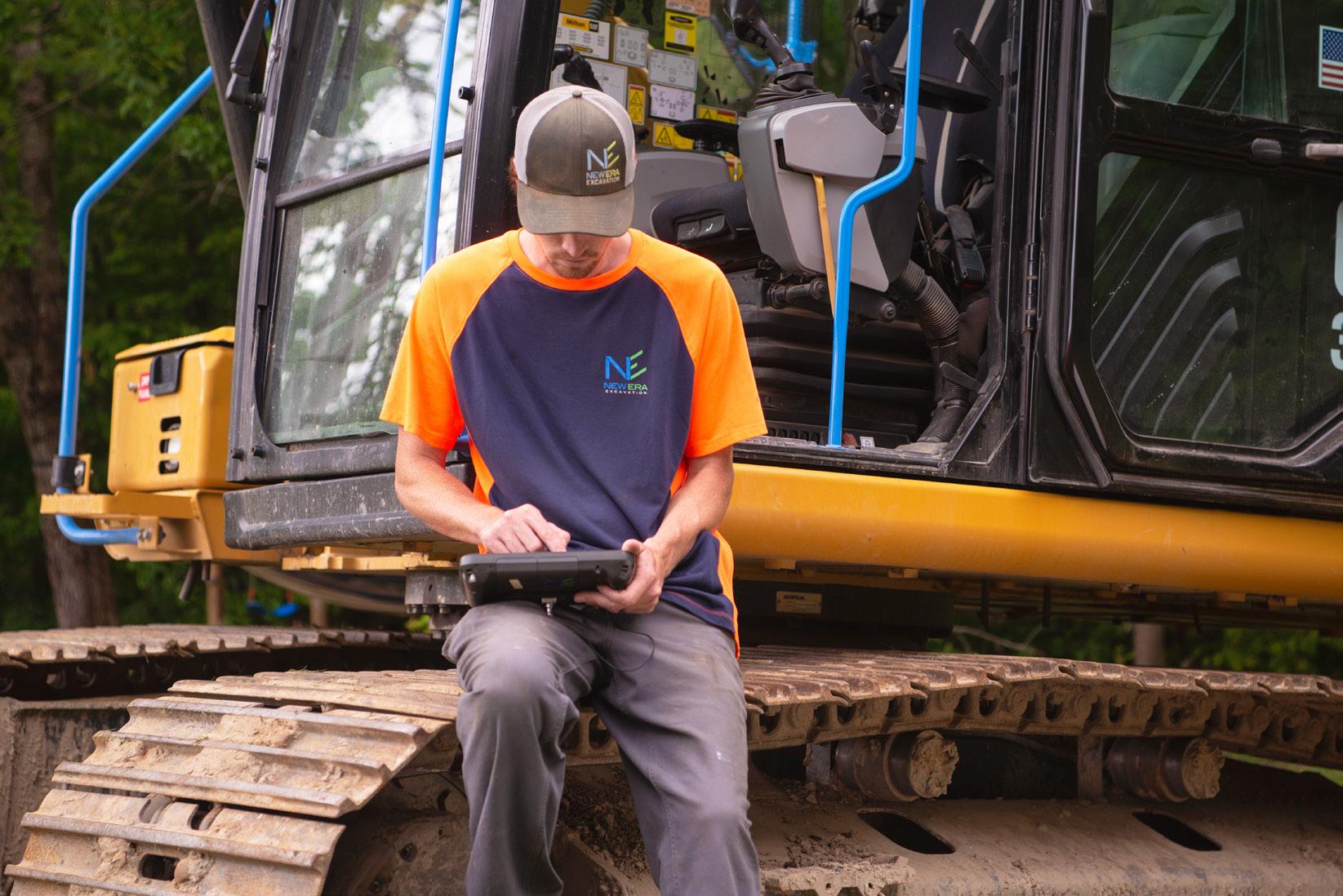
LK & Sons Excavating LLC in Laura, Ohio, is a small contractor with a big business in constructing parking lots, driveways and building pads. While fascinated by technology, particularly machine control, the owner didn’t believe his company had enough work to make the investment in big machine control systems, which usually require base stations and other connected technologies. Instead, he invested in a simplified 2D grade control platform. Now, what used to require two people and two pieces of equipment—a roller and skid steer—is completed with one and the operator no longer has to jump out of the cab to check grade. Jobs are safer and more efficient—at least 50% more efficient when it comes to labor. Having digital profiles that are saved across machine setups is an added bonus.
are emerging for on- and off-machine construction solutions. These subscription models let contractors upgrade to the latest hardware and software from on-machine grade control systems to offmachine base stations, data collectors and rovers. Some include a full factory warranty and repair or replacement of accidentally damaged hardware, as well as field-to-office software to simplify data management.
The advantages of these models for small site contractors and owner operators are many. Arguably,
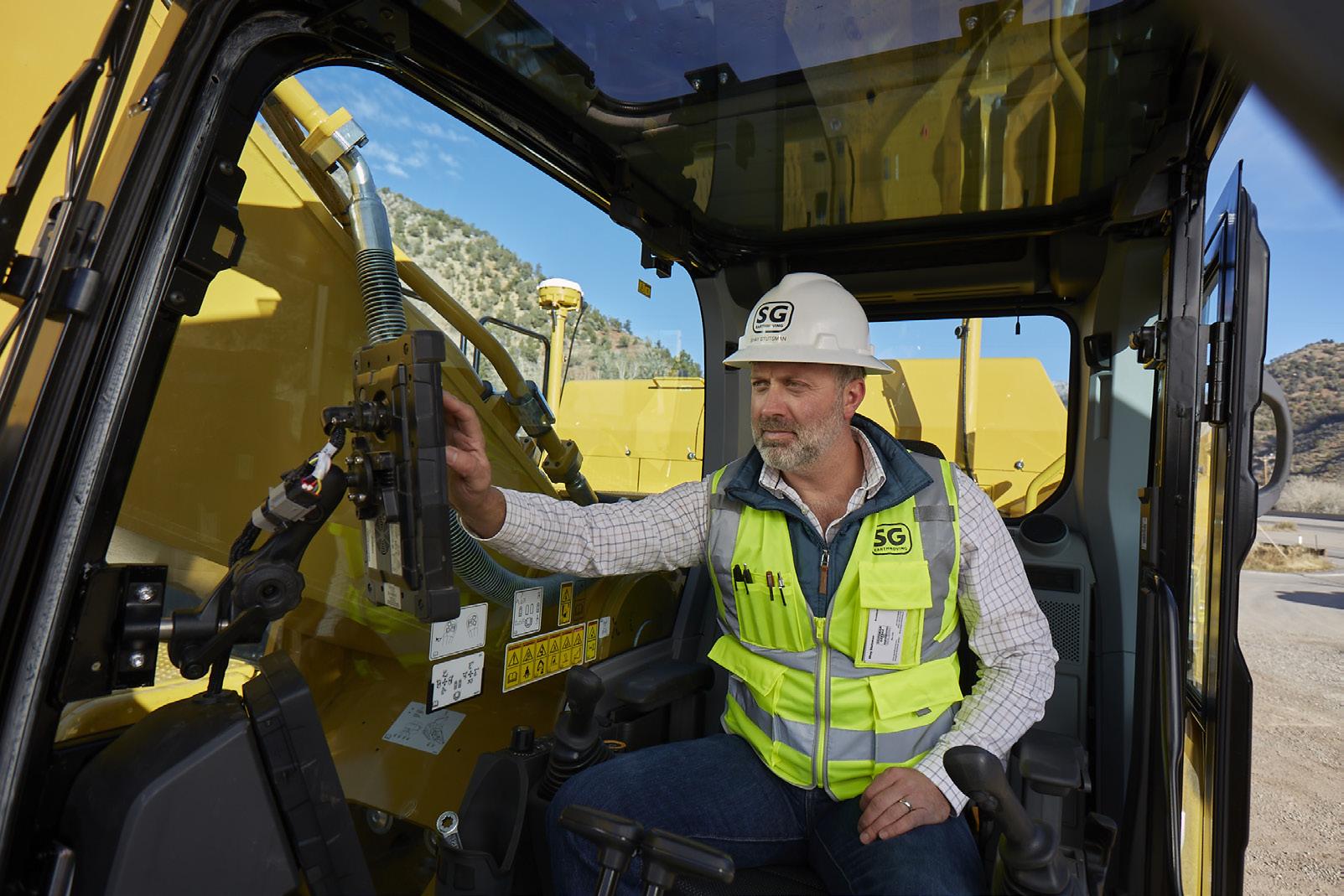
Once that works, the next step might be a system that offers both layout and machine guidance. New England-based New Era Excavation, a small site excavation residential and light commercial company serving New Hampshire and Northern Massachusetts, began with base stations and rovers and has gradually expanded its technology portfolio over the years.
Early on, the operators used 2D grading systems and then began testing full 3D systems. When a 3D machine guidance solution, purpose-built for small site and utility contractors, was introduced, co-owner Tom Gardocki was first in line to evaluate. With this one system, operators can perform a range of common activities, including site surveys, 3D machine guidance, in-field
design and reporting. The system is modular, so the GNSS smart antenna can go from a pole for surveying and to an excavator stick while the data collector moves from rover pole to a mount in the machine cab. Gardocki stated that this single system saves labor; improves accuracy, especially when pulling tape on uneven terrain; and is safer because nobody is standing near heavy equipment. He can get more jobs done by the same number of people in the course of a year since investing in this single system.
Reducing the Upfront Stress
One of the common reasons that small contractors cite for not investing in technology is the large upfront investment. Today, there are even ways to minimize that challenge through subscription models.
We are all familiar with software-asa-service models for office solutions. Today, somewhat similar models
be the best possible way to get a foot in the door of advanced construction technology.
Realizing ROI
With the growing number of options for small site contractors to invest in technology, the decision about where to begin can be another significant hurdle. The effort to improve operational workflows while staying competitive can feel like a sinking ship with multiple leaks. Many don’t know which hole to plug first or how to address issues effectively. Because of the bespoke nature of construction projects, no single solution fits every business.
One of the most effective ways to realize the value of a technology investment very quickly is to focus on process improvement—not point solutions. Consider solutions that are part of a larger ecosystem to ensure continued support and growth as your needs change.
Identify your most inefficient workflow and find a technology solution that addresses that problem.
Also, reach out to local dealers to demo solutions firsthand and receive hands-on training. Before investing in a solution, ask about flexibility in consuming existing data formats like PDFs to integrate solutions into your current workflow.
The custom nature of the construction business also highlights the importance of relationships with solution providers and local dealers to help evaluate specific inefficiencies and recommend targeted first steps to see a return on investment (ROI) quickly. Demonstrating real-world impacts is important to overcoming uncertainty and empowering contractors to make informed investment decisions.
the biggest benefit of a subscription model is the limited upfront capital investment. Others include cost predictability, flexibility to scale and assurance that a technology investment stays current and beneficial.
As an example, Stutsman-Gerbaz, an earthwork and demolition contractor based in the Roaring Fork Valley of Colorado, realized the value of 3D grade control to improve productivity, at first only on a limited basis.
Through a technology subscription, the company now has most of its dozers and excavators equipped with the latest version of the technology.
The company can better afford the 3D machine control technology and through the subscription, the sensors; harnesses and cables; and software upgrades on desktops, rovers and tablets are included and handled through the local dealer.
For many small contractors, onand off-machine subscriptions could
As well, construction is and always will be a relationship business. Talk to other contractors who are using technology and learn from their experiences.
By leveraging the ecosystem approach, subscription models and hands-on demonstrations from local dealers, small site contractors can more easily evaluate options and justify the ROI of adopting new technologies to overcome their most pressing inefficiencies. Embracing proven solutions aligned with existing methods can empower smaller businesses to stay on the cutting edge of an increasingly technology-driven industry—driving productivity, improving competitiveness and introducing an expanded ecosystem of opportunities.
Read more at:
eqtoday.co/smallsite
April/May 2024 | EQUIPMENT TODAY 35 www.ForConstructionPros.com/Equipment
TECHNOLOGY
Jack Young is a machine control product manager, civil construction field systems at Trimble.
Stutsman-Gerbaz has increased its use of technology—and its productivity—by using a subscription model to acquire technology and stay on top of upgrades.
Trimble
one
Trimble
SENSORS, CONNECTIVITY & AI: The Building Blocks to a Safer, More Productive Worksite
As we look to the future, we can expect to see AI-powered robots and automated machinery performing repetitive tasks on the jobsite, such as digging trenches and moving earth.
Whether it’s vehicles used on construction sites or in other environments, all off-highway vehicles have one thing in common—they operate in extremely challenging conditions. Because of this, their systems and components must be designed to withstand long duty cycles in the presence of humidity, moisture, dust, dirt and constant vibration. Without robust engineering, both productivity and safety would be at risk.
As if those environmental challenges weren’t difficult enough, operational limitations exacerbated the problem. Machines being guided by sight, using mirrors and cameras, had to deal with blind spots that could put personnel in harm’s way or cause operators to run over obstacles. Without insight into the health of the machinery, workers sometimes continued to operate systems that needed maintenance, adding to safety risks while increasing the likelihood of a major mechanical failure that would put the vehicle out of commission.
Fast forward to today, and thankfully, advanced technology has made many of these challenges a
thing of the past. Original equipment manufacturers (OEMs) now use sensors, connectivity, telematics software, and artificial intelligence (AI) to create new functionality, solving common operating challenges and increasing safety and productivity for owners and operators of offhighway vehicles.
Sensors at Work
Throughout a construction site, sensors are virtually everywhere, and their job is critically important. Construction vehicles use sensors including humidity, temperature, pressure, rain, fluid and oil quality detection to monitor external operating conditions and internal system performance.
These sensors help ensure reliable performance of mission-critical operations where downtime is not an option. Sensor-enabled construction vehicles include a mix of electrified equipment and legacy internalcombustion-engine-operated systems.
Electrified equipment is used heavily for closed-loop applications that have predictable operating conditions and easy access to charging.
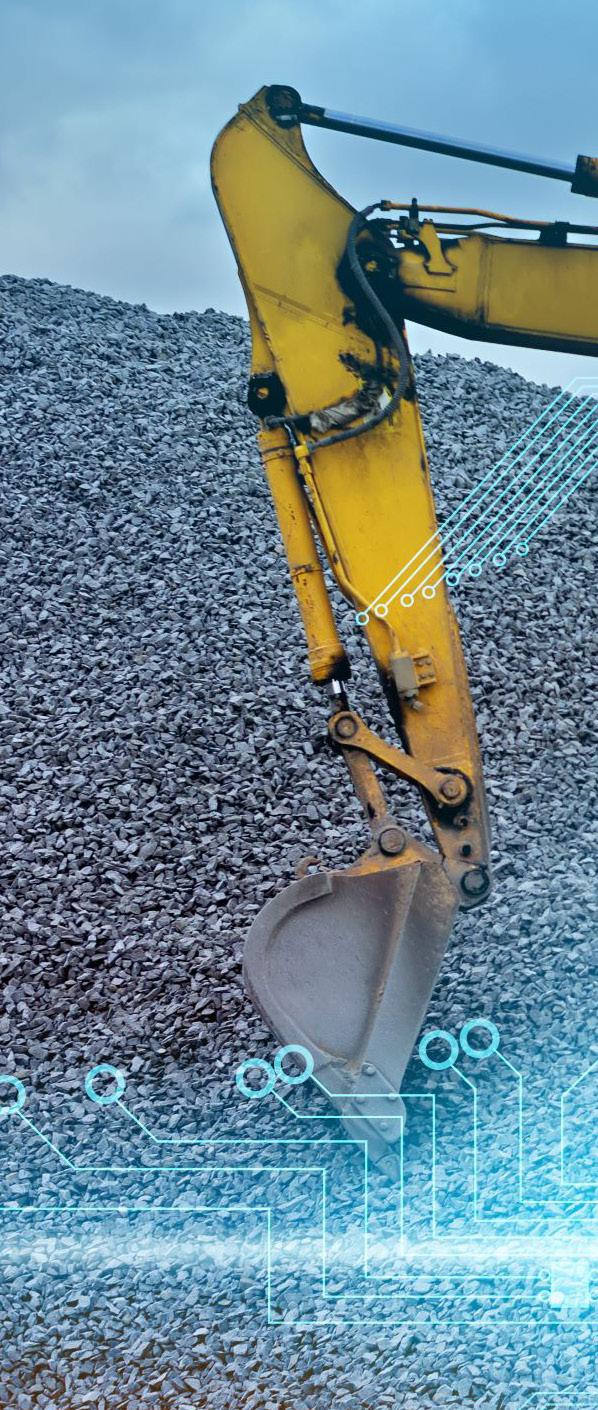
In fact, as electrification becomes more mainstream, sensors can make this a more viable option for a wider range of off-highway applications. Rotor reposition sensors attached to motors track their rotation and provide signals so that electronic control units can optimize output and battery pull, extending battery range.
When combined with high-speed data connectivity, sensors power advanced driving-assisted systems such as e-braking and e-steering. Operators driving to jobsites can use these systems to minimize turns, lights, and delays, speeding arrival while minimizing fuel costs. They can also leverage pedal travel sensors, which convert foot pressure into signals to brake to stop slowly or suddenly. High-pressure brake sensors detect how fast wheels turn, providing the right amount of pressure for calipers to break smoothly, lightly, or heavily while avoiding locking up.
Finally, sensors can detect problems before they occur, enabling operators to conduct proactive maintenance in the field, offsetting costly repairs and returning vehicles swiftly to service. As just one example, a multinational company uses oil
property monitoring sensors to protect costly off-highway vehicle engines from harm and reduce repair timeframes from six days to two.
Connectivity Systems Coupled With AI
To increase productivity and maximize efficiency of a jobsite, connectivity systems must be robust enough to support real-time data capture and transmission, ingesting data on how the surrounding environment is changing, including nearby vehicles.
In today’s environment, many construction vehicles already use some degree of automation to drive throughput and increase worker safety on the job. Both manually operated and autonomous vehicles use sensorguided systems to make tight turns in constrained spaces, turn in unison to avoid collision and avoid rolling over.
What’s more, GPS systems with LIDAR and RADAR sensors integrate with telematics software to provide the real-time location of all machinery, while proximity and other sensors detect blind spots and the proximity of nearby equipment Couple these systems with AI and
36 EQUIPMENT TODAY | April/May 2024 www.ForConstructionPros.com/Equipment TECHNOLOGY

we’re on our way to an even safer, more productive jobsite.
AI is becoming increasingly integrated into the construction industry but not without the power of sensors behind it.
Let’s examine the idea of wanting to create a 360-degree view of a jobsite. To achieve this, sensor data captured around the site is aggregated and combined with AI to create a realtime picture of the environment’s current and changing conditions, such as the movement of personnel, machinery and materials.
Sensor-driven systems with AI increase safety by detecting hazardous conditions on sites that could harm people, such as opportunities for slips and falls and hazardous materials not being used safely, such as chemicals. When systems detect these issues, operators receive alerts to address hazards immediately. Supervisors can also be alerted if there is an accident on the jobsite that requires attention.
From a preventive maintenance standpoint, AI algorithms analyze sensor data to predict when maintenance is needed, offsetting costly downtime and potentially preventing onsite accidents before they happen.
Construction vehicles use sensors—including humidity, temperature, pressure, rain, fluid and oil quality detection— to monitor external operating conditions and internal system performance.
And as we look to the future, we can expect to see AI-powered robots and automated machinery performing repetitive tasks on the jobsite, such as digging trenches, moving earth or building brick walls with great precision.
This increases productivity and improves safety by limiting hazardous tasks and creates new and expanded job opportunities for workers. Autonomous vehicles can also take over jobs that are too dangerous for personnel, such as tearing down large structures.
Ultimately, the goals of owners in the construction industry have largely remained the same. They not only hope to optimize the routing of trucks that bring materials and personnel to jobsites, but also seek to drive the reliability and productivity of heavy machinery to keep projects on schedule while at the same time ensuring operator and equipment safety.
However, as the pace of innovation accelerates, the need for close collaboration among ecosystem partners will increase to meet goals.
By working closely with OEMs, component manufacturers will be able to meet the everchanging needs of the construction industry by embracing the advancements in AI and working to develop even more advanced sensors that improve productivity, reliability and safety, bringing new solutions from concept to market. Read
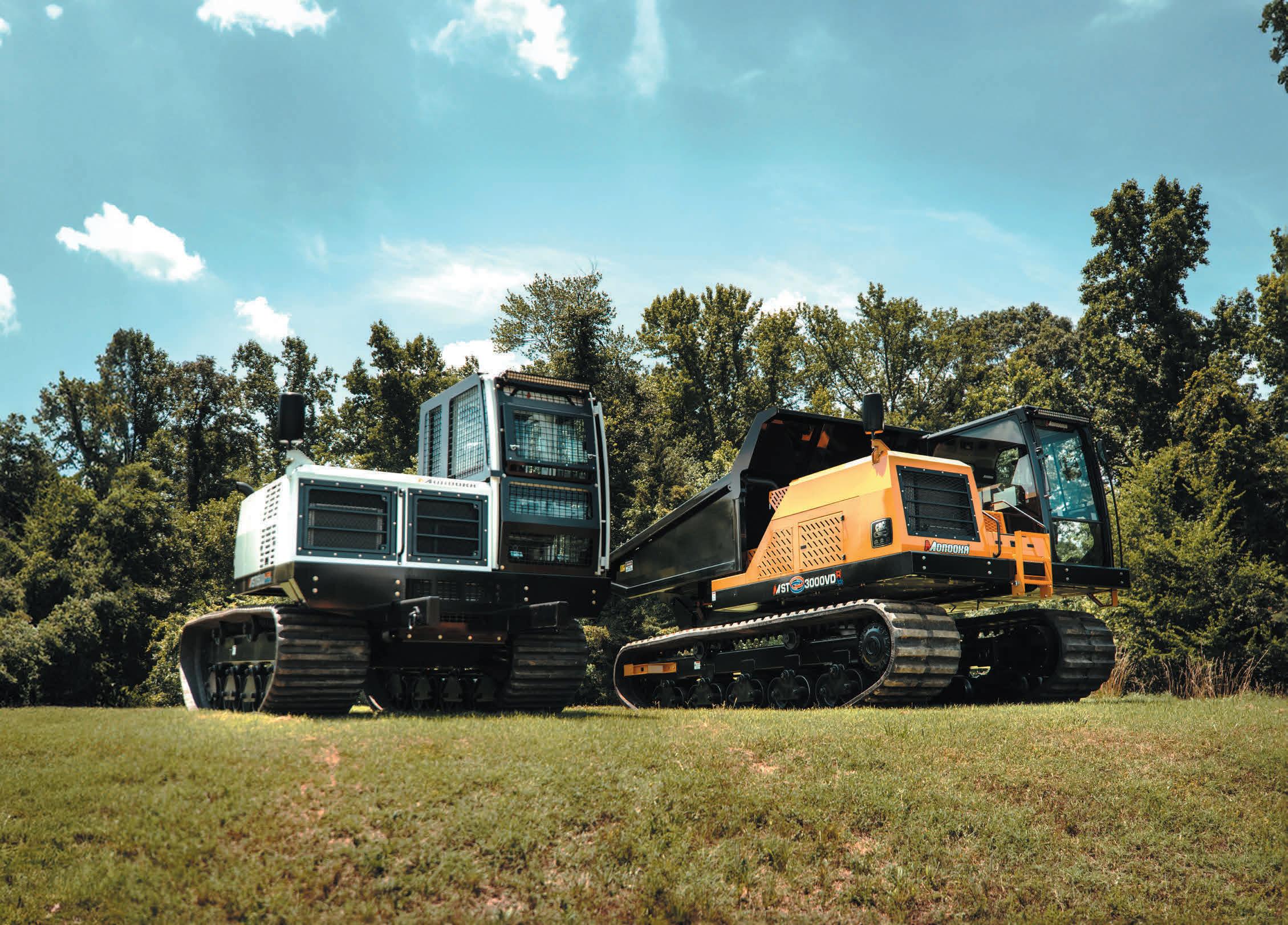
April/May 2024 | EQUIPMENT TODAY 37 TECHNOLOGY
TE Connectivity
WE KEEP AMERICA ON TRACK Find a dealer near you at MOROOKACARRIERS.COM
more at: eqtoday.co/sensor
Gregory Fehribach is vice president of technology strategy at TE Connectivity.
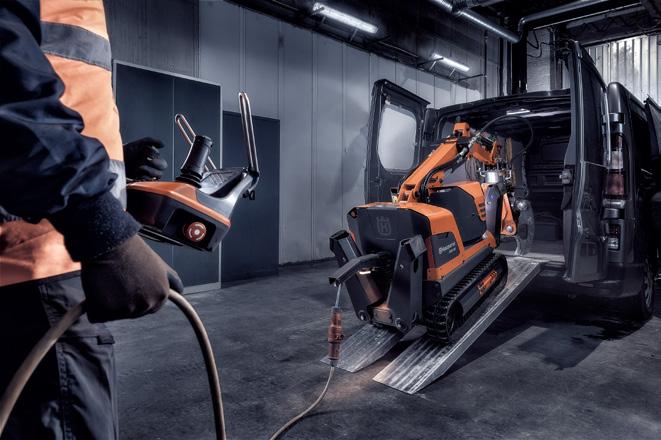
Husqvarna DXR 95 Demolition Robot
Husqvarna introduced the DXR95 demolition robot for construction projects. It adds a fifth model to the company’s demolition robots for confined spaces. The DXR95 features a powertrain delivering 13 hp and 3,626 psi to the endof-arm tool. Weighing about a half a ton, it’s small enough to transport in a van and steer through narrow passageways and sturdy enough to manage steep inclines at an angle of 30 degrees.
Operating the DXR95 is straightforward with remote controls. Features include joysticks and knobs that make it possible to select and change settings, written messages for machine feedback and the ability for operators to choose their preferred language on the LCD screen.
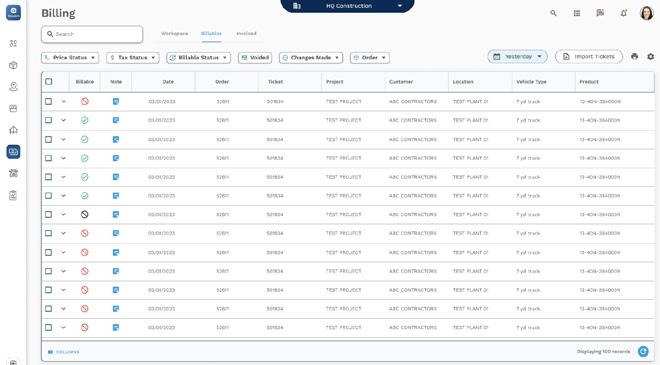

Planera Autodesk Construction Cloud Integration
Planera announced an integration with Autodesk Construction Cloud, a portfolio of software and services that combines technology, a builder network and predictive insights for construction teams.
The new integration combines Planera’s CPM-based scheduling software with Autodesk Construction Cloud, creating a solution for users.
Project teams can now build, analyze and optimize construction schedules from Planera directly within Autodesk Build Insights or BIM 360 Project Home dashboards. Planera’s scheduling and planning tools support Autodesk Construction Cloud by providing users access to resources that establish a scope of work for estimates, develop a baseline, maintain progress schedules and execute work with collaborative pull-planning.
Command Alkon Billing & Invoicing Functionality
Command Alkon unveiled the revamped billing and invoicing functionality in its cloudnative Dispatch product. As a cloud native SaaS product, Dispatch enables customers to access features for their operations.
The billing and invoicing experience in Dispatch introduces a range of customercentric features tailored to meet specific needs and preferences. With a configurable interface, users can utilize a mobile platform for managing their financial transactions. Included in this modernization, customers can adjust product and pricing details at the line-item level, reducing errors in outgoing invoices. They can also preview invoices before sending them out.
Liebherr MyAssistant for Earthmoving App
Liebherr developed MyAssistant for Earthmoving, a new app that provides support for construction machinery operators. The mobile app is available for wheeled excavators, material handling machines and wheel loaders of Generation 6.0 and higher, as well as for crawler excavators, graders and crawler loaders, pipelayers and articulated trucks of Generation 8.0 and higher.

The new mobile app can be downloaded from the Apple App Store and the Google Play Store. Once logged in, MyLiebherr makes all Liebherr earthmoving and material handling machines in the company’s fleet available to the user via a drop-down menu.
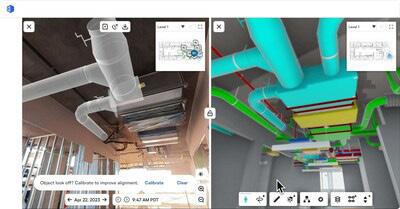
OpenSpace BIM+
OpenSpace BIM+ is a new product aimed at supporting coordination between virtual design and construction (VDC) and field teams. This product uses OpenSpace’s AI and computer vision technology to align 360-degree photos with building information modeling (BIM) and includes a host of functionality that allows teams to simplify field-to-office BIM coordination. OpenSpace BIM+ provides a version of BIM for field use. The product features 3D tools that enable construction teams to manage onsite coordination issues without reliance on a VDC manager for common questions.
Trimble SiteVision Software 5.0
Trimble SiteVision Software 5.0 is the latest version of the company’s outdoor augmented reality system, which is now equipped with a new 3D scan tool. The 3D scan app allows customers to use LiDAR sensors available on some Apple Pro devices to capture georeferenced point clouds with a simple workflow. Combining scanning and precision in a mobile solution, SiteVision 5.0 enables users to create as-builts of the jobsite on the go, measure and plan resource allocation, reduce scan times, supplement drone data, and model preconstruction conditions. These scanning tools support SiteVision’s functionality for creating field-to-office workflows.


Simformotion Caterpillar Simulators
Simformotion offers several Caterpillar simulator systems for training construction professionals in virtual environments. The company extended its agreement with Caterpillar to deliver heavy equipment training simulators around the world.
The collaboration provides Simformotion with continued access to Cat technical data, product engineers and operator experts, which enables Simformotion to create realistic operator training. The latest simulator systems include the backhoe loader and hydraulic mining shovel which feature authentic Cat controls and the ability to convert models from one to another on the same base unit. Companion curriculum, SimScholars, are available for each model.

Autodesk Construction Cloud Tools & Features
Autodesk released several new features in Autodesk Construction Cloud (ACC) aimed at helping project leaders and teams make decisions, track progress and view data. The Specifications tool adds new machine learning (ML) capabilities to ACC, building upon current AI enabled workflows across Autodesk’s Design and Make Platform. The Specifications tool automates the manual process of preparing specifications by using ML to extract and section project requirements into relevant specification divisions within Autodesk Build and Autodesk Docs. Users can auto-generate specification divisions and sections for navigation, as well as upload and publish specification documents from the files tool and perform detailed search and filter workflows.

Cojali Jaltest Central Services
With Jaltest Diagnostics version 24.1, Cojali unveiled Jaltest Central Services, the latest solution for diagnostic tool users performing ECU revisions in-house. This service enables users to undertake actions, including the reprogramming of specific ECUs.
Technicians initiate the process by verifying the required initial conditions through Jaltest Diagnostics. Subsequently, they can connect with the support team and schedule their preferred time slot for the desired action.
Currently, users have access to many services, including Cummins’ ECM calibration updates, calibration updates for the international central computer and Paccar’s parameter modification for MX PCI, GHG14 and GHG17.
www.ForConstructionPros.com/Equipment TECHNOLOGY Products 38 EQUIPMENT TODAY | April/May 2024 Read More at eqtoday.co/ETtech


To be considered, eligible contractors are required to have a minimum of 15 full-time or part-time employees in the U.S. and a primary business of: General Building Construction, Earthmoving, Paving, Concrete or Specialty and trades (Underground, Utility, Electrical, HVAC, Demolition, etc.) Apply today at BestContractorsToWorkFor.com APPLICATION DEADLINE JULY 19, 2024 SCAN HERE Take the opportunity to be recognized as an outstanding employer, highlighting the paramount importance of your people. The online application process is FREE, and earning the distinction of being a premier contractor offers the advantage of attracting the diligent and skilled workforce that your company truly merits. Being Named A “BEST CONTRACTOR” Could Give You A Leg Up In Hiring Skilled Labor!

Eliminate Rework With Equipment & Technology
This column explains why roadbuilders are most likely to be early adopters of the latest paving train models or technologies.

a job a second time means, well, less equipment running and lower emissions. Construction rework is any unplanned work required as a direct result of missteps.

We’re nearing the halfway point of an election year, and roadbuilders, like many others in the construction world, are weathering changes. Despite increased material and labor costs, project managers employ solutions to increase profit margins during this paving season.
The Association of Equipment Manufacturers reports an increase in both asphalt and concrete prices and unstable diesel and oil prices for the
rest of the calendar year. Meanwhile, many project managers are still looking for the right person for the job during the continued labor shortage.
Project managers are left to budget higher salaries for roller operators, screed operators and laborers. Besides the business cost increases, several state or federal projects—as part of the Infrastructure and Investment Acts (IIJA)—require efforts to improve the sustainability of their project bids. All these factors have forced equipment
professionals, project managers and original equipment manufacturers (OEMs) to identify what will pave the way to long-lasting roads without breaking the bank. The answer for most? Eliminating Rework.
Several times in recent years, when John Deere’s leadership team has talked about the company’s effort to help reduce emissions, they’ve highlighted their key tactic— reducing rework. After all, not having to run your equipment to complete
For example, if a slipform paver width must be reset because the mix density is off or a roller makes too many passes or not enough, the resurfaced road will not have the correct density to meet its specs. Without achieving the exact smoothness, grade and thickness specified by an engineer, the road’s likelihood of longevity is low.
Unplanned rework requires additional resources, whether materials, labor or fuel. During this paving season, a focus on the bottom line paired with high demand to pave roads sustainably has led many project managers to upgrade their paving tools.
To empower operators to safeguard against rework, OEMs like Topcon and Wirtgen offer different technologies and equipment to provide entire paving teams with a better view of the overall process. From the simple extension of an operator’s platforms to going stringless with Wirtgen’s

40 EQUIPMENT TODAY | April/May 2024 www.ForConstructionPros.com/Equipment
Equipment
RDO Equipment Co.
Northern Improvement Co. goes stringless. RDO
Co.

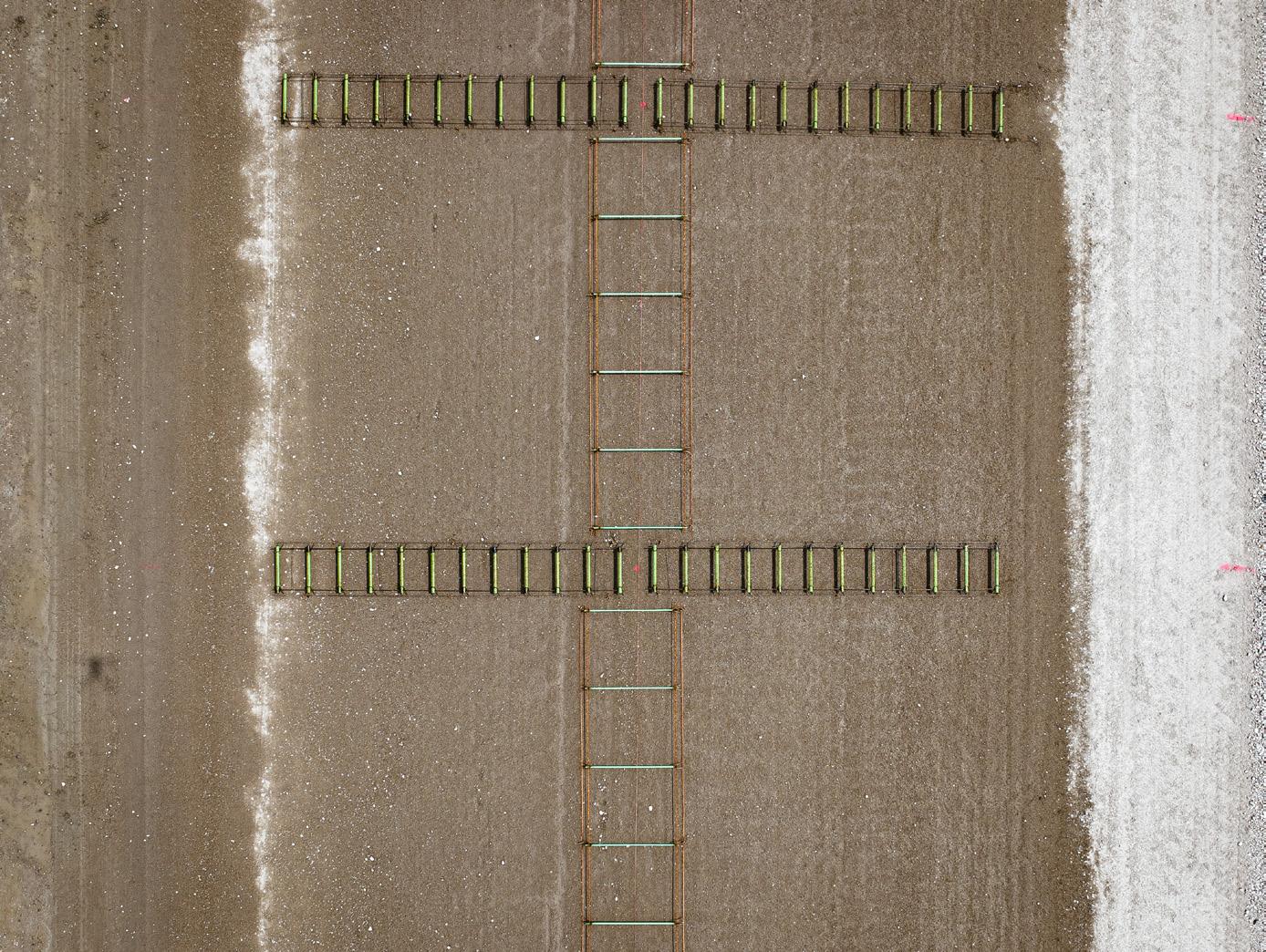
AutoPilot 2.0 control system or highway-speed road scans to create 3D models, project managers invest in tools, so their team has a windshield view during each paving pass.
Check out ways roadbuilding teams are precisely paving roads on time and on budget with equipment and technology.
Choose Pavers With Versatility
During the last two years, OEMs have released slipform or offset pavers with more width versatility. With this ability to set the width to each road’s specific needs, OEMs have also extended the operator’s platform. For example, operators say Wirtgen’s SP15i platform allows them to see the feeding system, transfer hopper and inside of the consolidation compartment of the mold. This expanded view and width allow operators to set the paver for each project accurately and better see its work.
At World of Concrete, I spoke with Ben Claunch, project superintendent at Sunroc, a heavy construction company building roads in the mountain region. He shared why his
team upgraded from the SP15i to the SP25i.
Claunch said that his team is more than happy with their SP15i compact slipform paver and will still use it on future paving sites. However, Claunch decided that the latest model’s benefits could make a difference in the coming season.
He said both models have good maneuverability, tight turning angles and flexibility. However, the SP25i can pave roads up to 6 feet, 7 inches thick, and concrete surface widths up to 12 feet. His team will be paving in different cities this year, and he wants the ability to pave to the project’s specs based on that region’s environmental factors, like average temperature, moisture and frost levels.
Where Did All the Strings Go?
This season is the watershed moment: stringless paving is no longer the anomaly but is becoming the norm on many jobsites. Project managers say stringless paving dramatically reduces hazards and improves safety. In previous years, roadbuilders would stake out strings so the paver would follow a straight line and compact
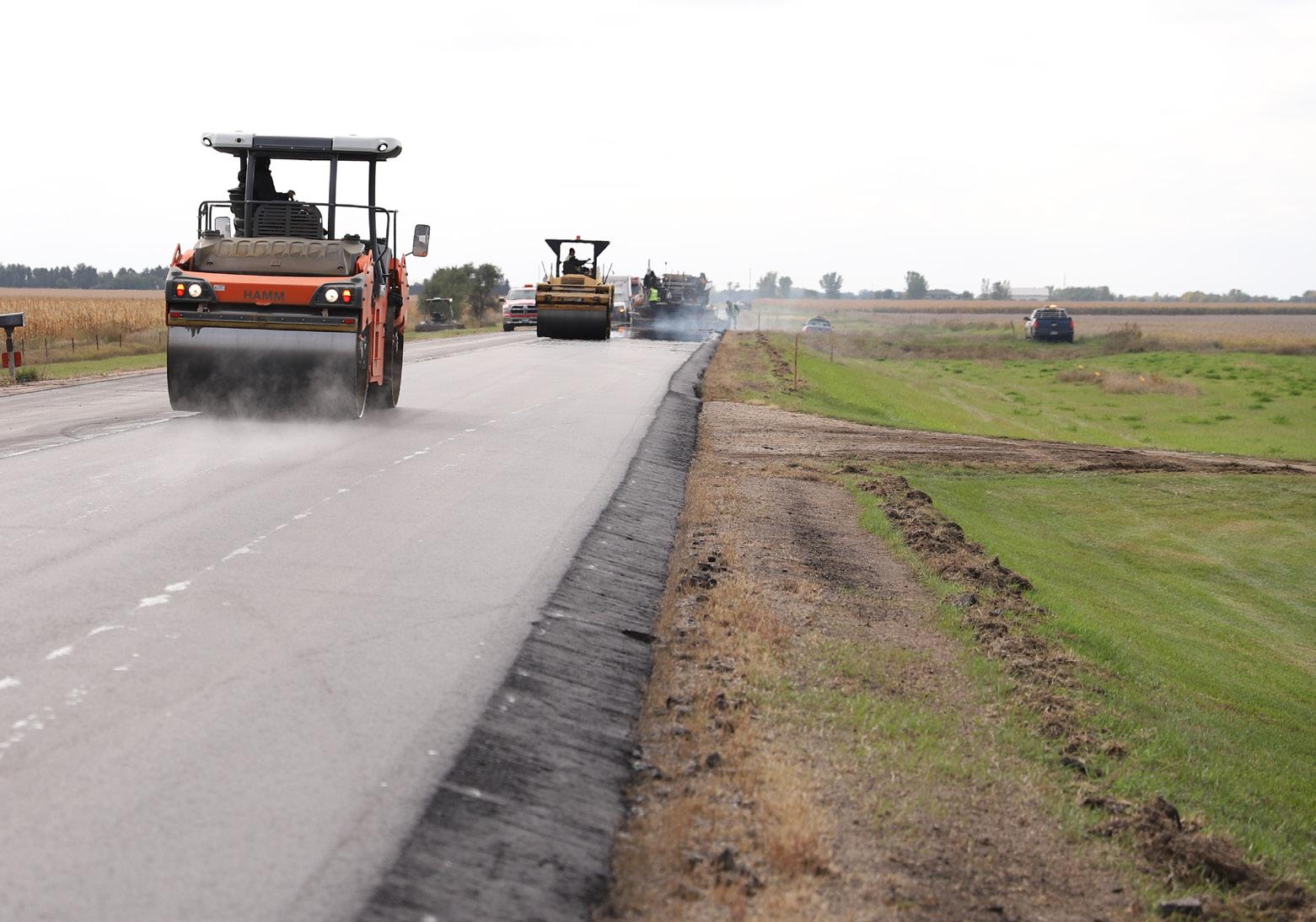
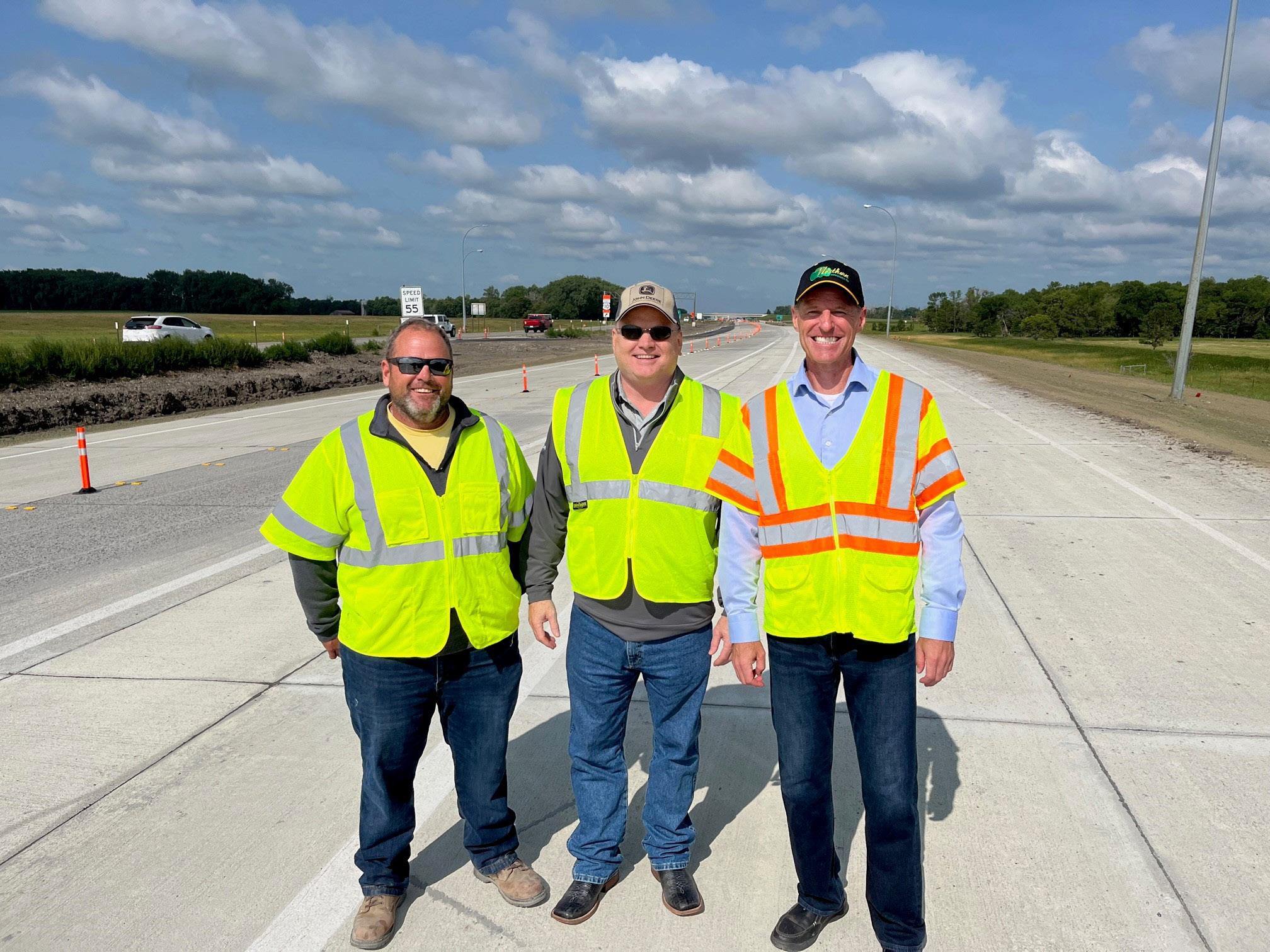
the concrete to the correct grade and width. Today, sensors and GPS technology precisely guide paving equipment without needing physical string markers.
Northern Improvement Company—a North-Dakota-based heavy, highway, and municipal construction company—has embraced stringless paving. Greg McCormick, Northern Improvement president, said that the company started onboarding the stringless paving system a few years ago.
On a North Dakota Department of Transportation project, McCormick said stringless paving significantly improved safety as the team reconstructed 6 miles of Interstate 94. Without strings, the team reduced hazards for laborers and improved the efficiency of haul trucks to deliver concrete, so the WPS 102i concrete placer continuously operated.
Scan Roads at Highway Speeds
When roadbuilders must ensure that their team achieves the right compaction rate as they quickly resurface a road, they turn to intelligent paving systems. Last year, Topcon introduced an intelligent paving system, a 3D scanning, modeling and automated machine guidance system (AMG) to capture a detailed road model using a vehiclemounted scanner capable of collecting data in live traffic at typical highway speeds.
For Pavement Recycling Systems (PRS), the intelligent paving technology provided the team with the necessary tools to complete Highway 52’s emergency repair job in California. After the road was deemed unsafe for drivers due to
potholes, Ben White, Topcon product manager for RDO Equipment Co. and former PRS technology manager, used his knowledge of paving plus the intelligent paving system technology to help.
White and PRS team members entered the engineer’s 3D model which included the highway’s optimized smoothness, grade and thickness for the environment, into five milling machines. Each milling machine was outfitted with AMG, a form of automated machine control. The five milling machines simultaneously milled the road’s old asphalt into uniform material so it could be repaved in one pass with precision. In the end, PRS completed the project in a single weekend with a 70% road smoothness increase from its previous state.
Early Adoption
Roadbuilding teams will likely be early adopters of equipment and technology to meet the increased demand to build durable roads without increasing material or labor costs. By focusing on rework elimination, project managers have partnered with equipment experts to empower their operators with a holistic view of the project.
With simple equipment upgrades to complex technological advances in machine control automation, project managers and operators dramatically decrease production time on machines and emissions to pave in one pass. Accuracy is ensured through each team’s dedication to paving the road toward the future.
Read more at:
eqtoday.co/Dennis0424
April/May 2024 | EQUIPMENT TODAY 41
Operators on Hamm rollers ensure compact and smooth roads.
Dennis Howard at the North Dakota concrete paving site with Northern Improvement Company’s President Greg McCormick and Foreman Ryan Ziegler.
RDO Equipment Co.
The view from above before slipfrom paving.
RDO Equipment Co.
By Charles Rathmann,

Simple Construction Apps to Solve Common Problems
Lightweight apps address specific pain points with minimal disruption and cost.
Contractors are adopting enterprise software—used by multiple departments and professions in the business and sometimes by trading partners— to make construction more efficient, predictable and cost effective and to get more done with fewer people.
This requires executive buy-in, or at least in a smaller company the commitment to drastically change how things are done, as well as a nontrivial budget. Many cell phone apps and light-weight web tools used in construction extend these broader enterprise systems, and it is that connection to the business and other stakeholders in the system that gives them their transformational power.
Here are some standalone, simple apps and web-based tools aimed at solving a single defined problem without the expenditure or the risk of a broad construction enterprise resource planning or other companywide software purchase. Some are even free and none so expensive to likely require approvals from the top.
Apps to Find Construction Employees
A broad construction applicant tracking system can be an essential
tool for many contractors dealing with a protracted labor shortage. However, even before a trade worker applies for a role, straightforward technologies can help fill the pipeline with potential employees. Trade Hounds, for instance, offers contractors a social network where they can compare compensation. The team has plans to launch a job board according to company executives who spoke to ForConstructionPros when the app launched. Home Depot’s Path to Pro portal enables contractors to post jobs for free to more than 24,000 workers available to hire.
An emerging offering, Skillit, seeks to more directly catalog worker skills, preferences and other details in ways that create new hiring opportunities for contractors and construction staffing teams. Skillit provides a simple web application that workers can fill out to showcase their skills, work history, experience, certifications, pay expectations and other details essential for construction recruiters.
Employers get extensive tools that share worker data in innovative ways, including skills assessment scores and in-app messaging to maximize
the opportunity to find and recruit qualified people.
“We are building the largest and fastest-growing network of skilled workers,” Skillit CEO and Founder Fraser Patterson said in a January 2024 interview.
“We capture skill information at a more granular level than anyone has ever done, as well as hiring characteristics, pay aspirations, relocation plans—a complete 360-degree worker profile that makes it easy for employers to select the right workers at the right time.”
This flexibility and the structured nature of employee data in Skillit create new opportunities that go beyond a standard search based on past job titles.
“By capturing worker skills and pay preferences, we enable worker sourcing by exact criteria,” Patterson said. “This enables actual skills-based hiring—instead of using a simple job title or maybe a past employer, all of which we also capture. Individual skills can be used to identify candidates that have not held a title but have the skills to satisfy the role.”
This alone has the effect of enlarging the available talent pool.
“Look at the skills between a welder and a pipefitter,” Patterson said. “There is a 50% overlap or even a 60% overlap and that enabled us to double the size of the candidate pool nationwide for both trades.”
At the time of the interview, Skillit had 30,000 members, up from 1,000 at the beginning of 2023, recently adding up to 1,000 per week in Florida.
Apps for Concrete
A complex specified construction material like concrete benefits from computerized tools to ensure that the mix and volume meet requirements.
Some of these tools will be free.
Sakrete for instance offers the Sakrete Mobile App that offers guidance on mix and the number of bags required for a job. A contractor downloads the app and enters information about the project. Then the app measures the area with a built-in augmented reality tool that works with a mobile device’s camera. The app provides recommendations for specific products along with the number of bags that the job will take.
Concrete Calculator by Inch Calculator performs similar functions for larger and more structural projects
www.ForConstructionPros.com/Equipment 42 EQUIPMENT TODAY | April/May 2024 CONSTRUCTION CONNECTIVITY |
Senior Editor, Construction Technology, IRONPROS
Skillit catalogs worker skills at such a granular level that hiring managers can search by skills that may cross multiple trades and job titles, expanding the available workforce. Skillit
more likely addressed by ready-mix, including slabs, footing, circular columns, poured walls, steps and block walls.
Construction Project Management Apps
Ever since Procore became, perhaps, the first modern softwareas-a-service construction project management application, multiple other offerings have come to market. Like Procore, they offer a variety of apps, but these are enterprise systems.
Fieldwire, HCSS Heavy Job, Buildertrend, Assignar, Raken and others offer field productivity software, encompassing job ticketing, productivity reporting, progress tracking, document sharing, timecards and other functionality for workers in the field on a mobile app.
Gearflow enables contractors to streamline spares, repairs and parts ordering for construction equipment.
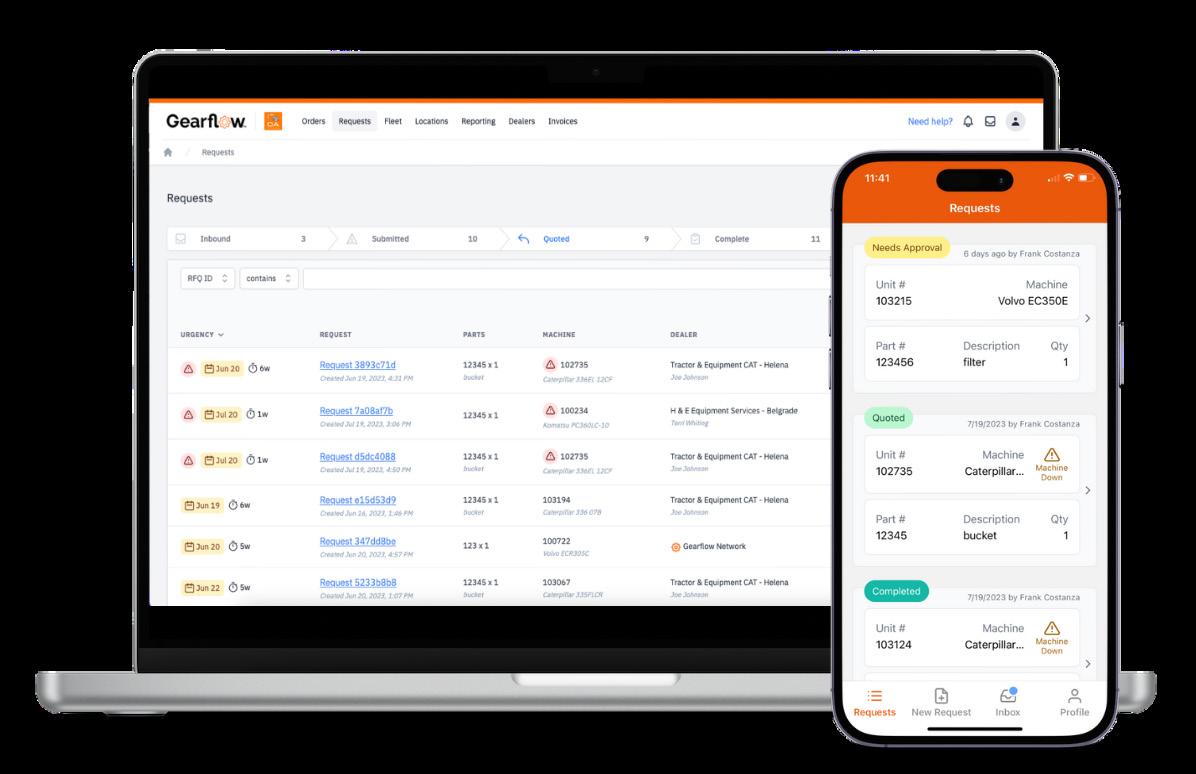
Since these are enterprise systems, they require a budget and some process change across a company.
Then again, lightweight tools are available, like Buildo Construction Diary. This phone app enables a contractor to:
˜ Track workers, materials and equipment
˜ Keep project owners informed about progress on the site with push notifications to prevent missed communications
˜ Track weather data
˜ Attach site photos to the project diary
˜ Export data as a PDF or Excel file, plus data backup to Google Drive Contractors can try the app for free on up to three jobsites and 500 document records.
Portal for Construction Equipment
Spares & Repairs
Equipment-centric contractors live or die by whether their assets are ready to be productive on projects, so efficient parts ordering is essential. Speed is important to limit downtime and competitive pricing is important to control spend.
Gearflow’s Parts Hub Pro is a construction fleet part ordering portal that allows technicians to centralize parts ordering, parts quotes and route purchase approvals with builtin customizable workflows. Basic sourcing is free except for a 3% transaction fee.
Paid plans add more features and enterprise pricing includes
integration with enterprise software for equipment maintenance—an initial integration with HCSS Equipment360 was launched in 2023.
Construction Asset Tracking Tools
Contractors intent on tracking location and operating hours for their tools and equipment can also find straightforward and extremely affordable tools without opting for a full GPS asset tracking and fleet management software suite.
Some of these tools, like Asset Panda, will be suitable for smaller assets and may rely on bar code scanning to record location or custody of a piece of equipment or tool.
Affordable consumer-level tracking devices from companies like Cube Tracker or TilePro can be extremely accessible but are not designed for the rigors of use on off-road equipment. These tools will also not share equipment data in a way that makes sense in a construction environment.
Rooster Asset Tracking is priced within reach of contractors who just have one piece of equipment and is designed specifically for equipment assets. It relies on rugged trackers that can be moved from one piece of equipment to another. They also can capture data from onboard telematics units and relay it, along with sensor data, to a cloud-based application for back-office use.
Construction Photogrammetry Apps
The ability to capture images in the context of physical space helps
contractors visualize a site or even, using machine vision technology, calculate the percentage complete and find variances against a building information modeling file. These applications, from vendors like OpenSpace, Buildots, Cupix, and others may be outside some contractors’ budgets.
Fortunately, free or low-cost photogrammetry software is available, including open-source tech like Colmap, MicMac and the proprietary Agisoft. Matterport, which has a growing roster of construction customers, offers a free version that captures imagery and measurements. The imagery can be used to create 3D renderings.
Construction Site Logistics Tool
On a large or complex jobsite, marshalling the arrival of equipment and materials presents a challenge. Often, no central repository of information on where deliveries should go, when they are arriving or what resources are required to unload is available.
To complicate things, the site may have its own address, but the specific location where deliveries need to go onsite, the route to be taken and other information may fall between the cracks. This causes delays, confusion and non-value-added work for contractors. PLOT is a tool for jobsite coordination that streamlines:
˜ Deliveries to project sites, including requested delivery windows, detailed directions within the site
and automated updates to the supplier if delivery time or location have changed
˜ Site details to suppliers including navigation to or within the site and weather at the project location, all shareable with a QR code or link
˜ Crew coordination through tools for inter-company collaboration, and for limited users, jobsite alerts across a number of platforms
“The Logistics Mapping module of PLOT is available for free,” PLOT Founder and CEO Chris Callen said.
“The tool is used in lieu of a traditional logistics plan PDF and allows project teams to create a jobsite portal akin to a Yelp page for your jobsite.
“General contractors can add jobsite locations like gates, laydown areas or docks and equipment like tower cranes and pumps, and share with trade partners and vendors.
General contractors set dates and time availability so every phase of the jobsite’s logistics can be managed in one place. The PDF export is embedded with hyperlinks so no matter how old the PDF or printout is, it connects to the current version of the jobsite through the portal.”
Read more at:
eqtoday.co/ConstrConnect0424
www.ForConstructionPros.com/Equipment April/May 2024 | EQUIPMENT TODAY 43
Gearflow
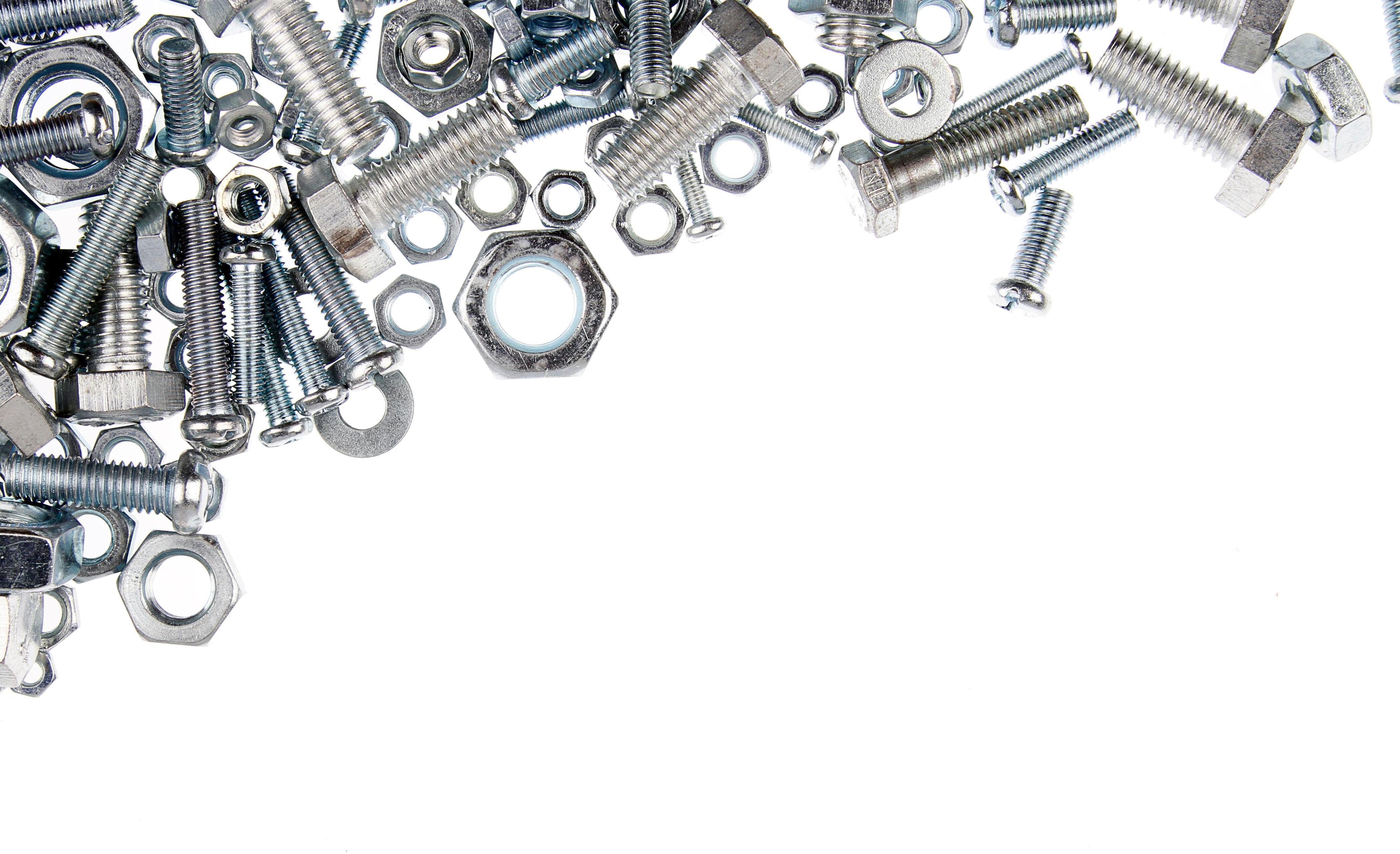

THE FLEET OWNER’S GUIDE Getting the Viscosity Right -
Every fleet owner should know the basics about the viscosity of the lubricants they are using and why the viscosity matters. Fleets—especially mixed ones—require a variety of lubricants. This ranges from hydraulic oils, gear oils, engine oils, and even greases. Each of these has its own viscosity. Some pieces of equipment may even require different viscosities.
For instance, a loader may require an ISO VG 32 hydraulic oil while a crusher may need an ISO VG 46 hydraulic oil. Does it really matter if we use those grades? Yes, it matters! Using the wrong grade can affect the performance of your equipment or lead to breakdowns, which directly impacts the quality of work or availability of your fleet.
In this column, we will do a deep dive into understanding a bit more about the viscosities of lubricants that fleet owners usually handle and decipher the need for the wide range of viscosities that exist in their fleet. We will also explore potential ways to get the “right” viscosity during challenging times.
What Is Viscosity & Why Does It Matter?
For anyone who has seen the packaging of lubricants, the one
thing that is consistent with the labeling is that the viscosity of the oil is mentioned. But why is this so important? Oil is oil, right? No, definitely not! Let’s use an example to get our fundamentals aligned.
We can start by making a sandwich. We have two slices of bread, on one side, we can spread some peanut butter.
It takes a little effort to spread that peanut butter. It is a bit thick and once spread, it covers the bread completely—no bread showing at the surface. Now, if, for some strange reason, you wanted to use garlic-infused oil to spread on the other side of the bread, this would not take as much effort. The oil is thinner and once applied to the bread, we can still see parts of the bread peeking out.
Let’s relate this to viscosity. The peanut butter is more viscous than the garlic-infused oil. Viscosity is the measurement of a liquid’s resistance to flow—it takes more effort to spread the peanut butter than the oil. Viscosity can also be defined as the internal friction within the oil that resists its flow. If we turned a jar of peanut butter upside down, it would not move, but the oil would. Viscosity is also defined as the shear stress (pressure) to shear rate (flow rate).
A more viscous fluid will cover the asperities on the inside of the equipment—these are the microscopic peaks on a material, similar to the pieces of bread that are exposed after applying the peanut butter or oil. However, it will take more work to move the knife over the bread to spread the peanut butter compared to the oil. While a more viscous lubricant can protect the materials, it may not be what is required by the machine.
In essence, peanut butter is more viscous than oil if we’re thinking about food-related items. Before we go further, we need to understand the different grades of viscosity that exist and how to identify them for the different types of lubricants.
Viscosity Grades
It is easy to get confused with the number of viscosity grades that exist, especially for fleet owners. Figure 1 gives a general summary of the types of viscosity grades, and it can also be used to loosely convert one grade to another (based on a viscosity index of 95).
As seen in Figure 1, viscosity can be measured in different ways. There are two ways to measure viscosity; namely dynamic (or absolute) and kinematic.
The dynamic viscosity measures
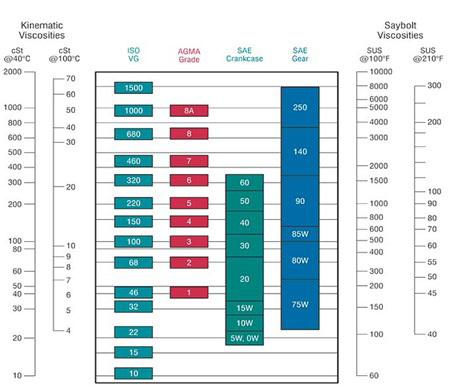
Figure 1. Oil viscosity conversion chart from https:// oilviscositychart.com/calculate/ convert.php
the force required to overcome fluid friction in a film and is reported in centipoise (cP) or in the International System of Units (SI) units pascal-seconds (Pa s) where 1 Pa s = 10 poise (P). Dynamic viscosity can also be considered the internal friction of a fluid. This is usually used for calculating elastohydrodynamic lubrication as it relates to rolling element bearings and gears.
On the other hand, the kinematic viscosity of a fluid is the relative flow of a fluid under the influence of gravity. Its unit of measure is centistokes (cSt) which in SI units
44 EQUIPMENT TODAY | April/May 2024 www.ForConstructionPros.com/Equipment
SANYA MATHURA MANAGING DIRECTOR, STRATEGIC RELIABILITY SOLUTIONS LTD.
Over the years, fleet owners may have realized that the viscosity of engine oils has been slowly getting lower compared to the 15w40 (or straight 50s) used around 40 years ago.

is mm 2 /s: 1 cSt = 1 mm 2 /s. (Mang & Dresel, 2007)
Kinematic viscosity = dynamic viscosity/density
As seen in Figure 1, kinematic viscosity can be measured at 40°C or 100°C, what’s the difference?
Engine oils, axle and transmission oils are usually measured at 100°C while industrial fluid oils ( such as hydraulics, gears and circulating oils) are measured at 40°C.
There are also different grading systems for various applications as well. Gear oils can be graded using the American Gear Manufacturer’s Association (AGMA) grade or ISO
grade. Using the chart in Figure 1, it is easy to convert between the two systems.
Engine Oils—The Lower the Better?
Over the years, fleet owners may have realized that the viscosity of engine oils has been slowly getting lower compared to the 15w40 (or straight 50s) used around 40 years ago. What’s the main reason for this change? Engines have gotten smaller over time with more power.
For instance, 40 years ago, there were larger engines, but with these larger engines, there were bigger lines to transport the oil around the engine. As technology evolved,
original equipment manufacturers (OEMs) began to create smaller engines that were more powerful. As a result, thinner oil lines were used which meant that lower viscosity oils had to be used to achieve the required pressures and flow rates.
Imagine using a straw to drink a thick liquid like molasses. A wider straw might be able to suck up the molasses, but a thinner straw would require a lot more effort by the person drinking.
If we liken that to an engine, then the pump is under a lot more strain to get the higher viscosity of oil to the parts where it needs to go. This is one of the main reasons
why oil leaks usually begin at the seals around the oil pump for engines using the wrong viscosity of oil. Hence, lower-viscosity oils are needed for these new engines to reduce the amount of strain on the pump and get the oils to the required areas.
While a straight 50 monograde would have worked on a diesel engine 40 years ago, it simply will not provide the protection that a modern engine requires. This is where the advent of multigrade oils has also been able to assist in protecting the engines.
On startup, a multigrade oil can move from the bottom of the
April/May 2024 | EQUIPMENT TODAY 45 www.ForConstructionPros.com/Equipment LUBRICATION NUTS & BOLTS
@Ivan - adobe.stock.com
sump to the top faster than that of a monograde oil, which helps reduce the amount of wear on startup.
For fleet owners, being able to consolidate engine oils can also help manage storage and handling as well as costs (if bought in bulk). Knowing the OEM specifications and guidelines for your pieces of equipment is important before undertaking the role of consolidation for these oils.
Thankfully, most diesel engine oils conform to the American Petroleum Institute specification, which is backward compatible. This means that if an oil needs to meet a CI-4 spec, using a CJ-4 spec, within the same required viscosity grade, would be acceptable.
For mixed fleets, understanding this aspect can help consolidate the oils and possibly move to a semisynthetic oil across the fleet that can aid in improving fuel efficiency and lowering some overall costs.
Lower viscosity oils are here to stay and fleet owners should begin the conversation with their OEMs about consolidating their fleets to make them more efficient and help improve their overall fuel efficiency using these lower viscosity oils.
Hydraulic & Gear Oils—Which Grade Should Be Used?
Apart from engine oils, hydraulic and gear oils are the second and third most used type of oils for fleet owners. It can be a bit perplexing when the hydraulic grades run from ISO VG 15 to 32 to 68 or 100 depending on the application. Of these, the ISO VG 32 seems to be the most popular hydraulic grade, but this doesn’t mean that this grade should be used for everything!
Hydraulics are used for precision applications and need to be very clean because of the tight tolerances in which they operate. As such, it is critical that the correct viscosity is used for these oils.
They are rated using the ISO scale that appoints a mid-range number and uses it as the assigned grade.
Each grade has a range of ±10%. For example, an ISO VG grade of 46 can be classed within this grade if it falls within the limits of 41.4 to 50.6 cSt. This is important to note especially when trying to consolidate hydraulic oils. The chart below shows different viscosity grades for the hydraulic oil, Shell Tellus S2V oil.
As seen in Figure 2, the viscosity of an ISO 15 grade hydraulic oil (black line) at 40°C varies greatly from that of an ISO 100 grade hydraulic oil at the same temperature (red line). For instance, at 40°C, an ISO VG 15 is 15 cSt while an ISO VG 100 is 100 cSt.
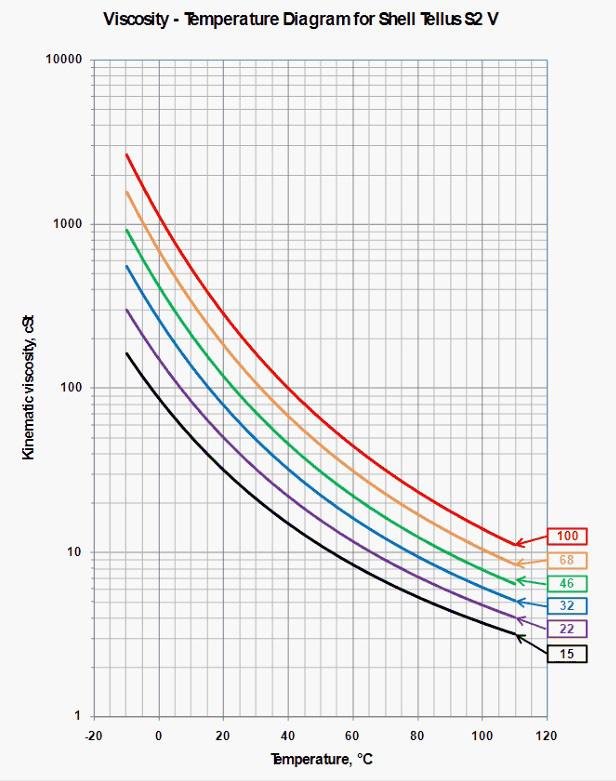
However, all the oils have a viscosity of 100 cSt, but at varying temperatures, ISO VG 15 exists at 100 cSt around -3°C while an ISO VG 22 exists with this viscosity at 7°C and an ISO VG 32 exists at 15°C.
As a result, you should understand the temperature at which your equipment is operating before selecting the appropriate viscosity grade. Typically, this information can be found in your user manual under the lubrication section. It is also critical to consult with your OEM and lubricant supplier before making decisions on consolidating oils.
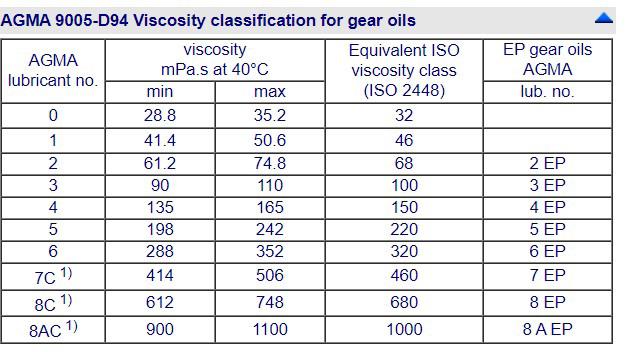
In these instances, people often tend to switch to a heavier grade of oil hoping that it will still offer the protection they need without compromising the efficiency of their equipment.
But does this mean that the entire sump must be drained before adding this heavier viscosity? Or what will the new viscosity be with these two viscosities now coexisting in the sump? This is where the Widman viscosity calculator adds some value.
This calculator allows operators to enter the viscosity of the two oils to be mixed as well as the percentages of their mixture and of course their operating temperatures. With this information, one can easily calculate the resulting viscosity.
For the first example, if our sump had an ISO 68 oil in it and we needed to top up the oil but there were no more ISO 68 oils available, what could we do? If an ISO 46 oil was available, then we could potentially top up with this oil to achieve the required viscosity. But how much oil would we need?

Figure 4. Mixing two oils (ISO 68 at 70%)
We can use the calculator to find out (see Figure 4). In this case, I placed the ISO 68 sump at 70%. This resulted in a value of 60.32 cSt which is just outside the ISO 68 range of 61.2 cST to 74.8 cSt.
In this case, we cannot top up with 30% of the ISO 46 oil.

Figure 6. Mixing of two oils (ISO 68 at 90%)
If, however, we used a top-up of 10% of the ISO 46 oil, we fall a bit closer within the range with a value of 65.32 cSt
In this case, the top-up of 10% will keep our equipment running within the required viscosity until we can procure an ISO 68 oil for our machines.
One must note that when mixing oils, OEMs should be consulted. It is also critical to stay within the same family of lubricants because this increases the likelihood of compatibility between the two mixtures. It is NOT advised to mix lubricants of different brands or families (gear oil with hydraulic oil) because incompatibilities may negatively impact your system.
Understanding and assigning the correct viscosity to your equipment is just one step on your journey toward achieving greater efficiency and reliability for your fleet. The viscosity of a lubricant is important and can affect your productivity directly if not taken seriously. Let viscosity be your guide in achieving lubrication excellence for your fleet.
REFERENCES
˜ Mang, T., & Dresel, W. (2007). Lubricants and Lubrication.
Weinheim: Wiley-VCH.
˜ Viscosity Classifications (January 27, 2024). Retrieved from https:// www.tribology-abc.com/abc/ viscosity.htm.
As stated earlier, there is a range within which viscosities can be classified. As seen in Figure 3, an AGMA Grade 5 translates as an ISO Grade 220 VG.
This is a useful chart for those who may be more familiar with the ISO VG grades but receive gear lubricants that have been classified using the AGMA system.
Can I Mix Viscosities?
Challenges can often occur within the field, and there may be instances where the required ISO VG grade is simply not available—either from the supplier or the stock room. Can another grade be used instead?

Figure 5. Mixing of two oils (ISO 68 at 80%)
Let’s try for a sump size of 80% instead, which results in a viscosity of 62.76 cSt which barely falls within the ISO 68 range (61.2 cST to 74.8 cSt) (see Figure 5).
Read more at: eqtoday.co/LNB0424
Figure 3 gives a better understanding of the relationship between the ISO VG and the AGMA grades for gear oils.
46 EQUIPMENT TODAY | April/May 2024 www.ForConstructionPros.com/Equipment LUBRICATION NUTS & BOLTS
Figure 2. Viscosity-Temperature chart for Shell Tellus S2V
Figure 3. AGMA versus ISO grades for gear oils (Viscosity Classifications, 2024)
Potential Money for You

Pending tax changes may put cash in your pocket.
You know what they say:
“Even a blind squirrel can find a nut once in a while.”
Based on some expected tax changes coming down the line, you may be that squirrel.
I just received a review of pending tax changes that I have been told will become law for 2023 and 2024. And when they do, many contractors will have the opportunity to amend their 2023 tax returns and receive additional benefits that could reduce 2024 estimated tax payments.
Pending tax changes that will become law for 2023 and 2024 may give many contractors the opportunity to amend their 2023 tax returns and receive additional benefits that could reduce 2024 estimated tax payments.
The changes deal with:
˜ Bonus depreciation
˜ Section 179 write-off
˜ Interest expense limitations
˜ Independent contractor status.
Bonus Depreciation
The Tax Cuts and Jobs Act (TCJA) allowed bonus depreciation starting September 27, 2017, and before January 1, 2023, through 2022. After 2022, bonus depreciation was to phase out at 20% per year, meaning the 2023
bonus would only be 80% of qualified purchases, 60% for 2024 and so on through 2027. After 2027, you return to your normal tax depreciation, meaning that the tax benefits received because of equipment purchases are materially less than what you had compared to 100% bonus depreciation, which is a big difference regarding cash flow.
The proposed change is to reinstate 100% bonus depreciation through January 1, 2026, making it possible to use a 100% bonus for 2023, 2024 and 2025.
Therefore, contractors that based their 2023 estimate payments figuring an 80% bonus will find it will become a 100% bonus, which may create a refund on the 2023 tax return because you paid more than you had to.
If you were estimating your 2024 estimated tax liability using a 60%
bonus, you can now revise that estimate and base it on a 100% bonus, which means newfound cash in 2023 and a tax saving in 2024.
Section 179
Section 179 is amended to increase the limit on depreciable business assets expensing. For property placed in service after December 31, 2023, taxpayers can expense up to $1.29 million, reduced by the amount of the cost of the qualifying property more than $3.22 million, adjusted for inflation. In short, you can expense more in 2023 because they increased the limit.
Business Interest Expense
Regarding the business interest limitation, the proposal extends the use of earnings before interest, tax, depreciation and amortization to
April/May 2024 | EQUIPMENT TODAY 47 www.ForConstructionPros.com/Equipment RUNNING THE BUSINESS
godshutter. AdobeStock
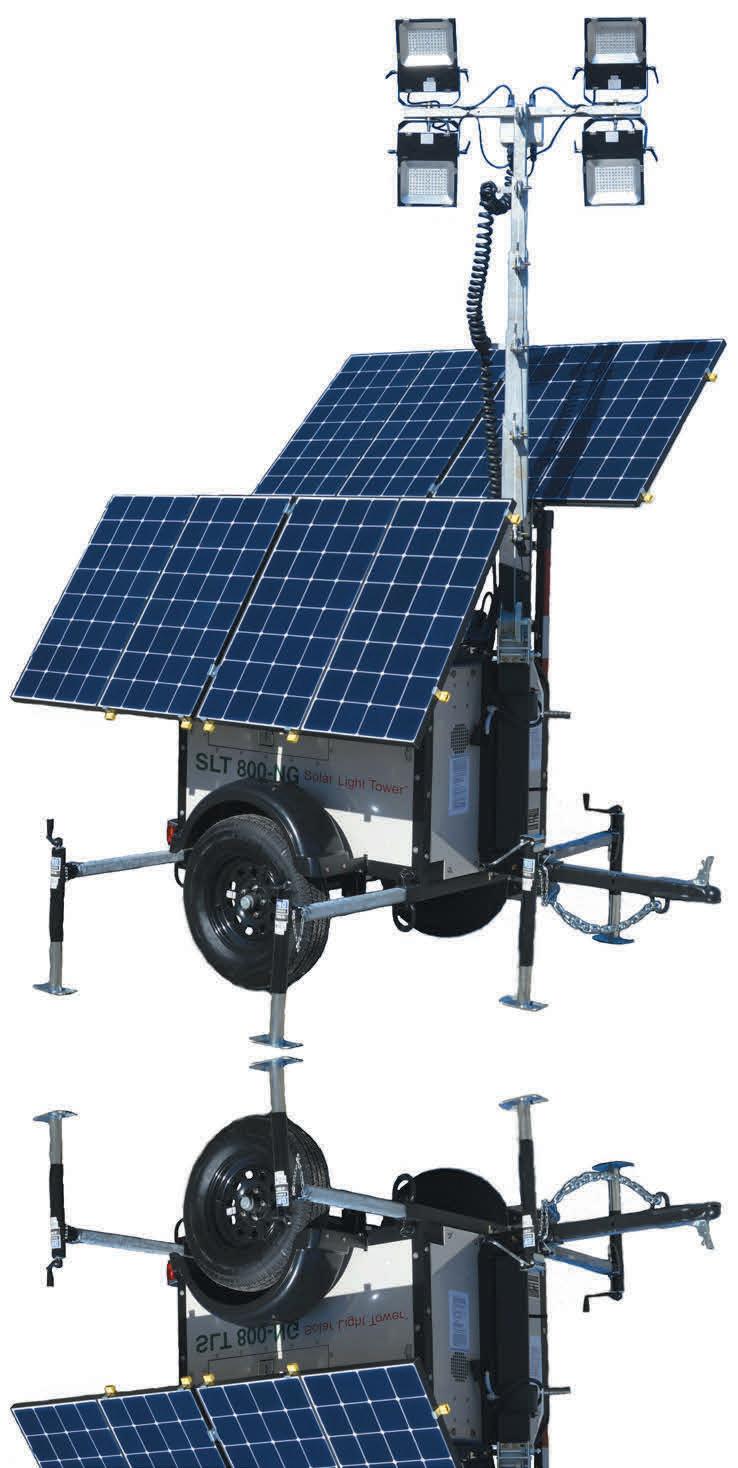
RUNNING THE BUSINESS
calculate the deduction for business interest. This applied for tax years after December 31, 2023, and will run through 2025.
Using my blind squirrel example, these tax benefits are generated for taxpayers who made estimated tax payments for 2023 and had enough taxable income to produce a new source of unanticipated cash. The same goes for making estimated tax payments for 2024, which can be reduced since your estimated tax deductions are higher. Taxpayers who do not get immediate tax benefits could generate either a carryback or carry-forward benefit. Said another way, you must have taxes to pay to get the benefit.
Independent Contractor Status
If you have independent contractors working for your company, things are about to get more complicated because the IRS has tightened its definition of an independent contractor to the point that it will be tough to comply with.
˜ Any opportunity for profit or loss a worker might have.
˜ A financial stake or resources the worker has invested in the work.
˜ The degree of permanence of the work relationship.
˜ The degree of control an employer has over the person’s work.
˜ Work that is essential to the employers’ business.
˜ A factor regarding the worker’s skill and initiative.
The IRS is looking for payroll withholding and payroll taxes that they receive from employees and employers. They are also looking at base pay, overtime requirements and benefits that may be due to an employee.
Since contractors are not “employees,” they are not included when calculating worker’s compensation and liability insurance profiles used by insurance companies to calculate a premium. Consequently, contractors should provide an insurance certificate to the employer to avoid insurance gaps should an incident occur. After reviewing this issue, I can only say that I see a ton of exposure if you guess wrong.
We all know that contractors need “subs” to work on their projects, but if you are issuing 1099s at the end of the year, review what you are doing to avoid potential tax and penalty expenditures.
One More Thing
This last issue relates to the independent contractor issue and shareholders using the LLC format. If you receive distributions from an LLC, you must document why you do not have to pay payroll taxes on those distributions. If you work in the LLC to generate the profits that are being distributed, the distribution may not be investment income where zero payroll tax is required. If not considered investment income because you are only a limited partner in name only, the selfemployment tax rules apply, and you must pay payroll taxes on the earnings.
Keep these thoughts in mind and make sure to check if there are “nuts” out there that you can deposit into your checking account. If you participated in major acquisitions in 2023 and have plans to do so in 2024, these changes could smooth out your cash position in 2024 and beyond.

www.ForConstructionPros.com/Equipment
Bartecki is managing member of GB Financial Services LLP and a consultant to the Independent Equipment Dealers Association. MATURE TECHNOLOGY SIMPLE OPERATION PROVEN RUGGEDNESS w.ProgressSolarSolutions.com Sales@ProgressSolarSolutions.com p.888-298-6657 1108 N New Hope Rd, Raleigh, NC 27610 Use Mobile Solar Light Towers!
of paying for diesel and delivery costs?
Read more at: eqtoday.co/RuntheBus0424 Garry
Tired
There are six factors to determine if a person is an independent contractor:
How to Overcome Workforce Challenges in 2024

Understand the key strategies to overcome workforce challenges in the construction industry in 2024.
Expanding your talent pool doesn’t just involve attracting experienced professionals.
It’s a new year, and we are facing the same workforce challenges.
Think back to 2023—how often did you hear the following: “I’ve got more work than I know what to do with, but nobody to do it”? Or maybe, “I can’t find good help to save my life; these days everyone is just chasing dollars.” Or worse, “Nobody wants to work anymore.”
It’s a new year, but our industry kicked off 2024 facing the same, age-old workforce challenges—the demand for skilled labor far exceeds the supply. Faced with limited time, resources, and insight into today’s job seekers, many companies begin to feel stuck. They’re painfully aware that the old tactics no longer work but are unsure of what needs to change.
We have witnessed this pattern repeated for the last five years. Many of the best companies in America grapple with workforce challenges, some more successfully than others.
The 2023 Ariat Dirt World Summit brought together 750 construction industry leaders from across the country, and the overwhelming focus of their conversations was—you
guessed it—solving workforce challenges.
There are companies out there that are seemingly unaffected by workforce trends and don’t have a people problem, but it’s not because they got lucky.
They’re taking some key actions, and we’ll share them here.
April/May 2024 | EQUIPMENT TODAY 49 www.ForConstructionPros.com/Equipment BRIDGING THE GAP
BuildWitt
Hiring Won’t Fix the Problem
As an industry, we’ve gotten used to the words “workforce shortage.” While it’s true there is a looming shortage, The National Center for Construction Education & Research has estimated that 41% of the current construction workforce will be retired by the year 2031—the struggle most contractors face currently isn’t hiring but retaining their existing employees.
Hiring is an understandable response because it’s actionable, easy to quantify and places the focus on the employee rather than the employer. This leads to the notion that “nobody wants to work anymore.”
However, the truth is that building a robust and sustainable team goes beyond recruitment. It hinges on retaining the invaluable talent already in your ranks.
Retention, the basic act of keeping your skilled workers within your fold, is the cornerstone of a stable and productive workforce. It’s not just about filling gaps but about ensuring that those gaps don’t appear in the first place.
A revolving door of employees can be expensive and disruptive to projects and company culture.
In a recent poll of our followers on social media, construction workers aged 20 to 35 revealed that nearly 50% had changed jobs in the past two years. The reasons behind these job changes are as diverse as the industry itself and include:
• Sought better pay
• Entered new phases of life, requiring more time at home
• Sought a company invested in employee growth and training
• Fled bad leadership or simply felt undervalued
What’s significant is that the demand for skilled workers in construction has reached an alltime high, giving today’s workforce newfound leverage.
Workers now understand the power of saying “no” to unfavorable work environments—those that don’t meet the requirements listed above.
It’s now the job of employers to make their companies worth saying “yes” to.
While money is an important part of the equation, other less tangible factors are at play. To attract highvalue workers in today’s job market, it’s no longer sufficient to offer competitive wages alone. Construction companies must craft environments where employees feel valued, respected and empowered.
But it doesn’t end there. A culture of respect and empowerment will help get discerning applicants through the doors of your company.
For them to stay and invest in the company long-term, they need a clear vision of what their career could look like.
Give Your People a Path for Growth
Imagine this scenario: you’ve managed to hire your dream employee, and they show up to work on day one eager to contribute their skills and knowledge. They’re assigned their first task and quickly get the hang of it. Soon they’re showing interest in more advanced parts of the operation.
This is exactly the kind of employee you’ve been hoping to find. This individual is going somewhere, the only question is: how far? If the answer isn’t clearly laid out within your company, what choice does that individual have but to look for it somewhere else?
To retain valuable individuals, it’s imperative to lay out a roadmap for their growth within your organization. This path should be illuminated with opportunities for skill enhancement, leadership training and career progression. By investing in your employees’ development, you not only increase their job satisfaction but also foster a sense of loyalty and commitment.
Do NOT Underestimate Training
According to one of our surveys of more than 600 dirt world workers, “more training and learning opportunities” ranked second on a list of factors that would most increase job satisfaction, higher than schedule flexibility, more paid time off and a shorter commute.
The same poll showed a staggering 46% of respondents claiming they receive training once per year or less at their current job. This lack of training across our industry raises a significant concern as it directly impacts job satisfaction and employee retention. It also highlights a golden opportunity for employers to step up their training game.
Employee Growth Can Help Your Company Operate Better
Consider this: companies that prioritize employee development and offer a structured path for growth often outperform their competitors. They create a workplace where individuals are encouraged and incentivized to reach their full potential—meaning better overall performance.
As you contemplate your workforce strategy for 2024, remember that giving your people a path for growth isn’t just about retaining talent but also ensuring the long-term success of your organization.
Increase the Size of Your Talent Pool
Imagine your workforce as a sturdy bucket. In years past, the water you poured in often flowed right through the holes, representing high turnover rates and wasted resources. But you’re

starting 2024 with a renewed focus on retention and growth, you’ve patched up those holes and strengthened your bucket. Now that it’s finally able to hold what you pour in, you want to fill it with good quality water—candidates.
Harness Social Media for Talent Attraction
To fill your bucket, you need to attract talent proactively. This is where social media steps into the spotlight. Social platforms have become invaluable tools for talent attraction, and the statistics speak for themselves.
According to Glassdoor, 79% of job seekers use social media platforms in their job search. Statista reports that 302 billion Americans (93% of the country) actively use social media.
The key advantage of using social media for talent attraction is its ability to reach an audience you might not access through traditional means. By showcasing your company culture, projects and the people who make it all happen, you begin to build trust and credibility. Workers who might not have considered your company— or the industry in general—may begin to see the work not just as a job but as something genuinely compelling.
Be Willing to Hire Inexperienced Candidates
Expanding your talent pool doesn’t just involve attracting experienced professionals. It can also mean hiring less experienced candidates. In many cases, such individuals can bring fresh perspectives and a hunger to learn. These characteristics can be invaluable assets to your team.
When you have a well-defined training path in place, bringing in
As you contemplate your workforce strategy for 2024, remember that giving your people a path for growth isn’t just about retaining talent but also ensuring the longterm success of your organization.
less experienced candidates becomes a viable strategy. You can provide them with the necessary guidance, mentorship and hands-on training to quickly bring them up to speed.
Putting It Into Action
To recap: overcoming your workforce challenges in 2024 depends on retaining the valuable talent you already possess. The first step to retaining is building a people-focused culture that prioritizes growth and backs it up with training. You can expand your horizons by tapping into the vast potential of social media to attract talent and by hiring less experienced candidates who can flourish with the right guidance.
If we first retain our existing workforce, make them more efficient and effective, and strategically attract new talent, we can reduce the need for constant recruitment and the costs involved in those efforts.
The workforce challenges of 2024 can be conquered by empowering your current team, fostering growth and embracing people who are unfamiliar with our industry.
Now, it’s time to put these insights into action. Embrace the change, invest in your people and watch as your construction endeavors reach new heights in the dirt world of tomorrow.
Read more at: eqtoday.co/laborshort
Garrett Simmons is a senior copywriter for BuildWitt.
BRIDGING THE GAP 50 EQUIPMENT TODAY | April/May 2024 www.ForConstructionPros.com/Equipment
BuildWitt
•
• Tires: Eight 215/75R17.5 (H)
• Brakes: Air (Full ABS System)
• Ramps: 72" Long x 22” Wide Range: 102" Max. 29" Min.



Simple,Fast,andConvenient! ONE PIECE CAST LUNETTE EYE Tested @ 275,000# and wrap around nose plate. Standard on all trailers. HEAVY DUTY 2-SPEED PARKING JACK 70,000# static capacity. Standard on all 15-25 Ton trailers. HIGH TENSILE MAIN RAIL One piece and cold formed. CROSS MEMBERS pierced through Main Beam for lowest possible deck height and more unitized frame. ALL WHEEL ABS with Spring Brakes on all axles. Standard on all air brake trailers. ADJUSTABLE 3-LEAF SUSPENSION Standard on all 15-25 Ton trailers. SUMITOMO BRAND TIRES National Dealer Supported. HUB PILOTED WHEELS Outboard brake drums for easier maintenance. APITONG/COMPOSITE DECK Durable Composite Decking is fastened to the crossmembers with bolts and deck washers making it easier to replace decking when required. Eager Beaver WIDE TRACK AXLES: 98” Some Competition - 92” 98” WIDTH 92” WIDTH >> Eage rBeaverTrailers.co m For a quote on any model, please call 800-257-8163 Standard Features On All Easy Loaders 20XPT • CAPACITY: 40,000 lbs. • 20 Ton Air Brakes • 8 Degree Loading Angle Low Profile • Trailer Weight:
Overall
8,380 lbs. •
Width: 102", Length: 31'4"
Deck
Length: 21’ Flat (model shown)
• 6’ Beavertail
• Deck Height: 34"
• Lighting: 100% Sealed Wiring harness and L.E.D. Lights




















































































































































































